D Link IR850LA1 Wireless AC1200 Dual Band Gigabit Cloud Router User Manual Part 1
D Link Corporation Wireless AC1200 Dual Band Gigabit Cloud Router Part 1
D Link >
Contents
- 1. User Manual Part 1
- 2. User Manual Part 2
User Manual Part 1
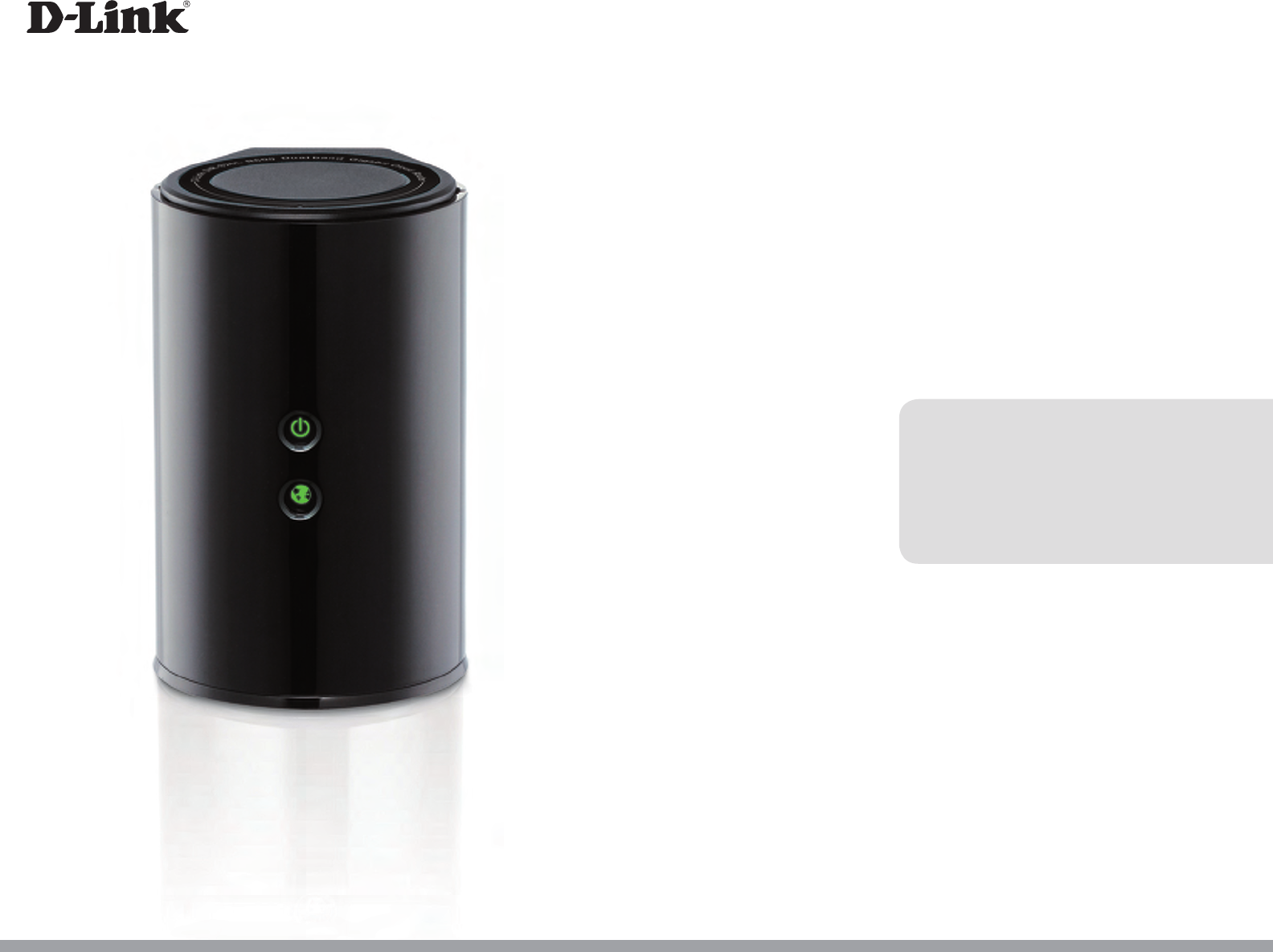
Version 1.0 | 02/04/2013
Wireless AC1200 Dual Band Gigabit Cloud Router
User Manual
DIR-850L

iD-Link DIR-850L User Manual
D-Link reserves the right to revise this publication and to make changes in the content hereof without obligation to notify any
person or organization of such revisions or changes.
Manual Revisions
Trademarks
D-Link and the D-Link logo are trademarks or registered trademarks of D-Link Corporation or its subsidiaries in the United
States or other countries. All other company or product names mentioned herein are trademarks or registered trademarks of
their respective companies.
Copyright © 2012 by D-Link Systems, Inc.
All rights reserved. This publication may not be reproduced, in whole or in part, without prior expressed written permission
from D-Link Systems, Inc.
Revision Date Description
1.0 February 04, 2013 • Initial release for Revision A1
Preface

iiD-Link DIR-850L User Manual
Table of Contents
Preface ................................................................................. i
Manual Revisions ........................................................................... i
Trademarks ...................................................................................... i
Product Overview .............................................................. 1
Package Contents ......................................................................... 1
System Requirements ................................................................. 2
Introduction ................................................................................... 3
Features ............................................................................................ 4
Hardware Overview ..................................................................... 5
Connections ...........................................................................5
LEDs ........................................................................................... 6
Installation ......................................................................... 7
Before you Begin ........................................................................... 7
Wireless Installation Considerations ...................................... 8
Manual Setup .................................................................................9
Conguration ...................................................................11
Quick Setup Wizard ....................................................................12
QRS Mobile App ..........................................................................19
SharePort Mobile App ..............................................................20
Web-based Conguration Utility ..........................................24
Internet Connection Setup .............................................25
Internet Connection Setup Wizard ...............................26
Internet (Manual) ................................................................32
Static (assigned by ISP) ................................................34
PPPoE (DSL) ......................................................................35
PPTP ....................................................................................37
L2TP ....................................................................................39
DS-Lite ...............................................................................41
Wireless connection setup wizard ................................42
Wi-Fi Protected Setup Wizard .........................................45
Manual wireless network setup .....................................46
Wireless Security .................................................................57
What is WPA? ...................................................................57
Network Settings ................................................................58
Router Settings ...............................................................58
DHCP Server Settings ...................................................59
DHCP Reservation .........................................................61
Storage ...................................................................................62
Media Server.........................................................................65
IPv6 ..........................................................................................66
IPv6 Internet Connection Setup Wizard ................67
IPv6 Manual Setup.........................................................72
mydlink Settings .................................................................81
Advanced ...............................................................................84
Virtual Server ...................................................................84
Port Forwarding .............................................................85
Application Rules ...........................................................86
QoS Engine .......................................................................87
Network Filters ................................................................89
Access Control .................................................................90
Table of Contents

iiiD-Link DIR-850L User Manual
Table of Contents
Website Filters .................................................................93
Inbound Filters ................................................................94
Firewall Settings .............................................................95
Routing ..............................................................................97
Advanced Wireless ........................................................98
Wi-Fi Protected Setup (WPS) .....................................99
Advanced Network Settings ................................... 101
Guest Zone .................................................................... 102
IPv6 Firewall .................................................................. 103
IPv6 Routing ................................................................. 104
Tools ..................................................................................... 105
Admin.............................................................................. 105
Time ................................................................................. 106
SysLog ............................................................................. 107
Email Settings............................................................... 108
System ............................................................................ 109
Firmware ........................................................................ 110
Language Pack ............................................................. 110
Dynamic DNS ............................................................... 111
System Check ............................................................... 112
Schedules ...................................................................... 113
Status ................................................................................... 114
Device Info .................................................................... 114
Logs.................................................................................. 115
Statistics ......................................................................... 116
Internet Sessions ......................................................... 117
Routing ........................................................................... 118
Wireless........................................................................... 119
IPv6 .................................................................................. 120
IPV6 Routing ................................................................. 121
Support ............................................................................... 122
Connect a Wireless Client to your Router ....................123
WPS Button ................................................................................ 123
Windows® 7 ................................................................................ 124
WPA/WPA2 ......................................................................... 124
WPS ....................................................................................... 127
Windows Vista® ......................................................................... 131
WPA/WPA2 ......................................................................... 132
WPS/WCN 2.0 .................................................................... 134
Windows® XP ............................................................................. 135
WPA/WPA2 ......................................................................... 136
Troubleshooting ............................................................138
Wireless Basics ...............................................................142
What is Wireless? ...................................................................... 143
Tips ................................................................................................ 145
Wireless Modes ......................................................................... 146
Networking Basics .........................................................147
Check your IP address ............................................................ 147
Statically Assign an IP address ............................................ 148
Technical Specications ................................................149

1D-Link DIR-850L User Manual
Section 1 - Product Overview
Product Overview
Package Contents
Note: Using a power supply with a dierent voltage rating than the one included with the DIR-850L will cause damage and void the warranty
for this product.
If any of the above items are missing, please contact your reseller.
DIR-850L Wireless AC1200 Dual Band Gigabit Cloud Router
Ethernet Cable
Power Adapter
WI-FI Conguration Note
Wi-Fi Conguration Note

2D-Link DIR-850L User Manual
Section 1 - Product Overview
Network Requirements
• An Ethernet-based Cable or DSL modem
• IEEE 802.11ac, 802.11a, 802.11n or 802.11g wireless clients
• 10/100/1000 Ethernet
Web-based Conguration
Utility Requirements
Computer with the following:
• Windows®, Macintosh, or Linux-based operating system
• An installed Ethernet adapter
Browser Requirements:
• Internet Explorer 7 or higher
• Firefox 3.5 or higher
• Safari 4 or higher
• Chrome 8 or higher
Windows® Users: Make sure you have the latest version of Java
installed. Visit www.java.com to download the latest version.
mydlink Requirements
• iPhone/iPad/iPod Touch (iOS 3.0 or higher)
• Android device (1.6 or higher)
• Computer with the following browser requirements:
• Internet Explorer 7 or higher
• Firefox 3 or higher
• Safari 5 or higher
• Chrome 5 or higher
iPhone, iPad, and iPod touch are registered trademarks of Apple Inc. Android is a trademark of Google, Inc.
System Requirements

3D-Link DIR-850L User Manual
Section 1 - Product Overview
Introduction
Now you can monitor and manage your home network right from your laptop, iPhone®, iPad®, or Android™ device. The cloud-
enabled router can be congured to send an email to keep you informed anywhere, anytime when new devices are connecting
to your network or unwanted access is detected. Monitor in realtime websites that are being visited with recent browser history
displayed on the mydlink™ Lite app – which is great for parents. The D-Link Cloud Service can detect and block unwelcomed
guests who try to get into your wireless network and suspicious activities will be displayed right on your mydlink™ Lite app
or browser.
The D-Link DIR-850L is a IEEE 802.11ac compliant device that delivers up to 3 times faster speeds than 802.11n while staying
backward compatible with 802.11a/g/b devices. Connect the DIR-850L to a Cable or DSL modem and provide high-speed Internet
access to multiple computers, game consoles, and media players. Create a secure wireless network to share photos, les, music,
videos, printers, and network storage. Powered by the 802.11ac technology and equipped with six internal antennas, this router
provides superior wireless coverage for larger homes and oces, or for users running bandwidth-intensive applications. The
DIR-850L also includes a 4-port 10/100/1000 Gigabit switch that connects Gigabit wired devices for enjoying lag-free network
gaming and faster le transfers.
D-Link has created SharePort™ technology to bring more exibility to your network. With SharePort™ technology, you can
connect a USB printer and share it throughout your network. You can also share a USB storage device, providing network
storage for everyone to share.
With some routers, all wired and wireless trac, including VoIP, Video Streaming, Online Gaming, and Web browsing are mixed
together into a single data stream. By handling data this way, applications like video streaming could pause or delay. With the
D-Link Intelligent QoS Technology, wired and wireless trac are analyzed and separated into multiple data streams.
The DIR-850L supports the latest wireless security features to help prevent unauthorized access, be it from over a wireless
network or the Internet. Support for WPA™ and WPA2™ standards ensure that you will be able to use the best possible encryption
regardless of your client devices. In addition, this router utilizes Dual Active Firewalls (SPI and NAT) to prevent potential attacks
from across the Internet for the ideal centerpiece for your wireless network in the home or oce.

4D-Link DIR-850L User Manual
Section 1 - Product Overview
• Ultimate Fast Wireless Networking - The DIR-850L provides up to 300Mbps wireless connection in 2.4GHz band,
900Mbps wireless connection in 5GHz with other 802.11ac and draft 802.11n wireless clients. This capability
allows users to participate in real-time activities online, such as video streaming, online gaming, and real-time
audio. The performance of this 802.11ac wireless router gives you the freedom of wireless networking at speeds
3x faster than 802.11n.
• Compatible with 802.11a/g/n Devices - The DIR-850L is still fully compatible with the IEEE 802.11a, 802.11g
and 802.11n, so it can connect with existing 802.11a, 802.11g and 802.11n PCI, USB, and Cardbus adapters.
• Advanced Firewall Features - The Web-based user interface displays a number of advanced network
management features including:
• Content Filtering - Easily applied content ltering based on MAC Address, URL, and/or Domain
Name.
• Filter Scheduling - These lters can be scheduled to be active on certain days or for a duration of
hours or minutes.
• Secure Multiple/Concurrent Sessions - The DIR-850L can pass through VPN sessions. It supports
multiple and concurrent IPSec and PPTP sessions, so users behind the DIR-850L can securely access
corporate networks.
• User-friendly Setup Wizard - Through its easy-to-use Web-based user interface, the DIR-850L lets you control
what information is accessible to those on the wireless network, whether from the Internet or from your company’s
server. Congure your router to your specic settings within minutes.
* Maximum wireless signal rate derived from IEEE Standard 802.11a, 802.11g, 802.11n and draft 802.11ac specications. Actual data throughput will vary. Network conditions
and environmental factors, including volume of network trac, building materials and construction, and network overhead, lower actual data throughput rate. Environmental
conditions will adversely aect wireless signal range.
Features
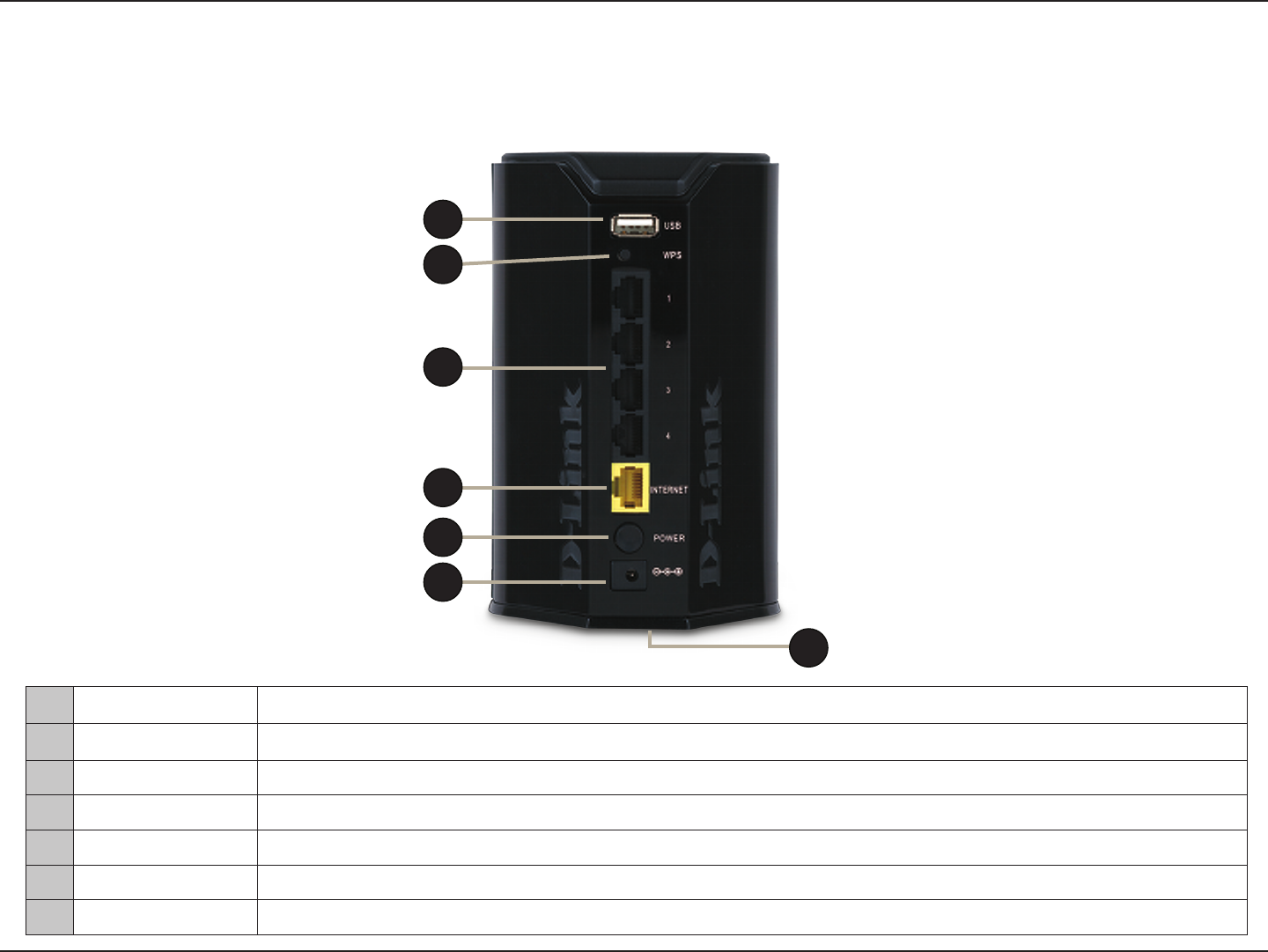
5D-Link DIR-850L User Manual
Section 1 - Product Overview
Hardware Overview
Connections
1USB Port Connect a USB ash drive to share content throughout your network.
2WPS Button Press to start the WPS process. The Internet LED will start to blink.
3LAN Ports (1-4) Connect 10/100/1000 Ethernet devices such as computers, switches, storage (NAS) devices and game consoles.
4Internet Port Using an Ethernet cable, connect your broadband modem to this port.
5Power Button Press the power button to power on and o.
6Power Receptor Receptor for the supplied power adapter.
7Reset Button Insert a paperclip in the hole and wait for several seconds to reset the router to default settings.
1
3
4
5
6
2
7
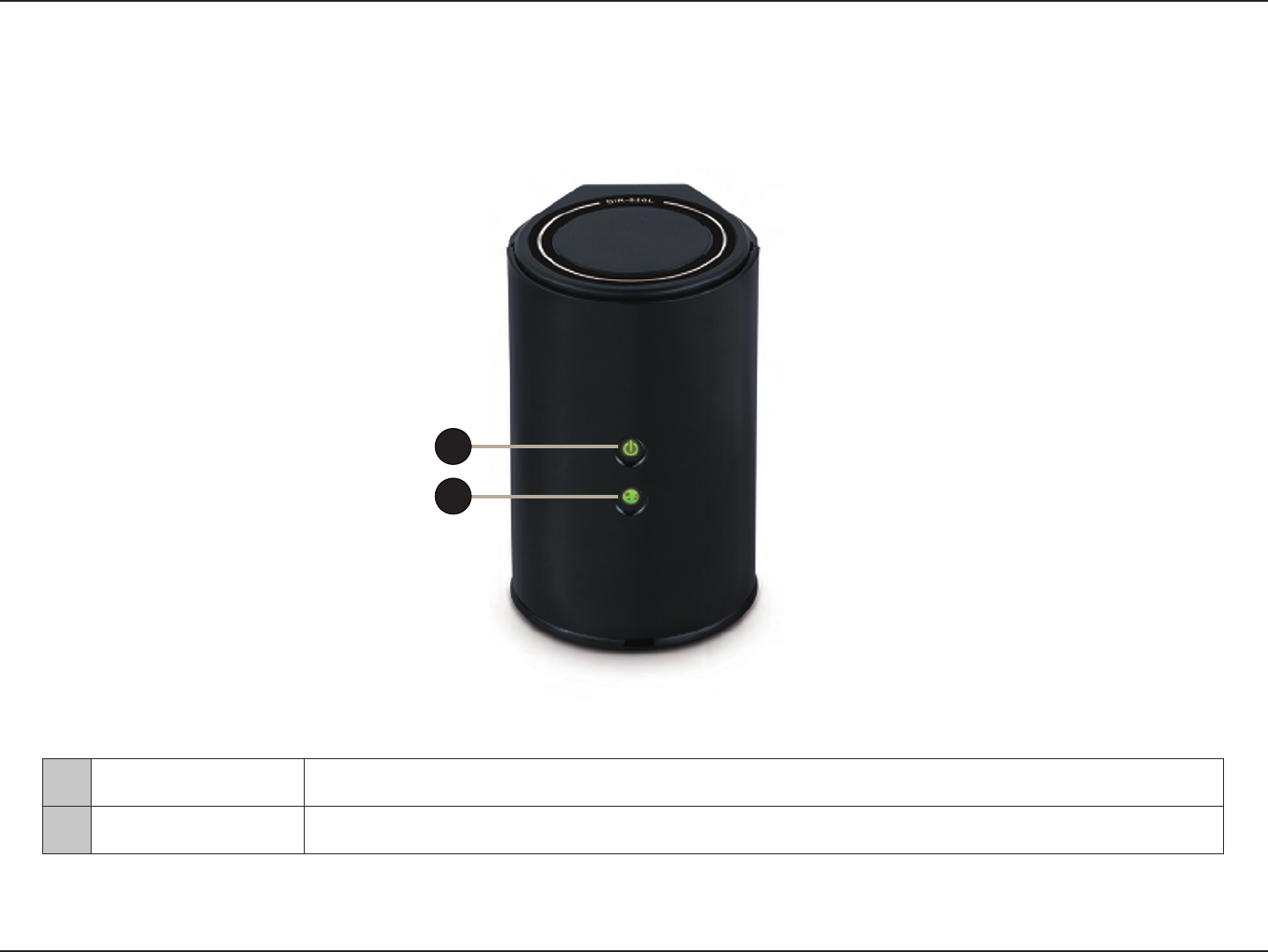
6D-Link DIR-850L User Manual
Section 1 - Product Overview
Hardware Overview
LEDs
1Power LED A solid green light indicates a proper connection to the power supply. The light will blink green during the
WPS process. The light will blink orange during boot up.
2Internet LED A solid light indicates connection on the Internet port. If the LED is orange, the connection is good but the
router cannot connect to the Internet.
1
2

7D-Link DIR-850L User Manual
Section 2 - Installation
Before you Begin
Installation
This section will walk you through the installation process. Placement of the router is very important. Do not place the router
in an enclosed area such as a closet, cabinet, or in the attic or garage.
• Please congure the router with the computer that was last connected directly to your modem.
• You can only use the Ethernet port on your modem. If you were using the USB connection before using the router,
then you must turn o your modem, disconnect the USB cable and connect an Ethernet cable to the Internet port
on the router, and then turn the modem back on. In some cases, you may need to call your ISP to change connection
types (USB to Ethernet).
• If you have DSL and are connecting via PPPoE, make sure you disable or uninstall any PPPoE software such as WinPoet,
Broadjump, or Enternet 300 from your computer or you will not be able to connect to the Internet.

8D-Link DIR-850L User Manual
Section 2 - Installation
Wireless Installation Considerations
The D-Link wireless router lets you access your network using a wireless connection from virtually anywhere within the
operating range of your wireless network. Keep in mind, however, that the number, thickness and location of walls, ceilings,
or other objects that the wireless signals must pass through, may limit the range. Typical ranges vary depending on the types
of materials and background RF (radio frequency) noise in your home or business. The key to maximizing wireless range is to
follow these basic guidelines:
1. Keep the number of walls and ceilings between the D-Link router and other network devices to a minimum -
each wall or ceiling can reduce your adapter’s range from 3-90 feet (1-30 meters.) Position your devices so that
the number of walls or ceilings is minimized.
2. Be aware of the direct line between network devices. A wall that is 1.5 feet thick (.5 meters), at a 45-degree angle
appears to be almost 3 feet (1 meter) thick. At a 2-degree angle it looks over 42 feet (14 meters) thick! Position
devices so that the signal will travel straight through a wall or ceiling (instead of at an angle) for better reception.
3. Building Materials make a dierence. A solid metal door or aluminum studs may have a negative eect on range.
Try to position access points, wireless routers, and computers so that the signal passes through drywall or open
doorways. Materials and objects such as glass, steel, metal, walls with insulation, water (sh tanks), mirrors, le
cabinets, brick, and concrete will degrade your wireless signal.
4. Keep your product away (at least 3-6 feet or 1-2 meters) from electrical devices or appliances that generate RF
noise.
5. If you are using 2.4GHz cordless phones or X-10 (wireless products such as ceiling fans, lights, and home security
systems), your wireless connection may degrade dramatically or drop completely. Make sure your 2.4GHz phone
base is as far away from your wireless devices as possible. The base transmits a signal even if the phone in not
in use.
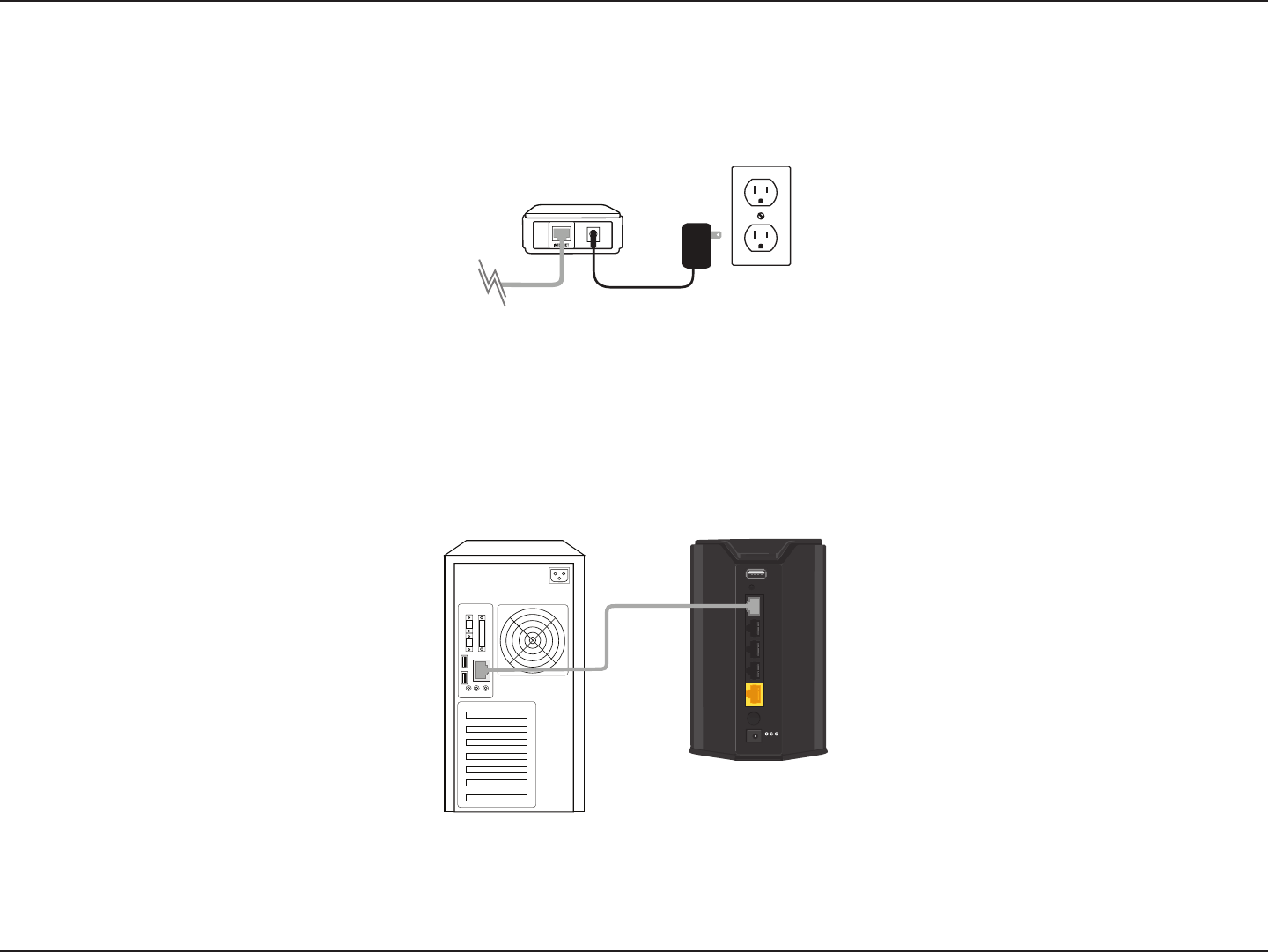
9D-Link DIR-850L User Manual
Section 2 - Installation
1. Turn o and unplug your cable or DSL broadband modem. This is required.
Manual Setup
2. Position your router close to your modem and a computer. Place the router in an open area of your intended
work area for better wireless coverage.
3. Unplug the Ethernet cable from your modem (or existing router if upgrading) that is connected to your computer.
Plug it into the LAN port labeled 1 on the back of your router. The router is now connected to your computer.
Modem
DIR-850L
Computer
USB
WPS
1
2
3
4
INTERNET
POWER
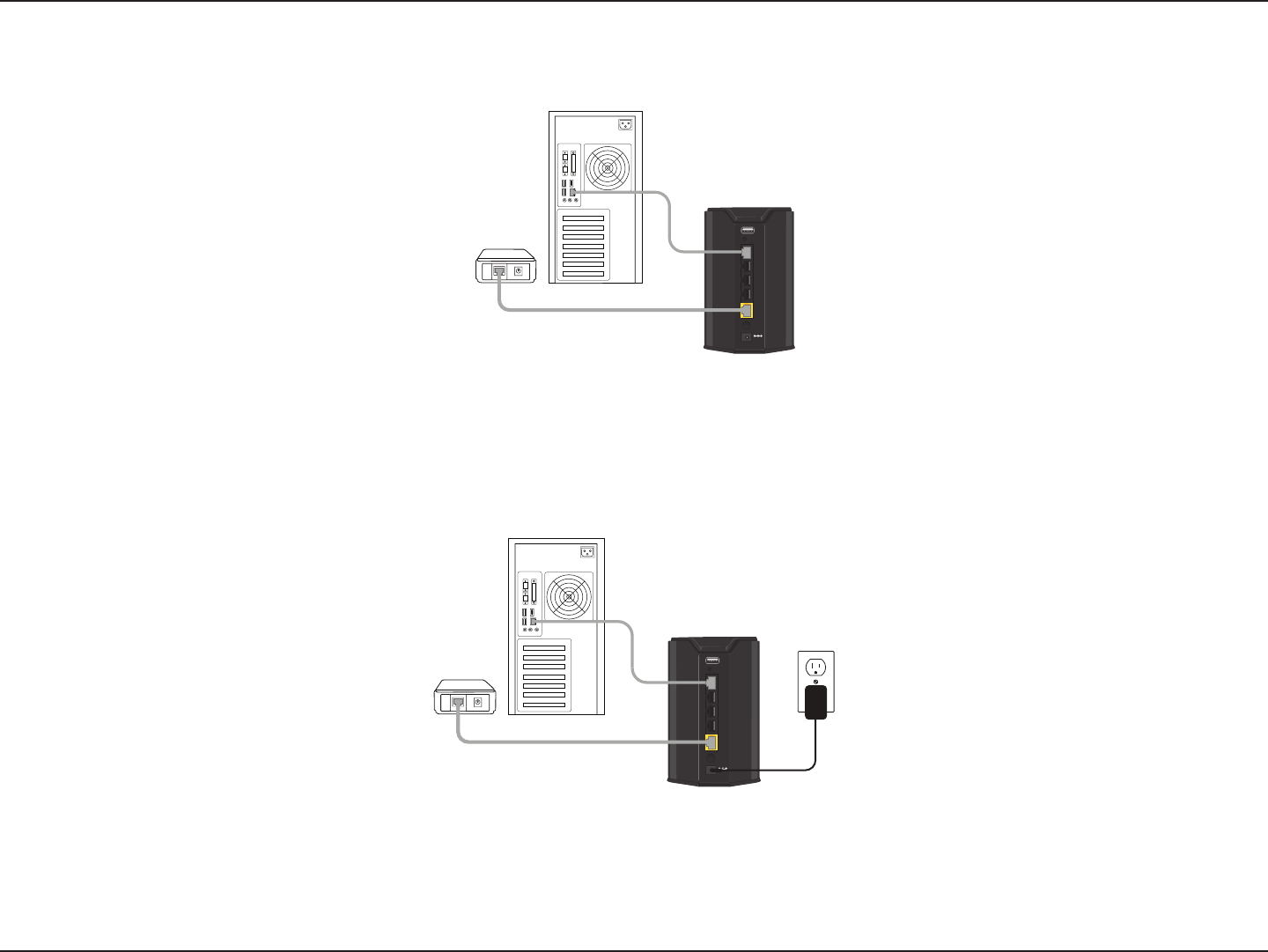
10D-Link DIR-850L User Manual
Section 2 - Installation
4. Plug one end of the included blue Ethernet cable that came with your router into the yellow port labeled
INTERNET on the back of the router. Plug the other end of this cable into the Ethernet port on your modem.
5. Reconnect the power adapter to your cable or DSL broadband modem and wait for two minutes.
6. Connect the supplied power adapter into the power port on the back of the router and then plug it into a power
outlet or surge protector. Press the power button and verify that the power LED is lit. Allow 1 minute for the
router to boot up.
7. If you are connecting to a Broadband service that uses a dynamic connection (not PPPoE), you may be online
already. Try opening a web browser and enter a web site. If a solid light indicates connection on the Internet port
and the router can connect to the Internet. If the LED is orange, the connection is good but the router cannot
connect to the Internet.
DIR-850L
DIR-850L
Modem
Computer
Modem
Computer
USB
WPS
1
2
3
4
INTERNET
POWER
INTERNET
USB
WPS
1
2
3
4
INTERNET
POWER
INTERNET

11D-Link DIR-850L User Manual
Section 2 - Installation
There are several dierent ways you can congure your router to connect to the Internet and connect to your clients:
• D-Link Setup Wizard - This wizard will launch when you log into the router for the rst time. Refer to page 14.
• QRS Mobile App - Use your iPhone, iPad, or iPod Touch to congure your router. Refer to page 21
• Manual Setup - Log into the router and manually congure your router (advanced users only). Refer to page 27.
Conguration
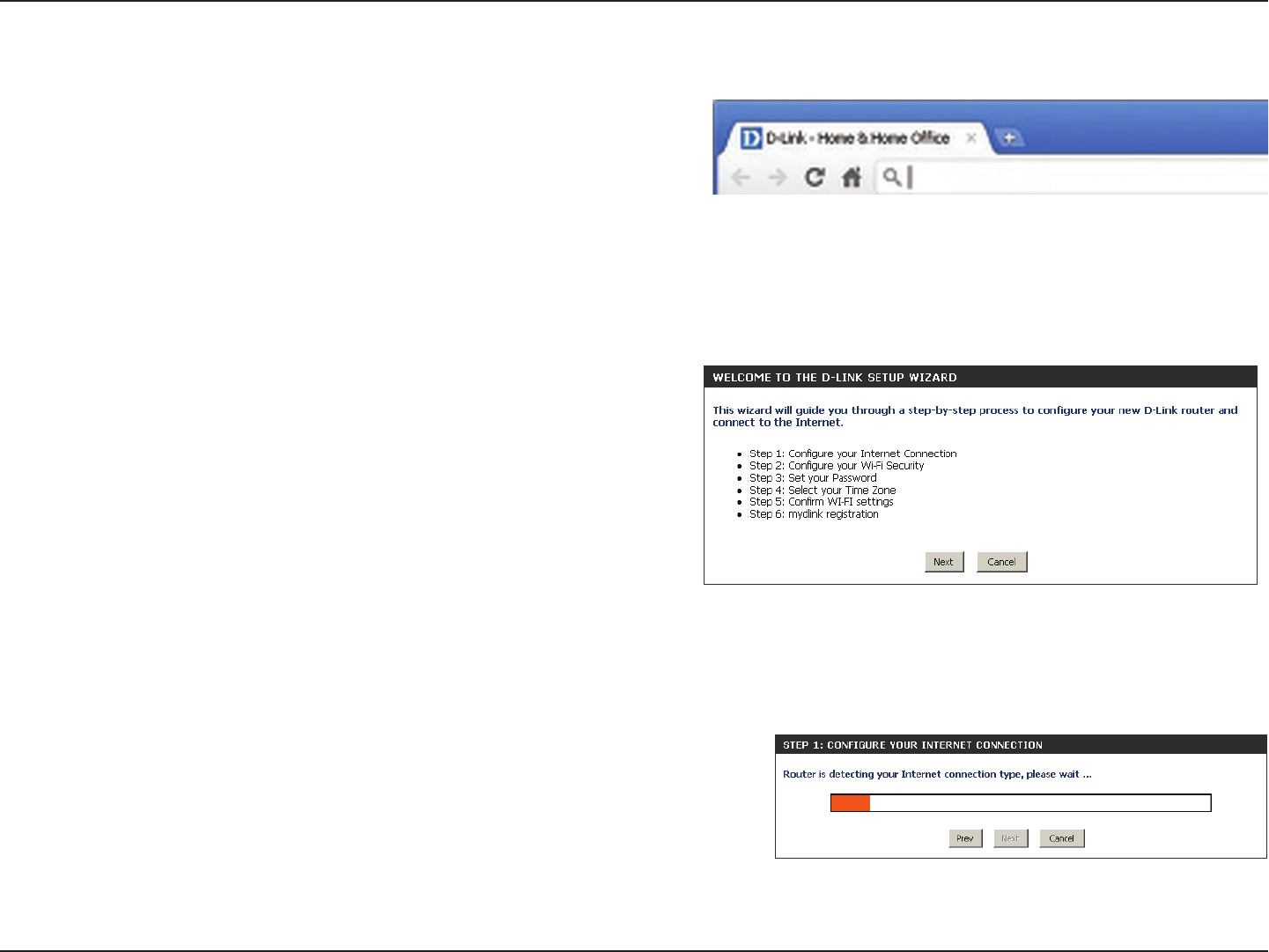
12D-Link DIR-850L User Manual
Section 3 - Conguration
If this is your rst time logging into the router, this wizard will
start automatically.
This wizard is designed to guide you through a step-by-step
process to congure your new D-Link router and connect to the
Internet.
Click Next to continue.
Quick Setup Wizard
If this is your rst time installing the router, open your web
browser. You will automatically be directed to the Wizard Setup
Screen. If not, enter “http://dlinkrouter.local”. Then, press Enter.
If you have already congured your settings and you would like
to access the conguration utility, please refer to page 27.
Please wait while your router detects your internet connection type.
If the router detects your Internet connection, you may need to enter
your ISP information such as username and password.
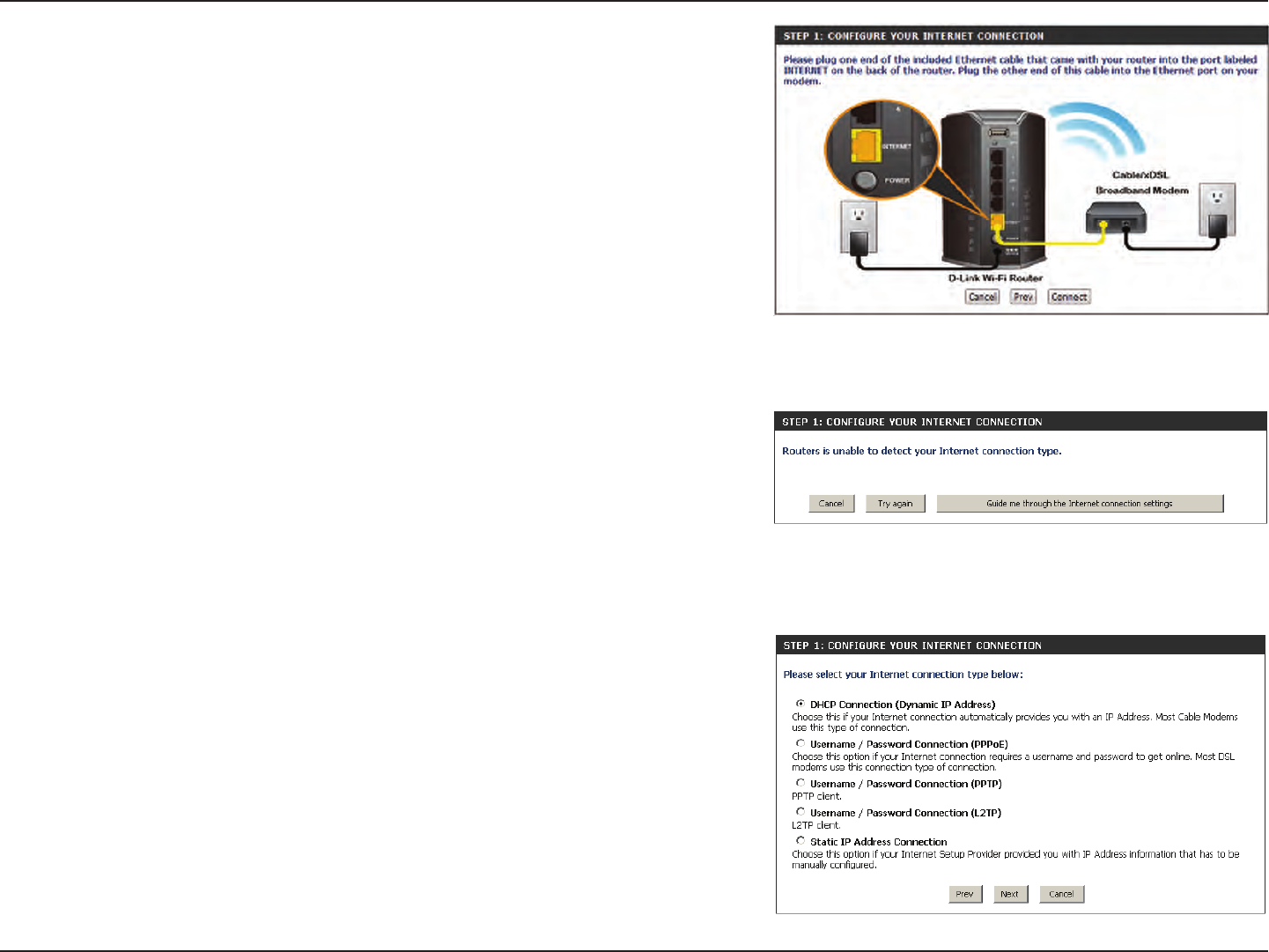
13D-Link DIR-850L User Manual
Section 3 - Conguration
If the router does not detect a valid Ethernet connection from the
Internet port, this screen will appear. Connect your broadband modem
to the Internet port and then click Try Again.
If the router detects an Ethernet connection but does not detect the type
of Internet connection you have, this screen will appear. Click Guide me
through the Internet Connection Settings to display a list of connection
types to choose from.
Select your Internet connection type and click Next to continue.
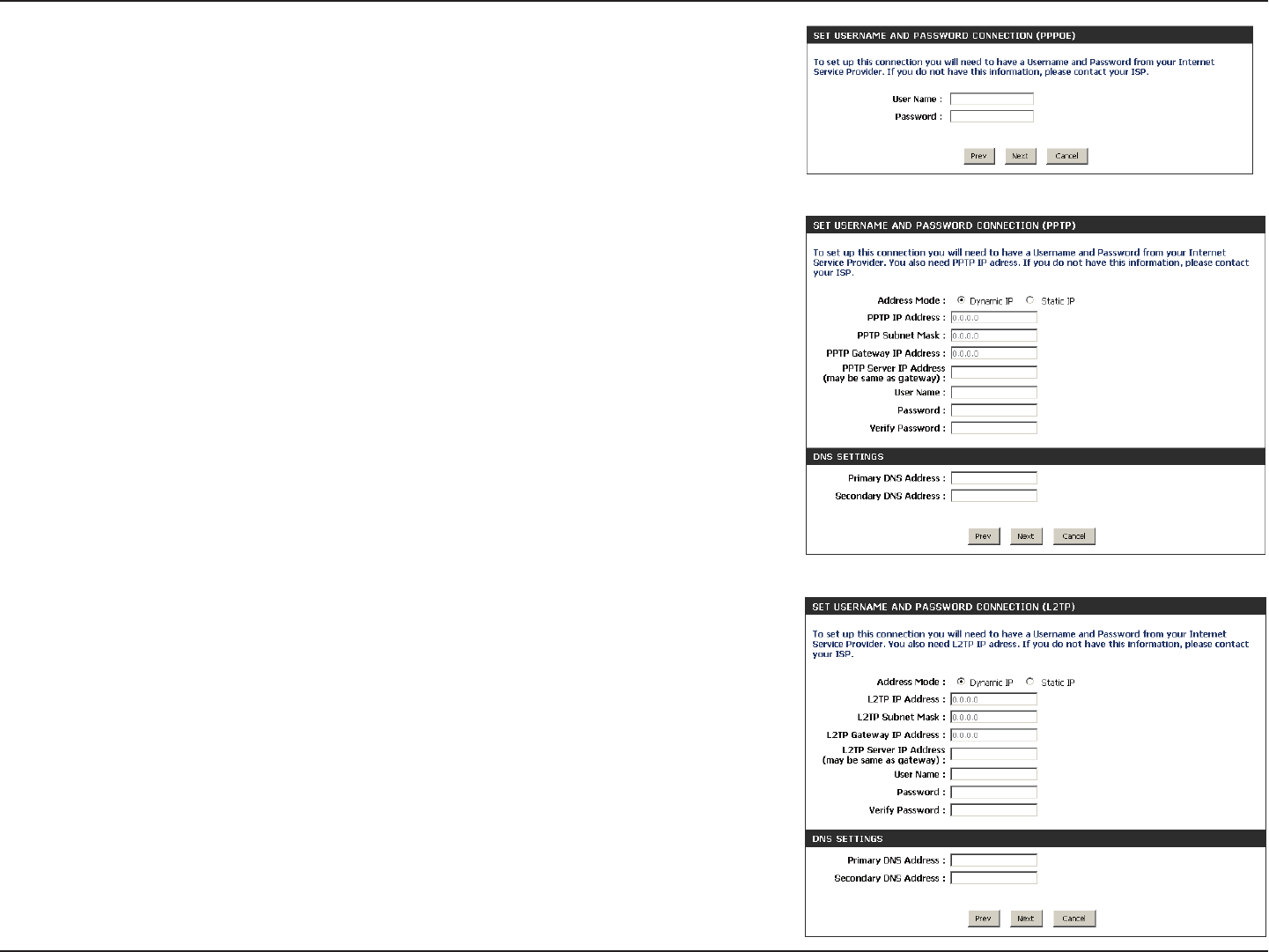
14D-Link DIR-850L User Manual
Section 3 - Conguration
If the router detected or you selected PPPoE, enter your PPPoE username
and password and click Next to continue.
Note: Make sure to remove your PPPoE software from your computer. The
software is no longer needed and will not work through a router.
If the router detected or you selected PPTP, enter your PPTP username,
password, and other information supplied by your ISP. Click Next to
continue.
If the router detected or you selected L2TP, enter your L2TP username,
password, and other information supplied by your ISP. Click Next to
continue.
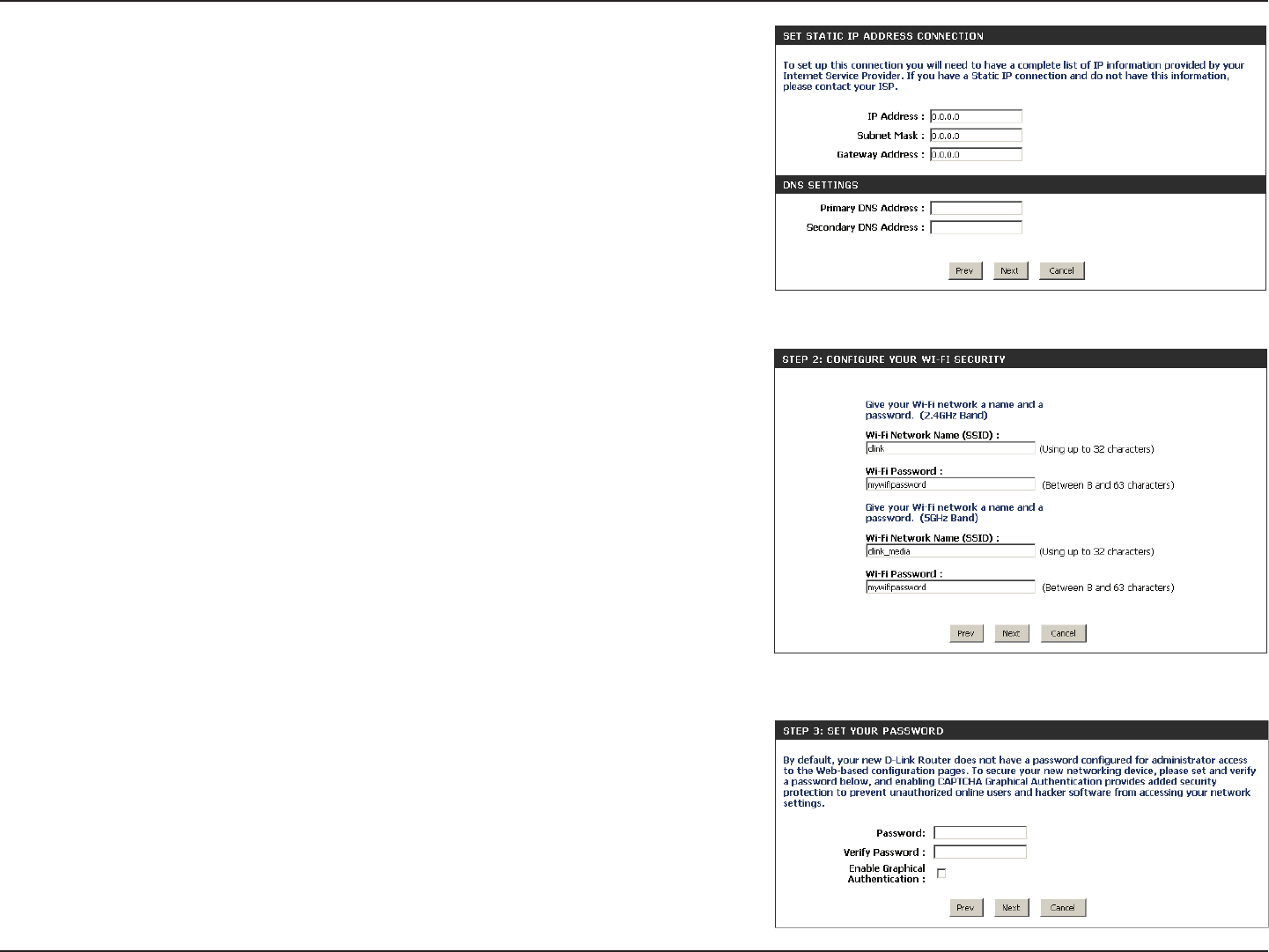
15D-Link DIR-850L User Manual
Section 3 - Conguration
If the router detected or you selected Static, enter the IP and DNS
settings supplied by your ISP. Click Next to continue.
For both the 2.4GHz and 5GHz segments, create a Wi-Fi network name
(SSID) using up to 32 characters.
Create a Wi-Fi password (between 8-63 characters). Your wireless clients
will need to have this passphrase or key entered to be able to connect
to your wireless network.
Click Next to continue.
In order to secure your router, please enter a new password. Check the
Enable Graphical Authentication box to enable CAPTCHA authentication
for added security. Click Next to continue.
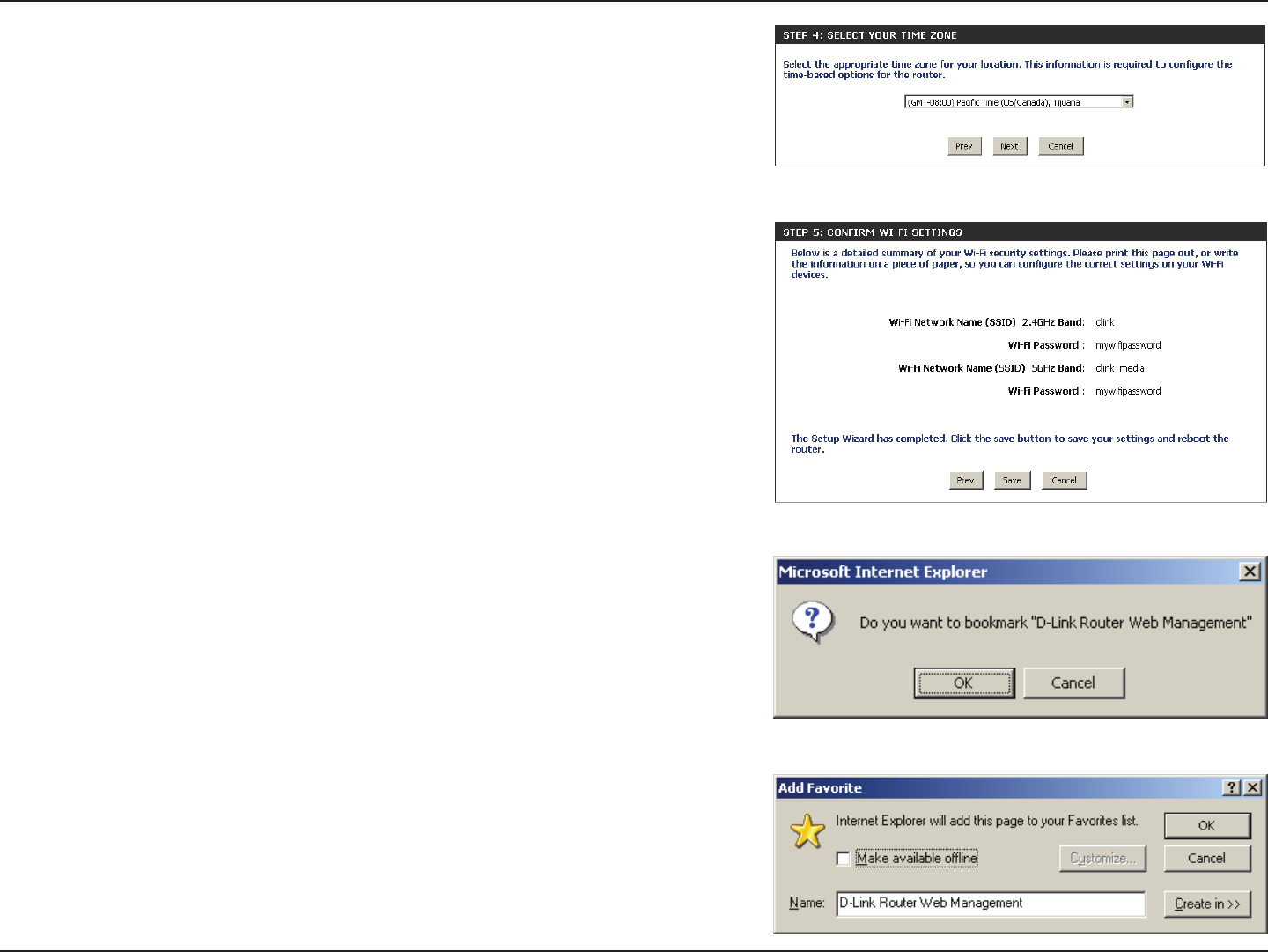
16D-Link DIR-850L User Manual
Section 3 - Conguration
Select your time zone from the drop-down menu and click Next to
continue.
The Setup Complete window will display your Wi-Fi settings. Click Save
and Connect to continue.
If you want to create a bookmark to the router, click OK. Click Cancel if
you do not want to create a bookmark.
If you clicked Yes, a window may appear (depending on what web
browser you are using) to create a bookmark.
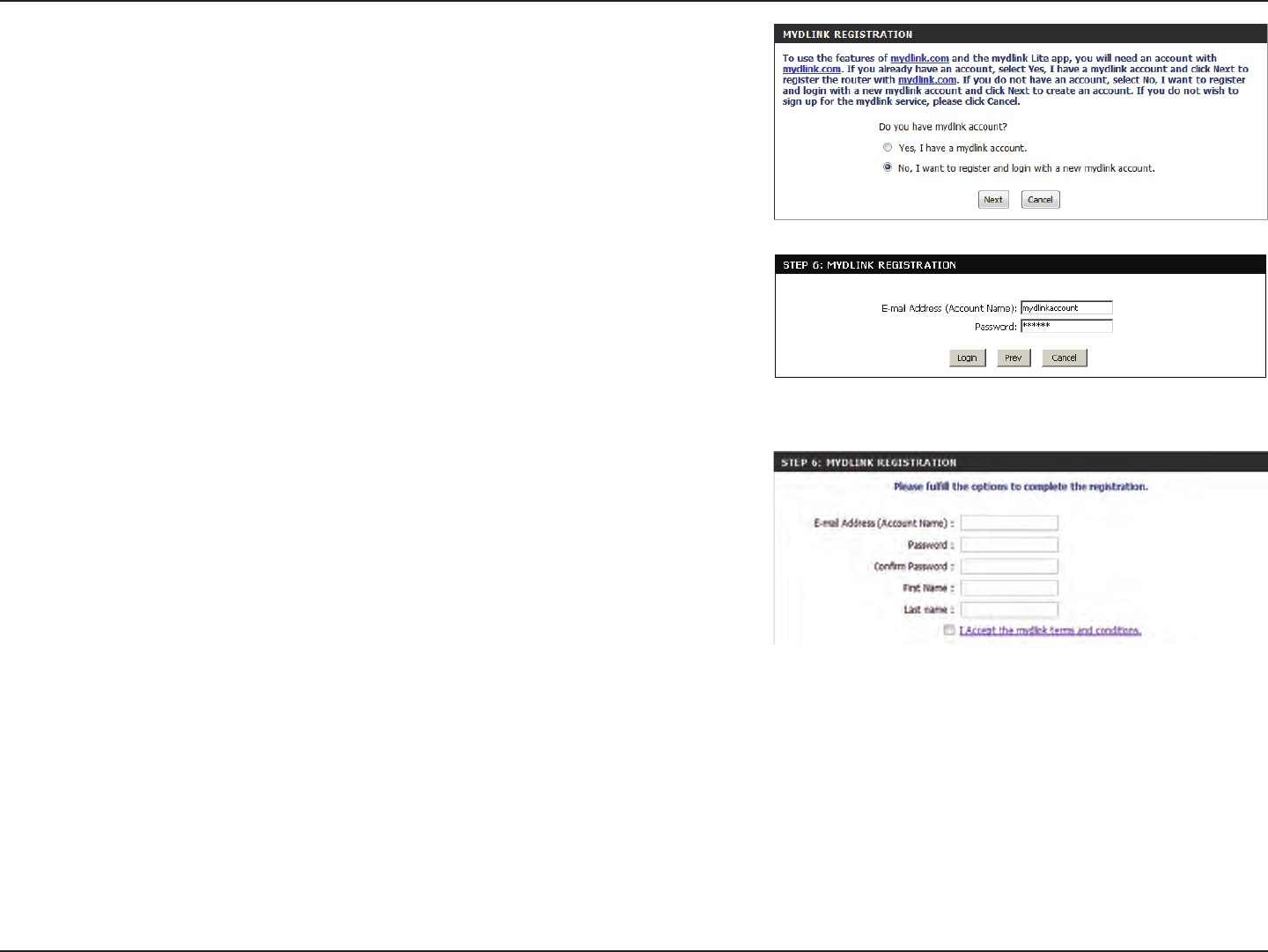
17D-Link DIR-850L User Manual
Section 3 - Conguration
To use the mydlink service (mydlink.com or the mydlink Lite app), you
must have an account. Select if you do have a mydlink account or if you
need to create one. Click Next to continue.
If you do not want to register at this time, click Cancel.
If you clicked Yes, enter your mydlink account name (email address) and
password. Click Login to register your router.
If you clicked No, ll out the requested information and click Sign Up
to create your mydlink account.
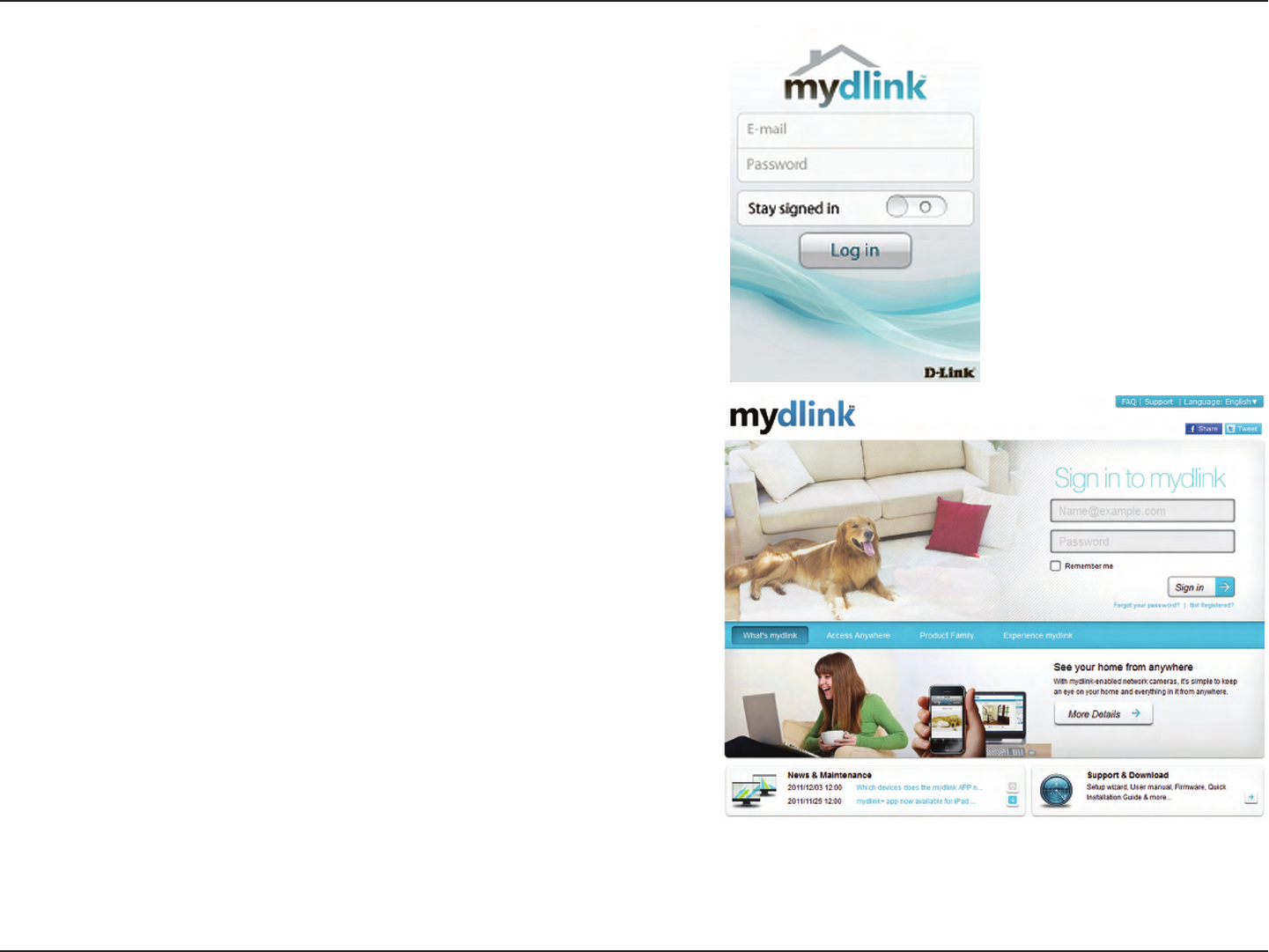
18D-Link DIR-850L User Manual
Section 3 - Conguration
The mydlink App will allow you to receive notices, browse network
users, and congure your router from an iPhone/iPad/iPod Touch
(iOS 3.0 or higher), Android device (1.6 or higher).
To download the "mydlink lite" app, visit the Apple Store, Android
Market or http://mydlink.com/Lite.
PC and Mac users can use the mydlink portal at http://mydlink.com.
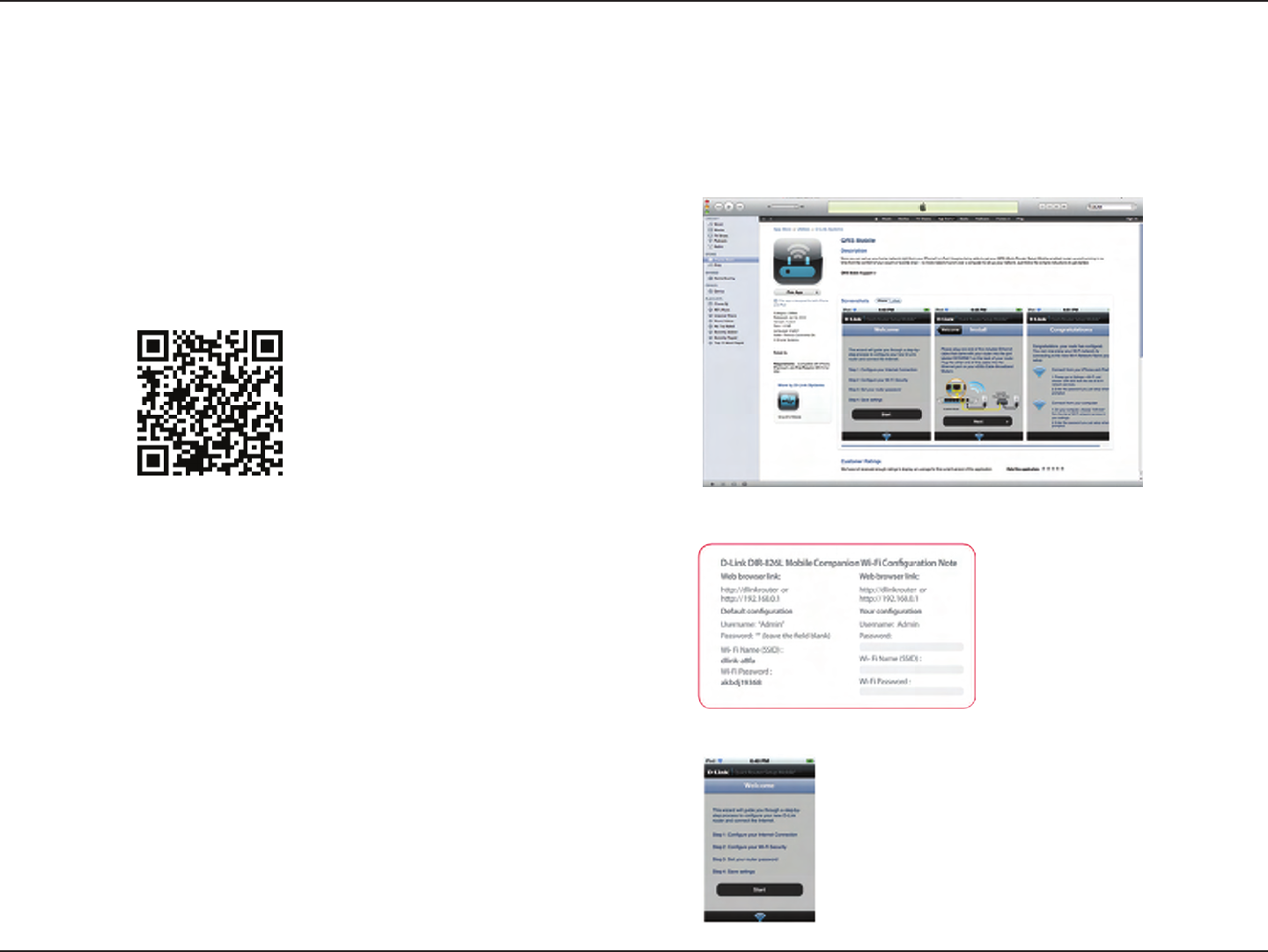
19D-Link DIR-850L User Manual
Section 3 - Conguration
QRS Mobile App
D-Link oers an app for your iPad, iPod Touch, or iPhone (iOS 4.3 or higher) to install and congure your router.
Step 1
From your iPad, Touch, or iPhone, go to the iTunes Store and
search for ‘D-Link’. Select QRS Mobile and then download it.
You may also scan this code to download.
Step 2
Once your app is installed, you may now congure your router.
Connect to the router wirelessly by going to your wireless utility
on your device. Scan for the Wi-Fi name (SSID) as listed on the
supplied info card. Select and then enter your Wi-Fi password.
Step 3
Once you connect to the router, launch the QRS mobile app and
it will guide you through the installation of your router.

20D-Link DIR-850L User Manual
Section 3 - Conguration
1. Insert your USB ash drive into DIR-850L.
2. Scan the bar code to download the SharePort Mobile APP from the app
store to your iPhone or iPad.
SharePort Mobile App
3. From your iOS mobile device, click Settings.
The SharePort Mobile app will allow you to access les from a USB thumb drive that is plugged into your router. You must enable le sharing from
the Setup > Storage page (refer to page 68) for this app to work properly.
Settings
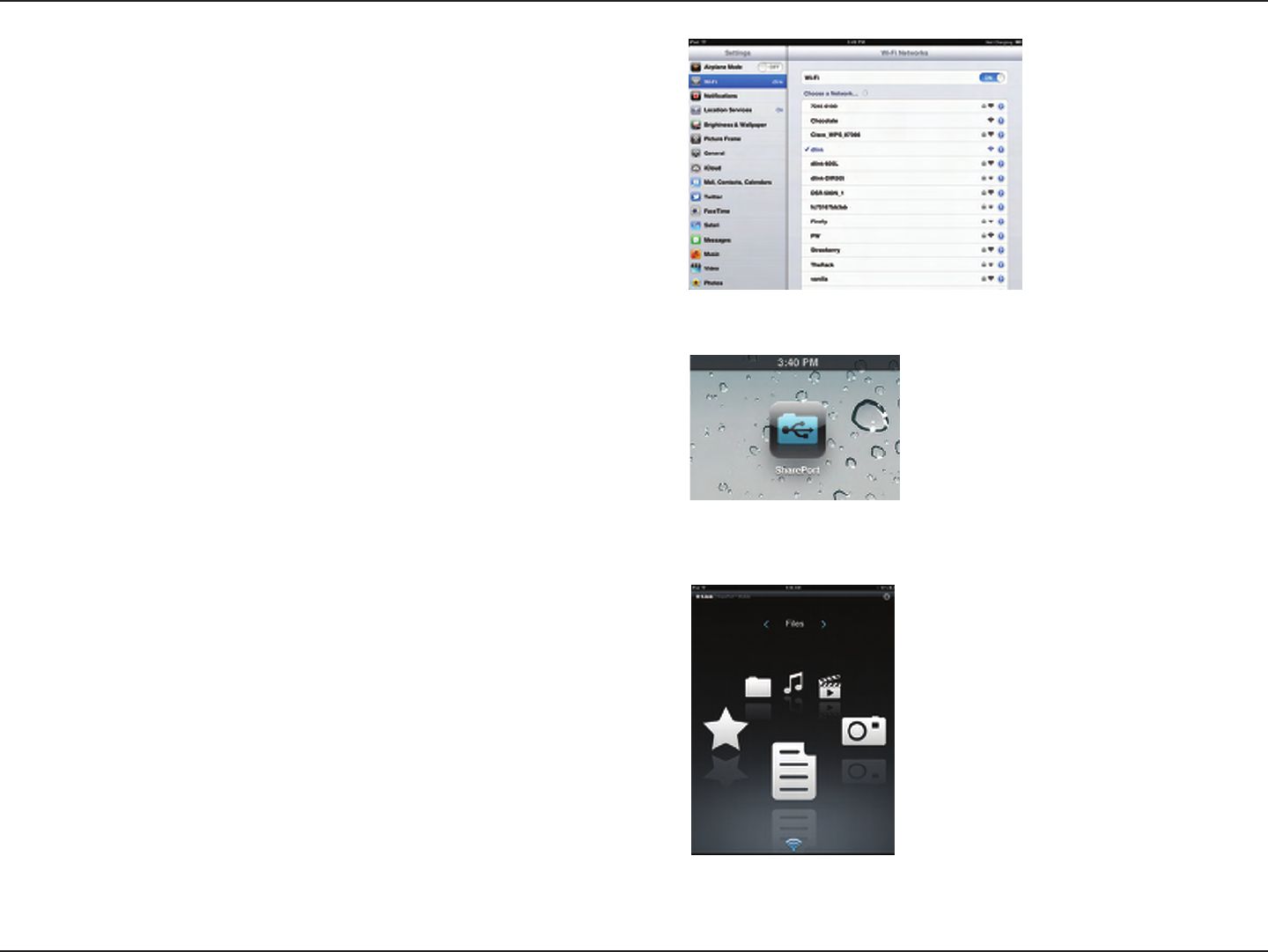
21D-Link DIR-850L User Manual
Section 3 - Conguration
4. Click Wi-Fi, select the Wi-Fi Network Name (SSID) that you created in the
setup and then enter your Wi-Fi password.
5. Once connected, click on the SharePort Mobile icon.
6. The following screen will appear.
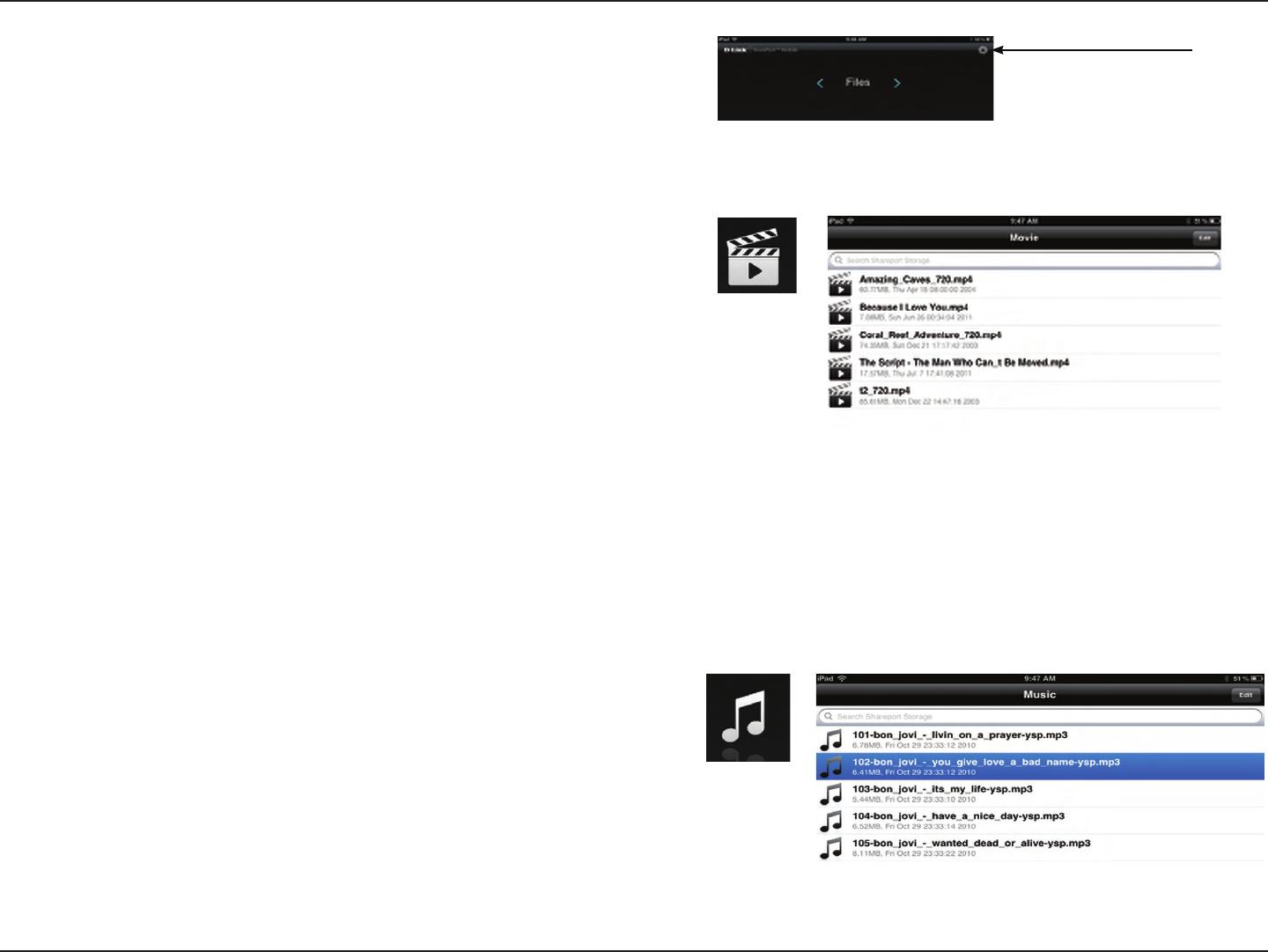
22D-Link DIR-850L User Manual
Section 3 - Conguration
7. Click on Settings icon located on the right top corner of the screen. Click
Edit to enter your User Name and Password. Once you nish, click Done
to continue.
8. For the Movie section, click the movie icon to play your movie from your
USB ash drive.
9. For the Music section, click the music icon to play your music from your
USB ash drive.
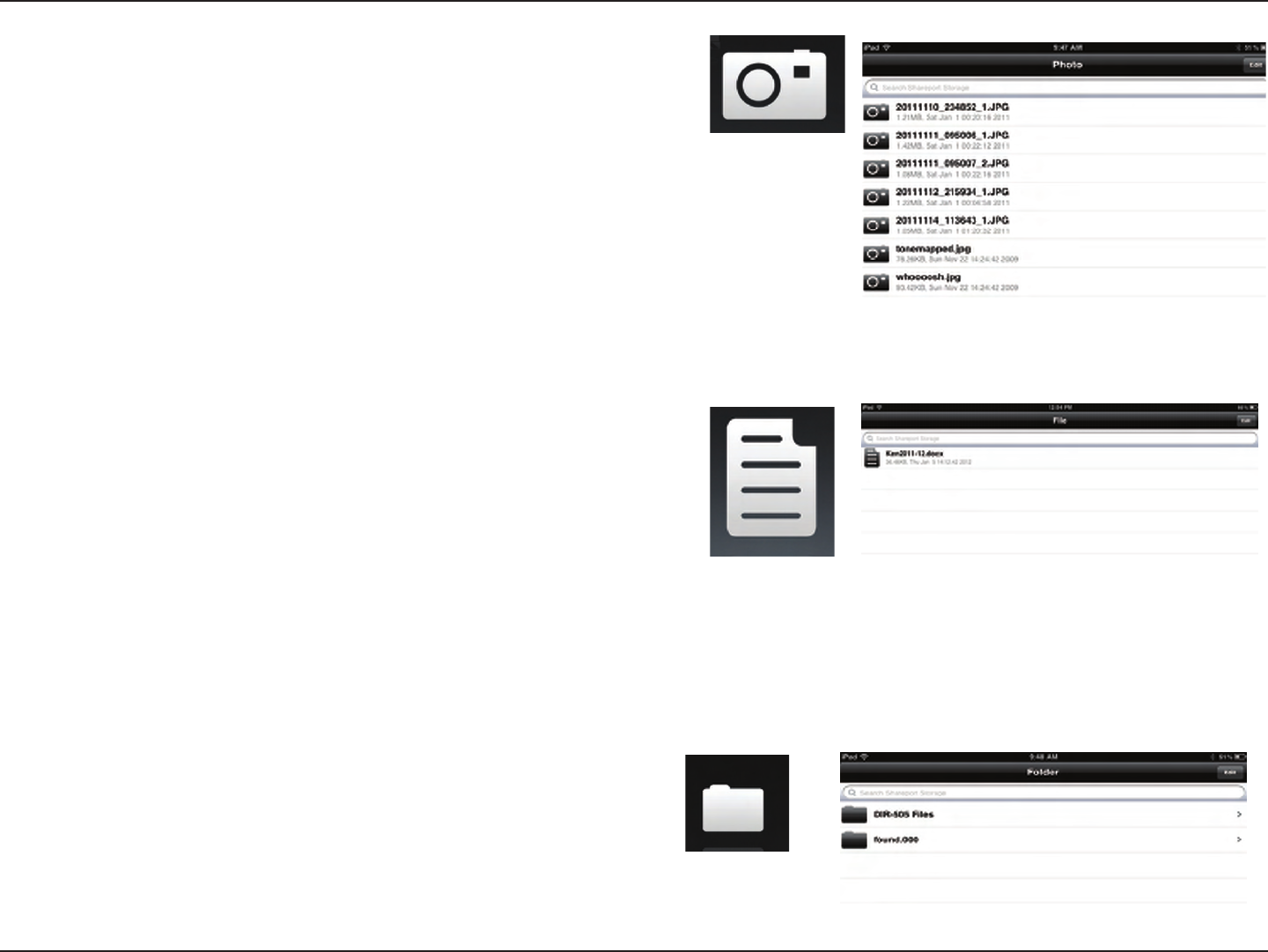
23D-Link DIR-850L User Manual
Section 3 - Conguration
10. For the Photo section, click the Photo icon to view your photos from
your USB ash drive.
11. For the Files section, click on the Files icon to view your les from your
USB ash drive.
12. For the Folder section, click the folder icon to view your folders
from your USB ash drive.
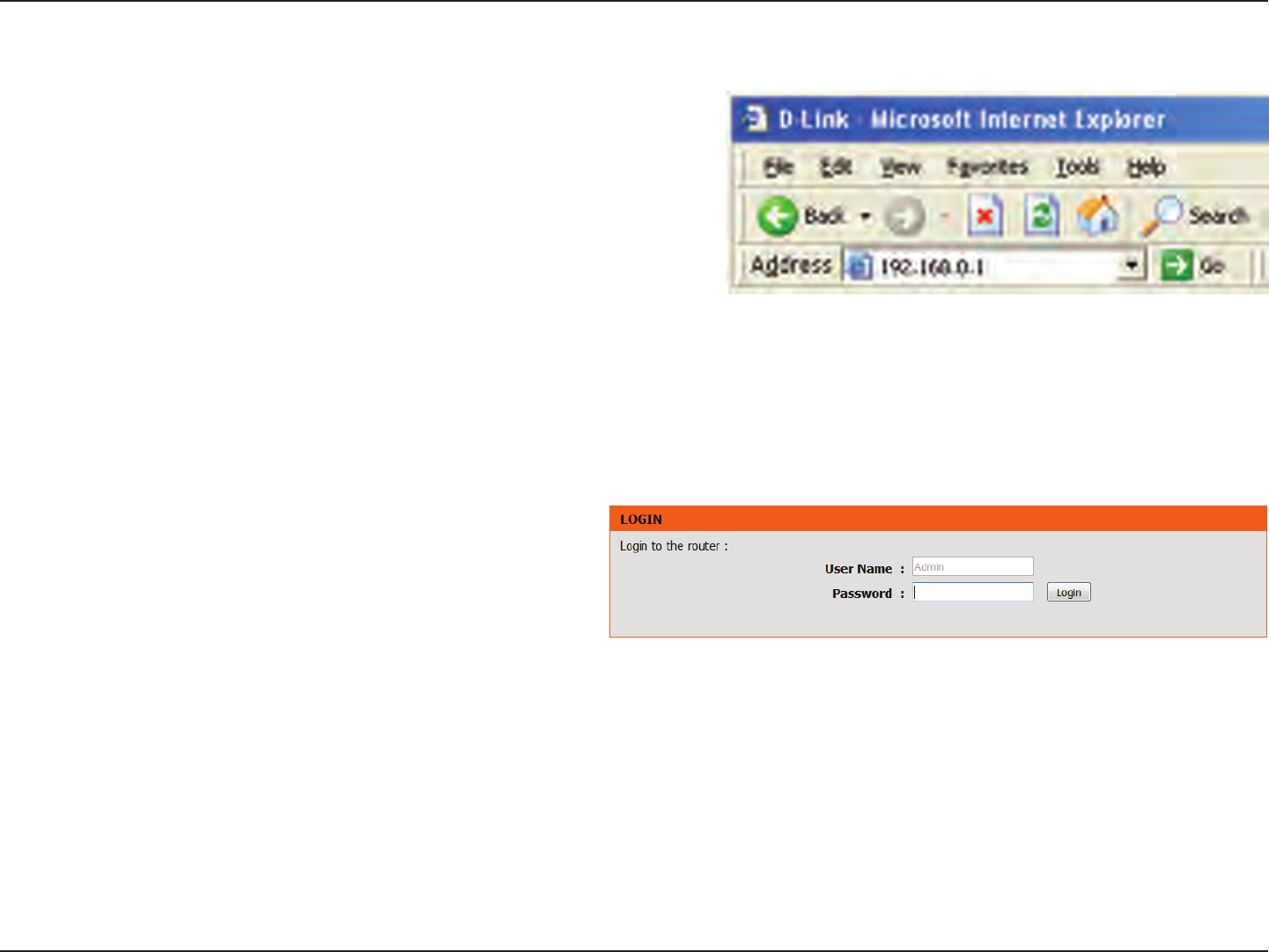
24D-Link DIR-850L User Manual
Section 3 - Conguration
Web-based Conguration Utility
Leave the password blank by default.
To access the conguration utility, open a web-browser such as
Internet Explorer and enter address of the router
(http://dlinkrouter.local or http://192.168.0.1).
Non-Windows and Non-Mac users may also connect by typing
http://192.168.0.1 in the address bar.
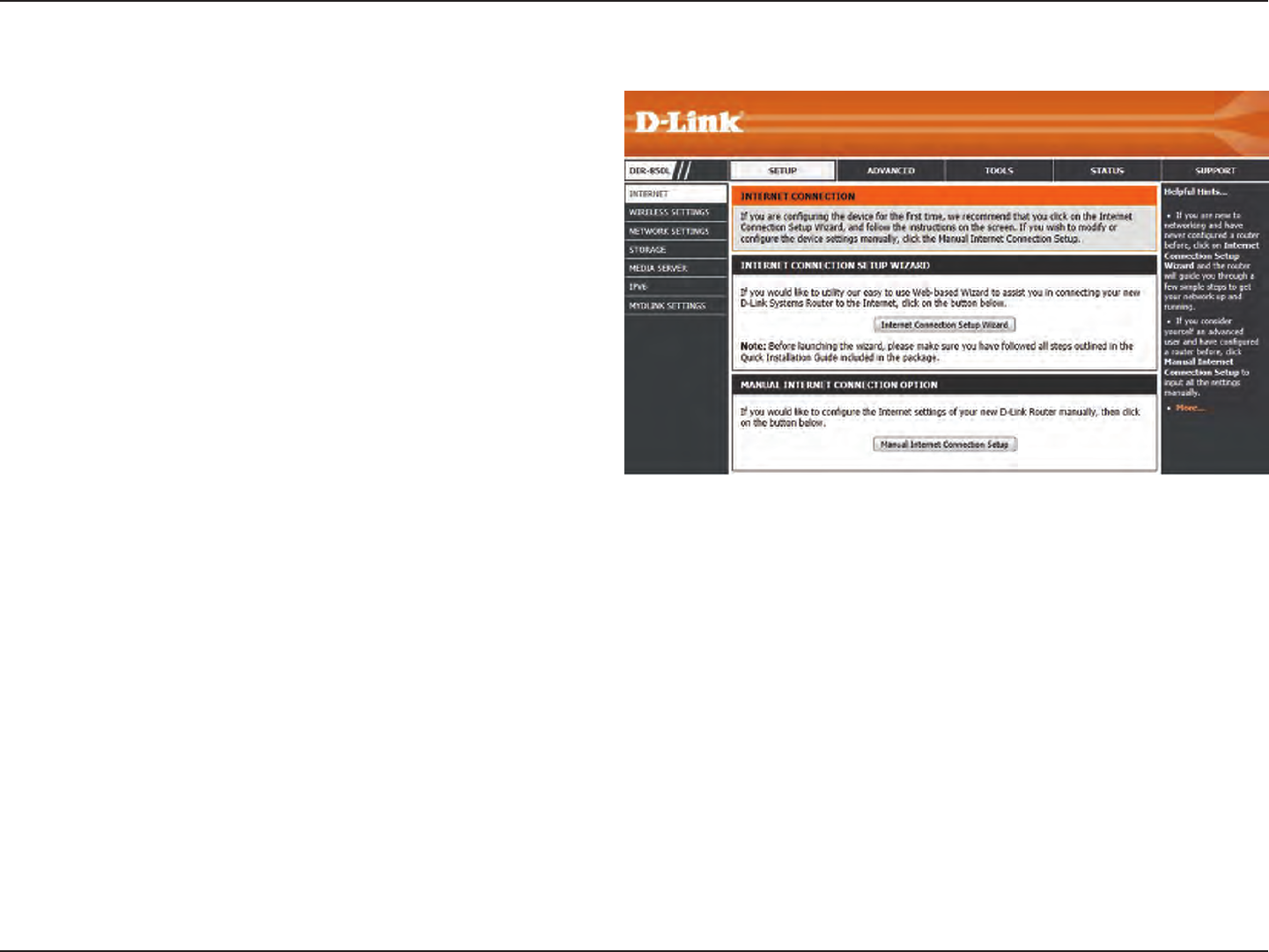
25D-Link DIR-850L User Manual
Section 3 - Conguration
Internet Connection Setup
Click Manual Internet Connection Setup to congure your
connection manually and continue to the next page.
If you want to congure your router to connect to the Internet
using the wizard, click Internet Connection Setup Wizard.
You will be directed to the Quick Setup Wizard.
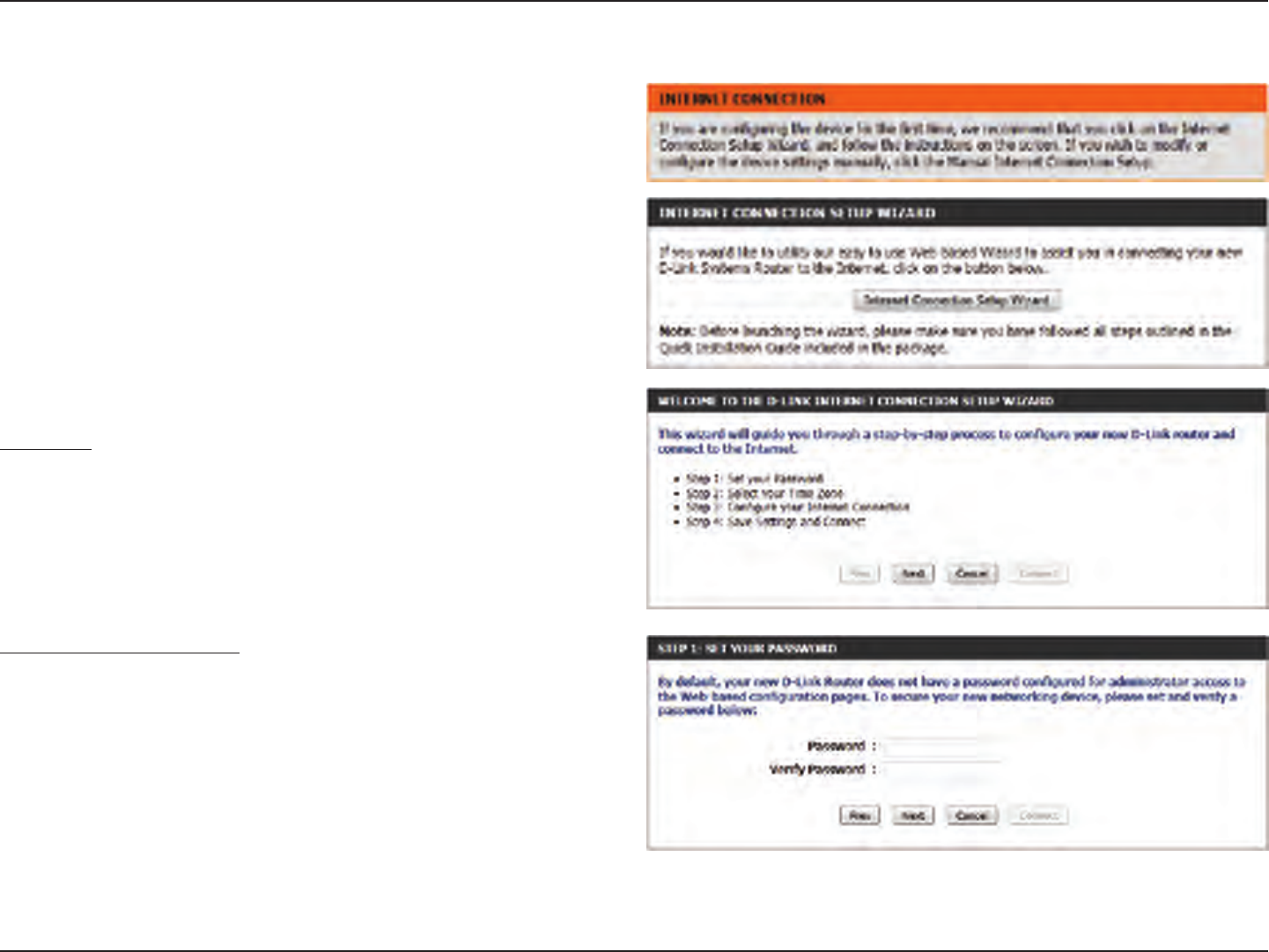
26D-Link DIR-850L User Manual
Internet Connection Setup Wizard
When conguring the router for the rst time, we recommend
that you click use the Internet Connection Setup Wizard, and follow
the instructions on the screen. This wizard is designed to assist
user with a quick and easy method to congure the Internet
Connectivity of this router.
Anytime during the Internet Connection Setup Wizard, the user
can click on the Cancel button to discard any changes made
and return to the main Internet page. Also the user can click
on the Prev button, to return to the previous window for re-
conguration.
Welcome:
This wizard will guide you through a step-by-step process to congure
your new D-Link router and connect to the Internet.
Click Next to continue.
Step 1: Set Your Password
By default, the D-Link Router does not have a password congured for
administrator access to the Web-based conguration pages. To secure
your new networking device, please enter and verify a password in the
spaces provided. The two passwords must match.
Click Next to continue.
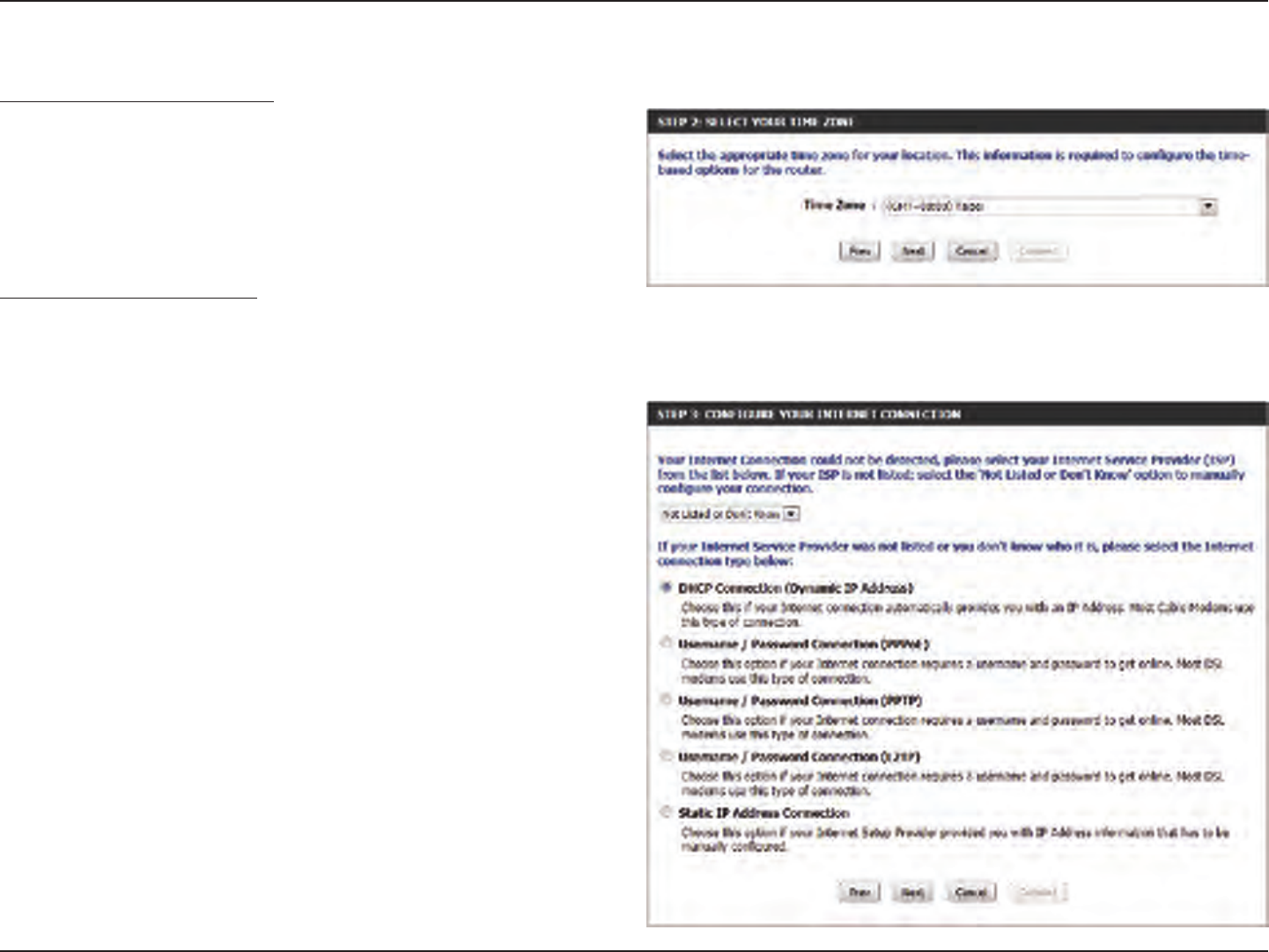
27D-Link DIR-850L User Manual
Step 2: Select Your Time Zone
Select the appropriate time zone for your location. This information is
required to congure the time-based options for the router.
Click Next to continue.
Step 3: Internet Connection
Here the user will be able to congure the Internet Connectivity used by this device. If your ISP connection is listed in the drop-down menu
select it and click Next. If your ISP connection is not listed then you can proceed to select any of the other manual Internet Connection methods
listed below.
The following parameters will be available for conguration:
Dynamic IP Address: Choose this if your Internet connection
automatically provides you with an IP Ad-
dress. Most Cable Modems use this type of
connection.
PPPoE: Choose this option if your Internet con-
nection requires a PPPoE username and
password to get online. Most DSL mo-
dems use this type of connection.
PPTP: Choose this option if your Internet con-
nection requires a PPTP username and
password to get online.
L2TP: Choose this option if your Internet con-
nection requires an L2TP username and
password to get online.
Static IP Address: Choose this option if your Internet Setup
Provider provided you with IP Address
information that has to be manually con-
gured.
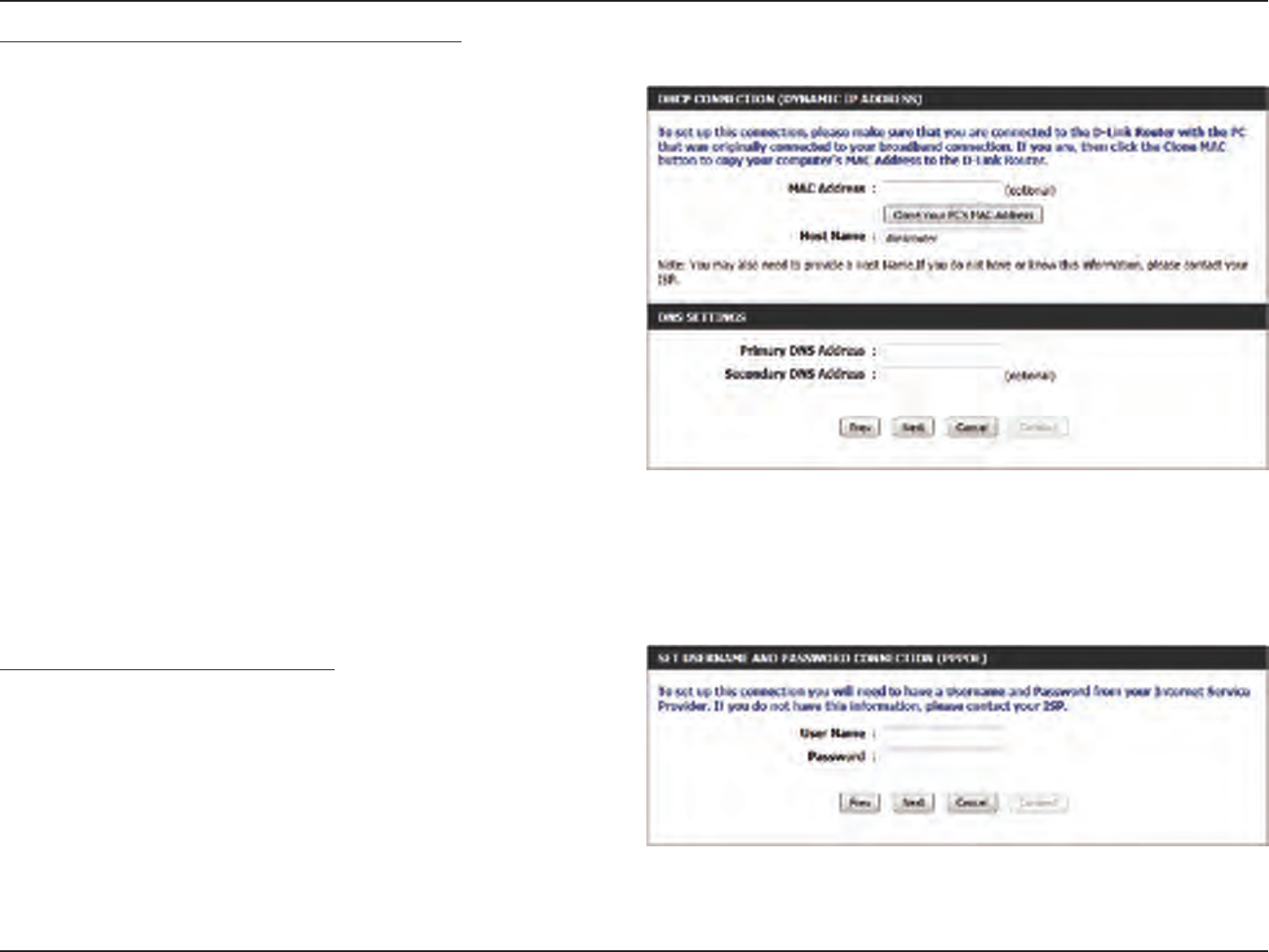
28D-Link DIR-850L User Manual
Step 3: Internet Connection (Dynamic IP Address)
After selecting the Dynamic IP Address Internet connection method, the following page will appear.
The following parameters will be available for conguration:
MAC Address: Enter the MAC address of the Internet gate-
way (plugged into the Internet port of this
device) here.
Clone Button: If the conguration PC also acts as the Internet
gateway, then click on the Clone Your PC’s
MAC Address button to copy the PC’s MAC
address into the space provided. If you’re not
sure, leave the MAC Address eld blank.
Host Name: Enter the host name used here. You may also
need to provide a Host Name. If you do not
have or know this information, please contact
your ISP.
Primary DNS Address: Enter the Primary DNS IP address used here.
Secondary DNS Address: Enter the Secondary DNS IP address used
here. This eld is normally optional. Only
one DNS address is required for a functional
Internet connection, but using a second DNS
address provides more stability.
Click Next to continue.
Step 3: Internet Connection (PPPoE)
After selecting the PPPoE Internet connection method, the following
page will appear:
The following parameters will be available for conguration:
User Name: Enter the PPPoE account user name used here.
This information is given by the ISP.
Password: Enter the PPPoE account password used here.
This information is given by the ISP.
Click Next to continue.
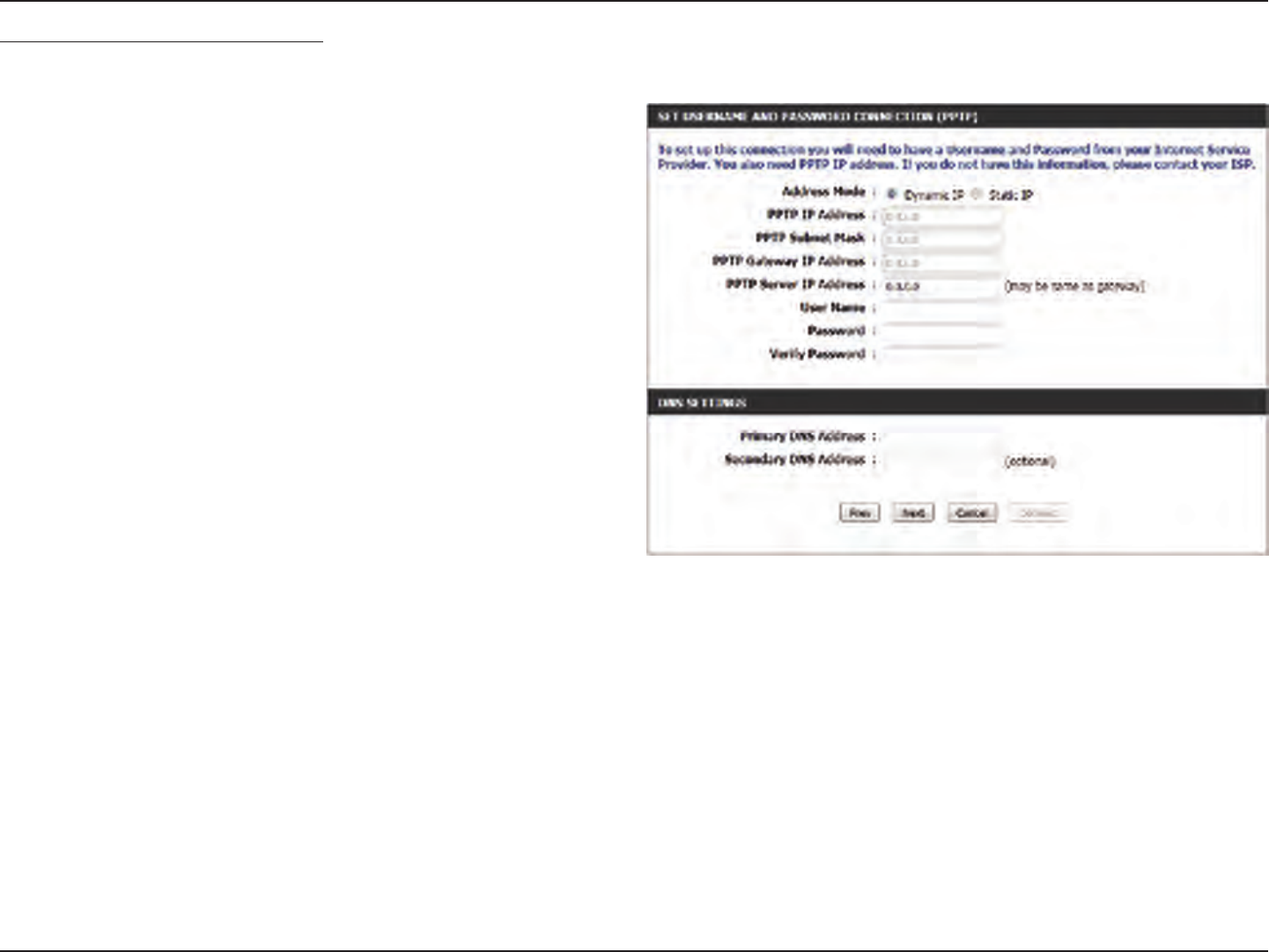
29D-Link DIR-850L User Manual
Step 3: Internet Connection (PPTP)
After selecting the PPTP Internet connection method, the following
page will appear:
The following parameters will be available for conguration:
Address Mode: Here the user can specify whether this
Internet connection requires the use of a
Dynamic or Static IP address. PPTP usual
requires a Dynamic IP conguration.
PPTP IP Address: Enter the PPTP IP address used here. This
option is only available if Static IP is se-
lected.
PPTP Subnet Mask: Enter the PPTP Subnet Mask used here.
PPTP Gateway IP Address: Enter the PPTP Gateway IP address used
here.
PPTP Server IP Address: Enter the PPTP Server IP address used
here. This is normally the same a the PPTP
Gateway IP address.
User Name: Enter the PPTP username used here.
Password: Enter the PPTP password used here.
Verify Password: Re-enter the PPTP password used here.
Primary DNS Address: Enter the Primary DNS IP address used here.
Secondary DNS Address: Enter the Secondary DNS IP address used here. This eld is normally optional. Only one DNS address is required for
a functional Internet connection, but using a second DNS address provides more stability.
Click Next to continue.
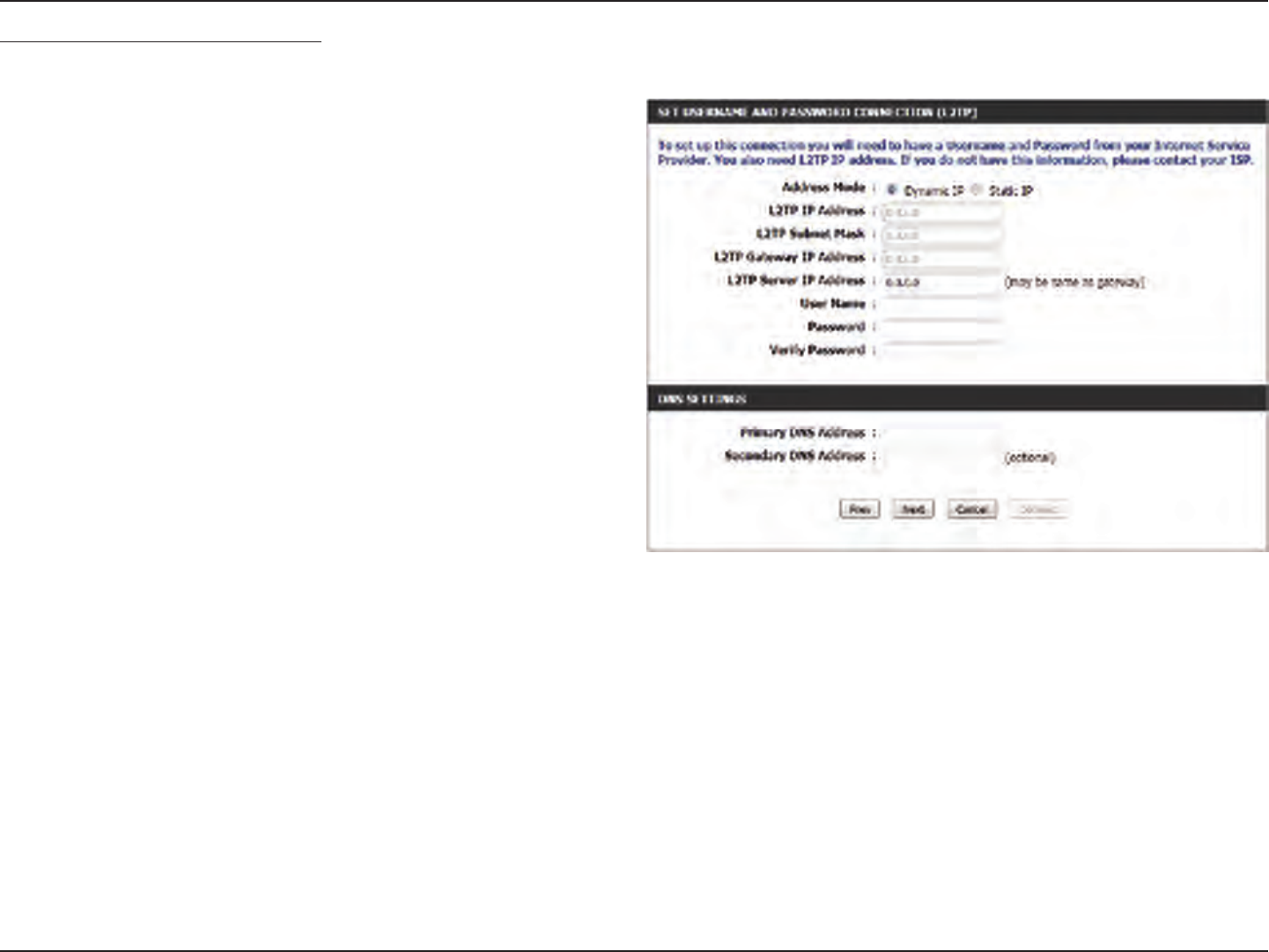
30D-Link DIR-850L User Manual
Step 3: Internet Connection (L2TP)
After selecting the L2TP Internet connection method, the following
page will appear:
The following parameters will be available for conguration:
Address Mode: Here the user can specify whether this
Internet connection requires the use of a
Dynamic or Static IP address. L2TP usual
requires a Dynamic IP conguration.
L2TP IP Address: Enter the L2TP IP address used here. This
option is only available if Static IP is se-
lected.
L2TP Subnet Mask: Enter the L2TP Subnet Mask used here.
L2TP Gateway IP Address: Enter the L2TP Gateway IP address used
here.
L2TP Server IP Address: Enter the L2TP Server IP address used
here. This is normally the same a the L2TP
Gateway IP address.
User Name: Enter the L2TP username used here.
Password: Enter the L2TP password used here.
Verify Password: Re-enter the L2TP password used here.
Primary DNS Address: Enter the Primary DNS IP address used
here.
Secondary DNS Address: Enter the Secondary DNS IP address used
here. This eld is normally optional. Only
one DNS address is required for a func-
tional Internet connection, but using a
second DNS address provides more stabil-
ity.
Click Next to continue.
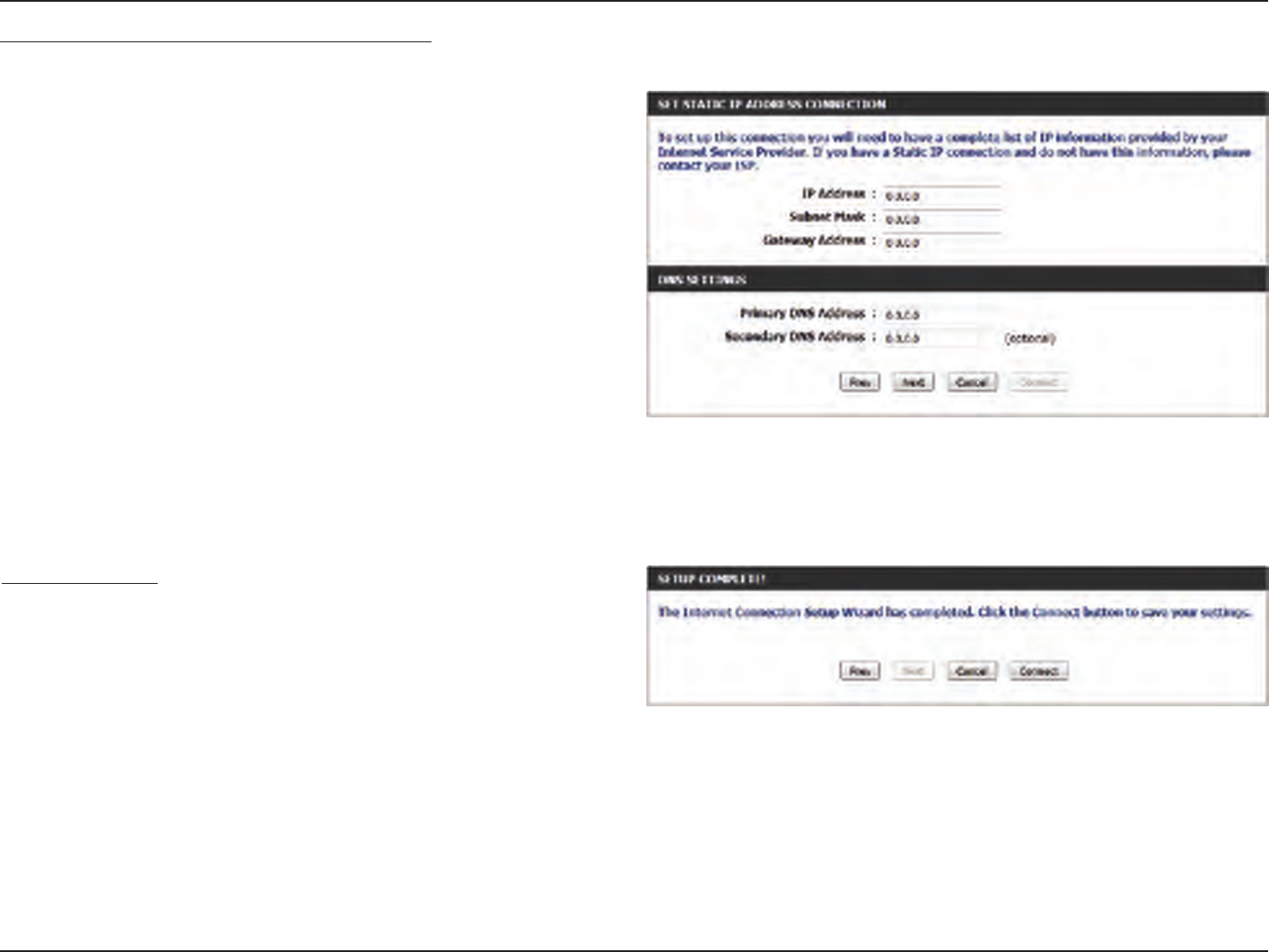
31D-Link DIR-850L User Manual
Step 3: Internet Connection (Static IP Address)
After selecting the Static IP Address Internet connection method, the following page will appear:
Setup Complete!
This is the last page of the Internet Connection Setup Wizard.
Click the Connect button to save your settings.
The following parameters will be available for conguration:
IP Address: Enter the Static IP address provided by the
ISP here.
Subnet Mask: Enter the Subnet Mask provided by the ISP
here.
Gateway Address: Enter the Gateway IP address provided by
the ISP here.
Primary DNS Address: Enter the Primary DNS IP address used
here.
Secondary DNS Address: Enter the Secondary DNS IP address used
here. This eld is normally optional. Only
one DNS address is required for a func-
tional Internet connection, but using a
second DNS address provides more stabil-
ity.
Click Next to continue.
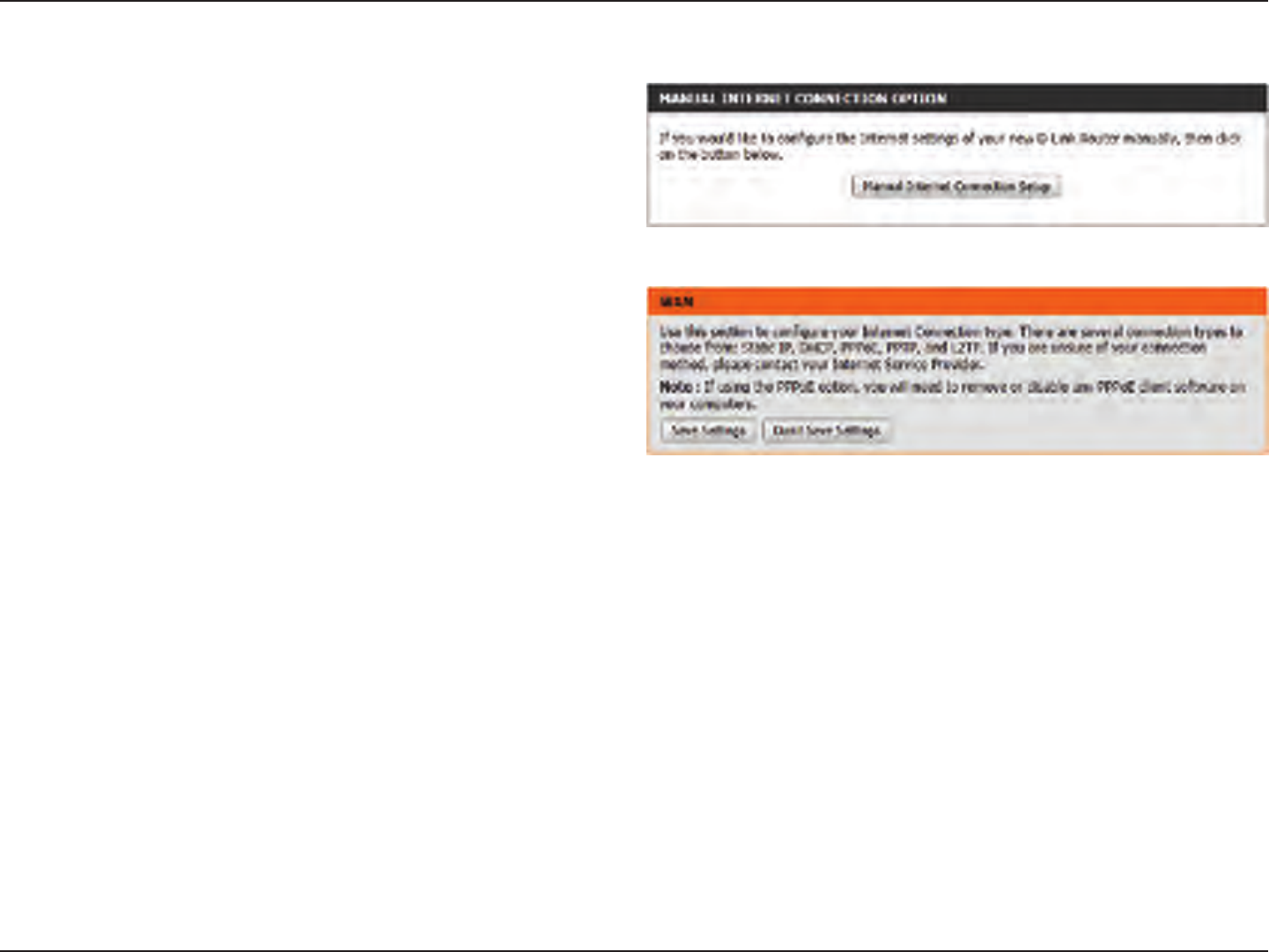
32D-Link DIR-850L User Manual
Internet (Manual)
On this page the user can congure the Internet Connection settings
manually. To access the Manual Internet Connection Setup page, click
on the Manual Internet Connection Setup button. On this page there a
multiple parameters that can be congured regarding the Internet Con-
nection setup. We’ll discuss them from top to bottom.
At any given point the user can save the conguration done, on this
page, by clicking on the Save Settings button. If you choose to discard
the changes made, click on the Don’t Save Settings button.
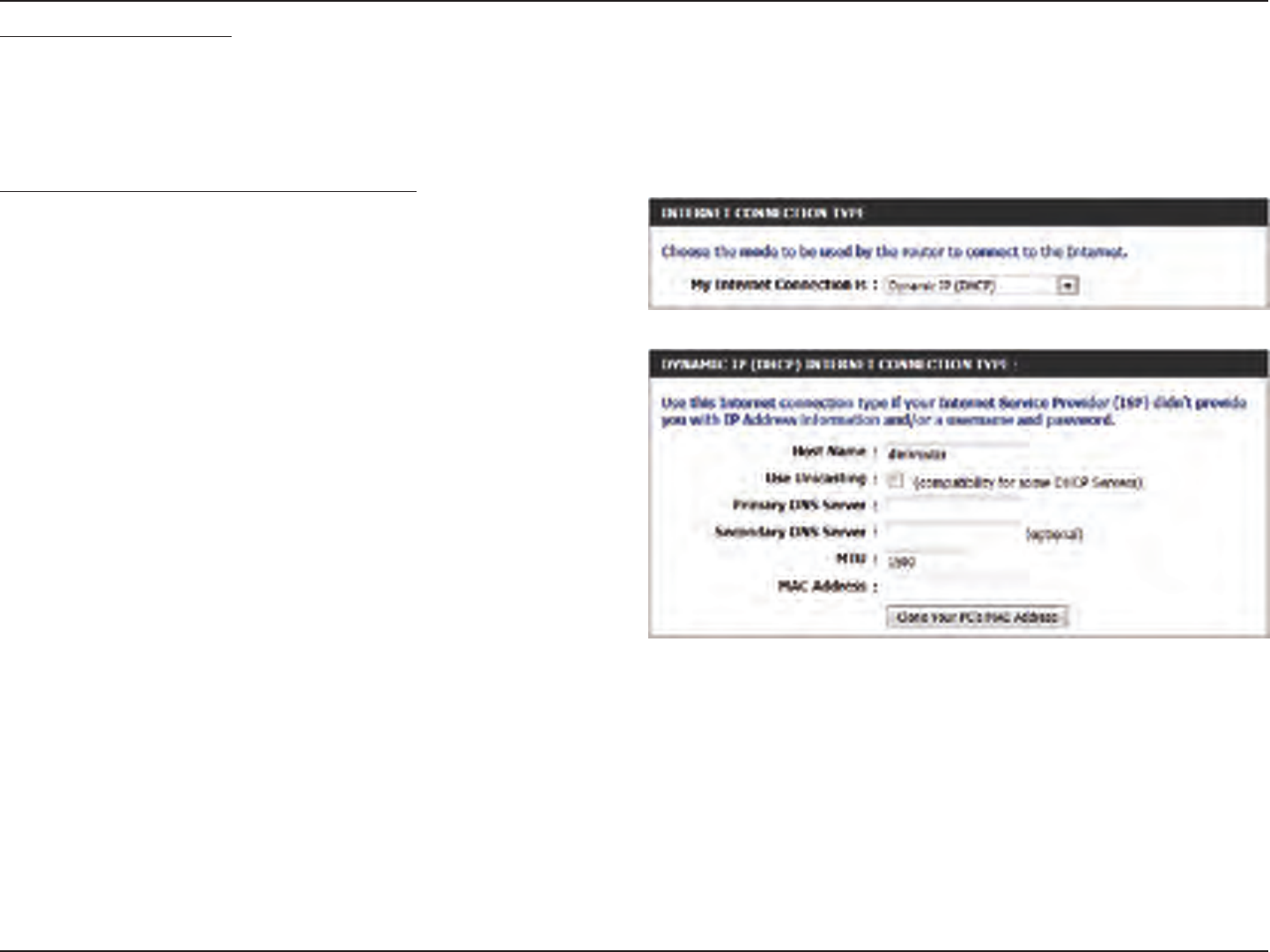
33D-Link DIR-850L User Manual
My Internet Connection is: Dynamic IP (DHCP)
The default WAN conguration for this router is Dynamic IP (DHCP). This
option allows the router to obtain an IP address automatically from the
device that is connected to the Internet port.
Note: If you’re not sure about the type of Internet Connection you have,
please contact your Internet Service Provider (ISP) for assistance.
After selecting Dynamic IP, the following parameters will be available for
conguration:
Host Name: The Host Name is optional but may be
required by some ISPs. Leave blank if you
are not sure.
Use Unicasting: Tick this option if you ISP uses the unicast
method to provide IP addresses.
Primary DNS: Enter the Primary DNS IP address used
here.
Secondary DNS: Enter the Secondary DNS IP address used
here. This eld is normally optional. Only
one DNS address is required for a func-
tional Internet connection, but using a
second DNS address provides more stabil-
ity.
MTU: Maximum Transmission Unit - you may need to change the MTU for optimal performance with your specic ISP.
1500 is the default MTU.
MAC Address: The default MAC Address is set to the Internet port’s physical interface MAC address on the Broadband Router. It
is not recommended that you change the default MAC address unless required by your ISP. You can use the Clone
Your PC’s MAC Address button to replace the Internet port’s MAC address with the MAC address of your Ethernet
card.
Internet Connection Type
In this section, the user can select from a list of Internet Connection types that can be congured and used on this router. Options to choose
from are Static IP, Dynamic IP, PPPoE, PPTP, L2TP, and DS-Lite.
After selecting a specic Internet Connection type, this page will automatically refresh and provide unique elds to congure related to the
specied Internet Connection type.
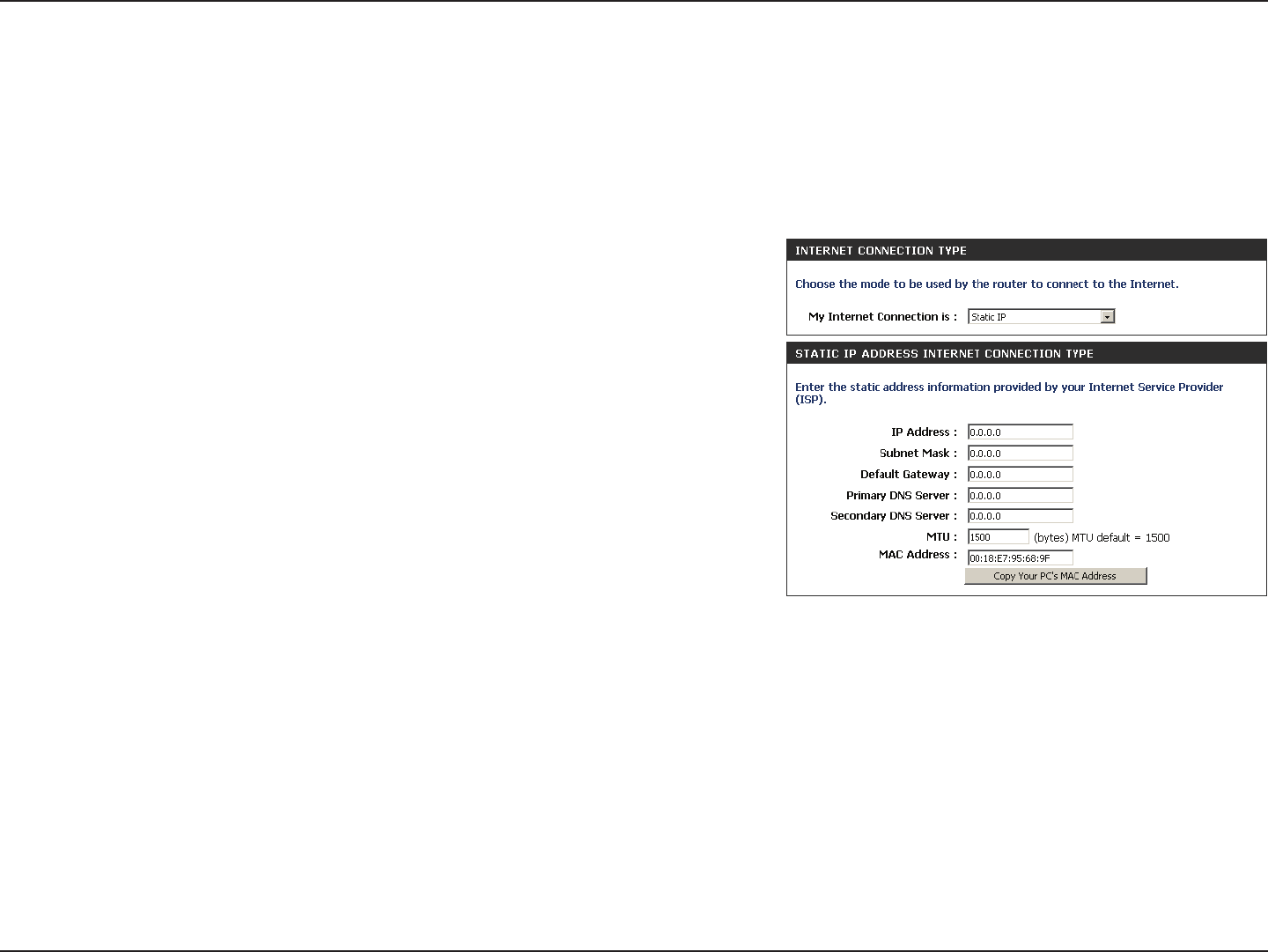
34D-Link DIR-850L User Manual
Section 3 - Conguration
Select Static IP to manually enter the IP settings supplied by
your ISP.
Enter the IP address assigned by your ISP.
Enter the Subnet Mask assigned by your ISP.
Enter the Gateway assigned by your ISP.
The DNS server information will be supplied by your ISP (Internet
Service Provider.)
Maximum Transmission Unit - you may need to change the MTU
for optimal performance with your specic ISP. 1500 is the default
MTU.
The default MAC Address is set to the Internet port’s physical
interface MAC address on the Broadband Router. It is not
recommended that you change the default MAC address unless
required by your ISP. You can use the Copy Your PC’s MAC
Address button to replace the Internet port’s MAC address with
the MAC address of your Ethernet card.
My Internet Connection:
IP Address:
Subnet Mask:
Default Gateway:
DNS Servers:
MTU:
MAC Address:
Manual Internet Setup
Static (assigned by ISP)
Select Static IP Address if all the Internet port’s IP information is provided to you by your ISP. You will need to enter in the IP address, subnet mask,
gateway address, and DNS address(es) provided to you by your ISP. Each IP address entered in the elds must be in the appropriate IP form, which
are four octets separated by a dot (x.x.x.x). The Router will not accept the IP address if it is not in this format.
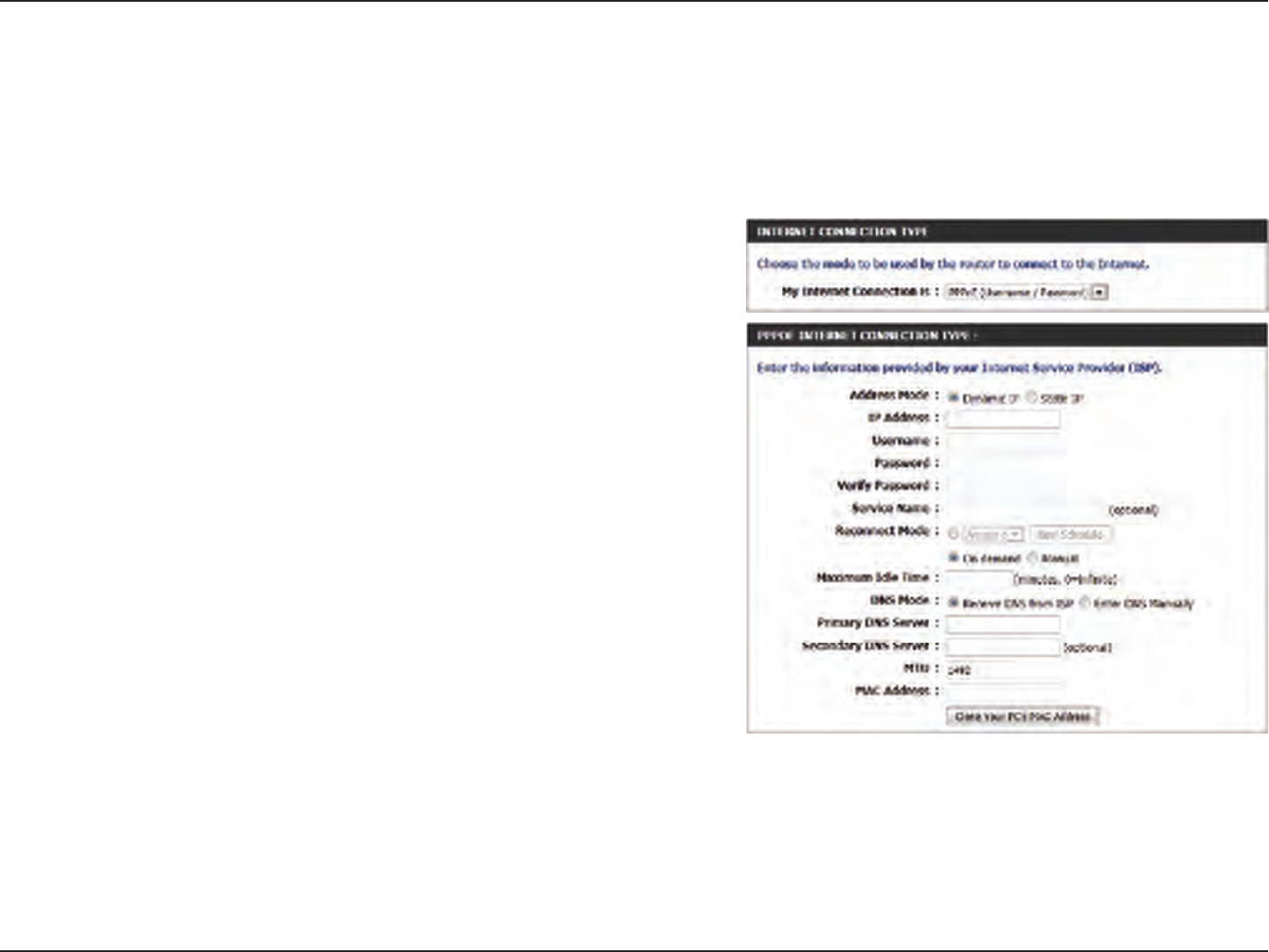
35D-Link DIR-850L User Manual
Section 3 - Conguration
Internet Setup
PPPoE (DSL)
Choose PPPoE (Point to Point Protocol over Ethernet) if your ISP uses a PPPoE connection. Your ISP will provide you with a
username and password. This option is typically used for DSL services. Make sure to remove your PPPoE software from your
computer. The software is no longer needed and will not work through a router.
My Internet Connection: Select PPPoE (Username/Password) from the drop-down
menu.
Address Mode: Here the user can specify whether this Internet connection
requires the use of a Dynamic or Static IP address. PPPoE usually
requires a Dynamic IP conguration.
IP Address: Enter the PPPoE IP address used here. This option is only avail-
able if Static IP is selected.
Username: Enter the PPPoE account user name used here. This information is
given by the ISP.
Password: Enter the PPPoE account password used here. This information is
given by the ISP.
Verify Password: Re-enter the PPPoE account password used here.
Service Name: This optional eld enables the user to enter a service name to
identify this Internet connection here.
Reconnect Mode: Use the radio buttons to specify the reconnect mode. The user
can specify a custom schedule or specify the On Demand, or
Manual option. To specify a custom schedule, use the drop-
down menu to select one of the schedules that has been dened
in the Schedules page.
To create a new schedule, click the New Schedule button to open the Schedules page. Schedules will be discussed later.

36D-Link DIR-850L User Manual
Section 3 - Conguration
Maximum Idle Time: Enter a maximum idle time during which the Internet connection is maintained during inactivity.
DNS Mode: This option allow the router to obtain the DNS IP addresses from the ISP, when Receive DNS from ISP is selected,
or allows the user to enter DNS IP address manually, when Enter DNS Manually is selected.
Primary DNS Server: Enter the Primary DNS IP address used here.
Secondary DNS Server: Enter the Secondary DNS IP address used here. This eld is normally optional. Only one DNS address is required for
a functional Internet connection, but using a second DNS address provides more stability.
MTU: Maximum Transmission Unit - you may need to change the MTU for optimal performance with your specic ISP.
1492 is the default MTU.
MAC Address: The default MAC Address is set to the Internet port’s physical interface MAC address on the Broadband Router. It
is not recommended that you change the default MAC address unless required by your ISP. You can use the Clone
Your PC’s MAC Address button to replace the Internet port’s MAC address with the MAC address of your Ethernet
card.
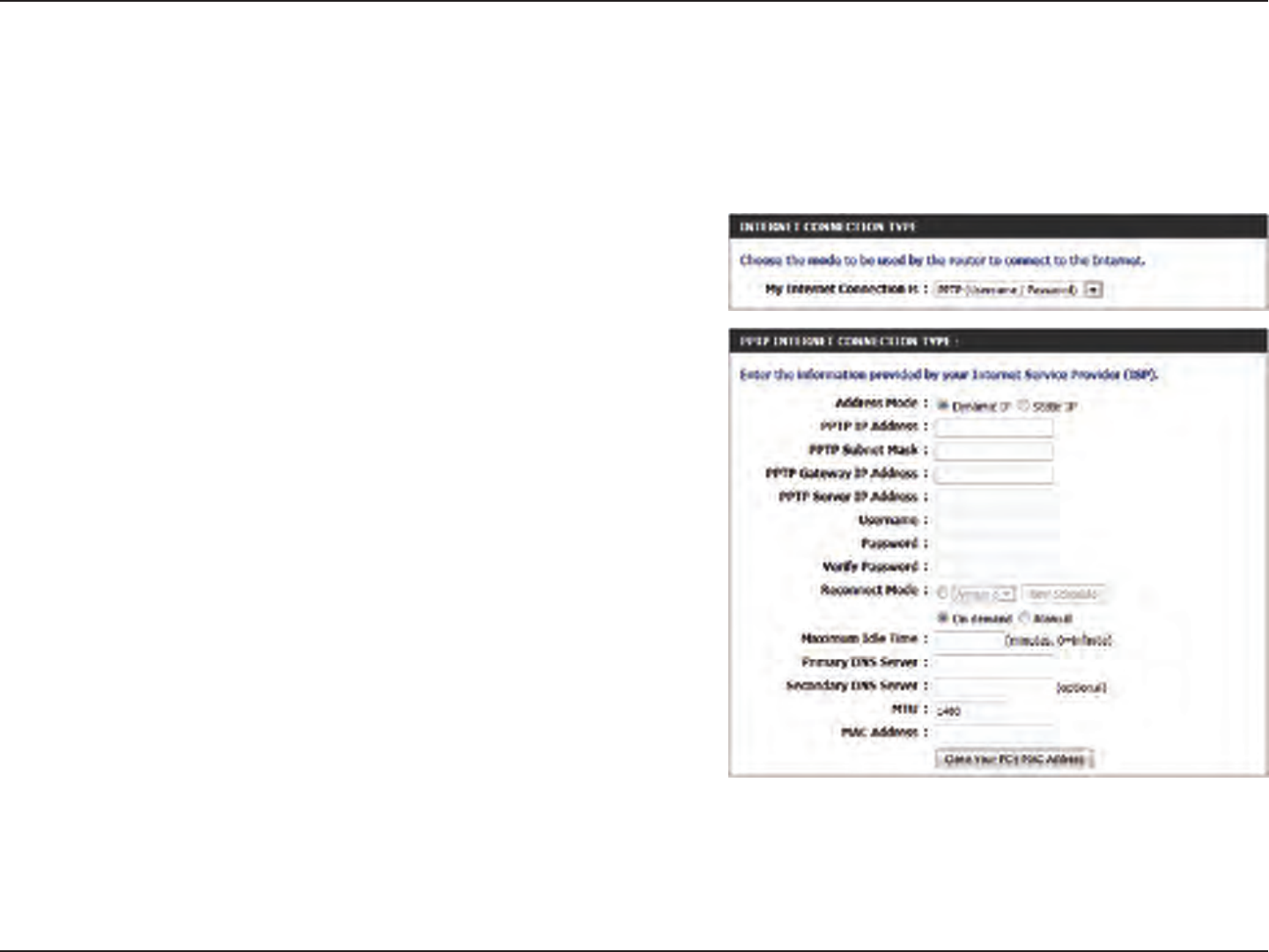
37D-Link DIR-850L User Manual
Section 3 - Conguration
Internet Setup
PPTP
Choose PPTP (Point-to-Point-Tunneling Protocol ) if your ISP uses a PPTP connection. Your ISP will provide you with a username
and password. This option is typically used for DSL services.
My Internet Connection: Select PPTP (Username/Password) from the drop-
down menu.
Address Mode: Here the user can specify whether this Internet
connection requires the use of a Dynamic or Static
IP address. PPTP usually requires a Dynamic IP
conguration.
PPTP IP Address: Enter the PPTP IP address used here. This option is
only available if Static IP is selected.
PPTP Subnet Mask: Enter the PPTP Subnet Mask used here.
PPTP Gateway IP Address: Enter the PPTP Gateway IP address used here.
PPTP Server IP Address: Enter the PPTP Server IP address used here. This is
normally the same a the PPTP Gateway IP address.
Username: Enter the PPTP username used here.
Password: Enter the PPTP password used here.
Verify Password: Re-enter the PPTP password used here.
Reconnect Mode: Use the radio buttons to specify the reconnect mode.
The user can specify a custom schedule or specify the On
Demand, or Manual option. To specify a custom schedule,
use the drop-down menu to select one of the schedules
that has been dened in the Schedules page. To create a
new schedule, click the New Schedule button to open the
Schedules page. Schedules will be discussed later.
Maximum Idle Time: Enter a maximum idle time during which the Internet connection is maintained during inactivity. To disable this
feature, enable Auto-reconnect.

38D-Link DIR-850L User Manual
Section 3 - Conguration
Primary DNS Server: Enter the Primary DNS IP address used here.
Secondary DNS Server: Enter the Secondary DNS IP address used here. This eld is normally optional. Only one DNS address is required for
a functional Internet connection, but using a second DNS address provides more stability.
MTU: Maximum Transmission Unit - you may need to change the MTU for optimal performance with your specic ISP.
1400 is the default MTU.
MAC Address: The default MAC Address is set to the Internet port’s physical interface MAC address on the Broadband Router. It
is not recommended that you change the default MAC address unless required by your ISP. You can use the Clone
Your PC’s MAC Address button to replace the Internet port’s MAC address with the MAC address of your Ethernet
card.

39D-Link DIR-850L User Manual
Section 3 - Conguration
Internet Setup
L2TP
Choose L2TP (Layer 2 Tunneling Protocol) if your ISP uses a L2TP connection. Your ISP will provide you with a username and
password. This option is typically used for DSL services.
My Internet
Connection:
Select L2TP (Username/Password) from the drop-
down menu.
Address Mode: Here the user can specify whether this Internet
connection requires the use of a Dynamic or Static
IP address. L2TP usual requires a Dynamic IP con-
guration.
L2TP IP Address: Enter the L2TP IP address used here. This option is
only available if Static IP is selected.
L2TP Subnet Mask: Enter the L2TP Subnet Mask used here.
L2TP Gateway IP
Address:
Enter the L2TP Gateway IP address used here.
L2TP Server IP
Address:
Enter the L2TP Server IP address used here. This is
normally the same a the L2TP Gateway IP address.
Username: Enter the L2TP username used here.
Password: Enter the L2TP password used here.
Verify Password: Re-enter the L2TP password used here.
Reconnect Mode: Use the radio buttons to specify the reconnect
mode. The user can specify a custom schedule
or specify the On Demand, or Manual option. To
specify a custom schedule, use the drop-down
menu to select one of the schedules that has been
dened in the Schedules page. To create a new
schedule, click the New Schedule button to open
the Schedules page. Schedules will be discussed
later.

40D-Link DIR-850L User Manual
Section 3 - Conguration
Maximum Idle Time: Enter a maximum idle time during which the Internet connection is maintained during inactivity. To disable this
feature, enable Auto-reconnect.
Primary DNS Server: Enter the Primary DNS IP address used here.
Secondary DNS Server: Enter the Secondary DNS IP address used here. This eld is normally optional. Only one DNS address is required for
a functional Internet connection, but using a second DNS address provides more stability.
MTU: Maximum Transmission Unit - you may need to change the MTU for optimal performance with your specic ISP.
1400 is the default MTU.
MAC Address: The default MAC Address is set to the Internet port’s physical interface MAC address on the Broadband Router. It
is not recommended that you change the default MAC address unless required by your ISP. You can use the Clone
Your PC’s MAC Address button to replace the Internet port’s MAC address with the MAC address of your Ethernet
card.
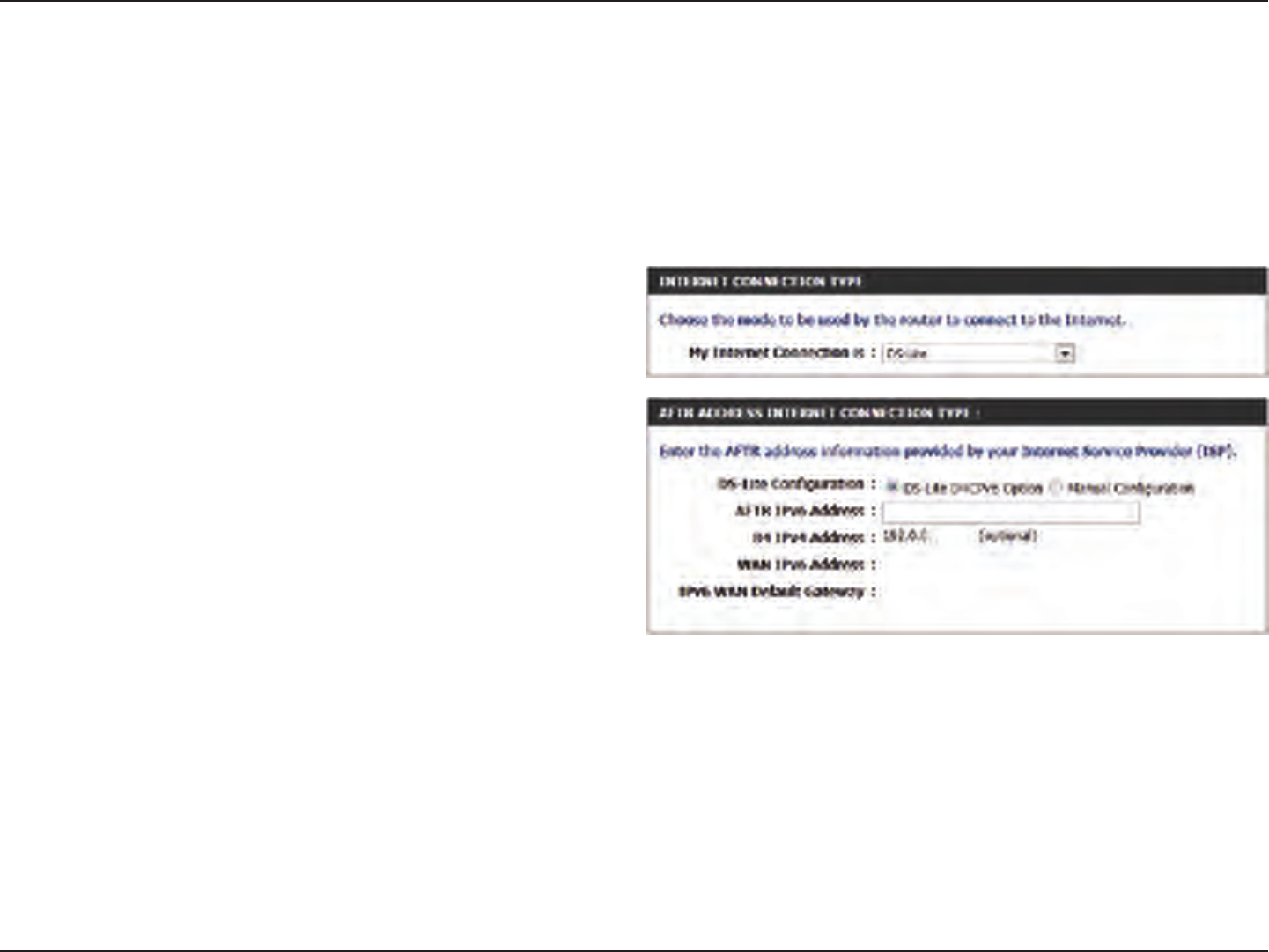
41D-Link DIR-850L User Manual
Section 3 - Conguration
Internet Setup
DS-Lite
Another Internet Connection type is DS-Lite.
DS-Lite is an IPv6 connection type. After selecting DS-Lite, the following parameters will be available for conguration:
DS-Lite Conguration: Select the DS-Lite DHCPv6 Option to let
the router allocate the AFTR IPv6 address
automatically. Select the Manual Congu-
ration to enter the AFTR IPv6 address in
manually.
AFTR IPv6 Address: After selecting the Manual Conguration
option above, the user can enter the AFTR
IPv6 address used here.
B4 IPv4 Address: Enter the B4 IPv4 address value used here.
WAN IPv6 Address: Once connected, the WAN IPv6 address
will be displayed here.
IPv6 WAN Default Gateway Once connected, the IPv6 WAN Default
Gateway address will be displayed here.
Click on the Save Settings button to accept the changes made.
Click on the Don’t Save Settings button to discard the changes made.
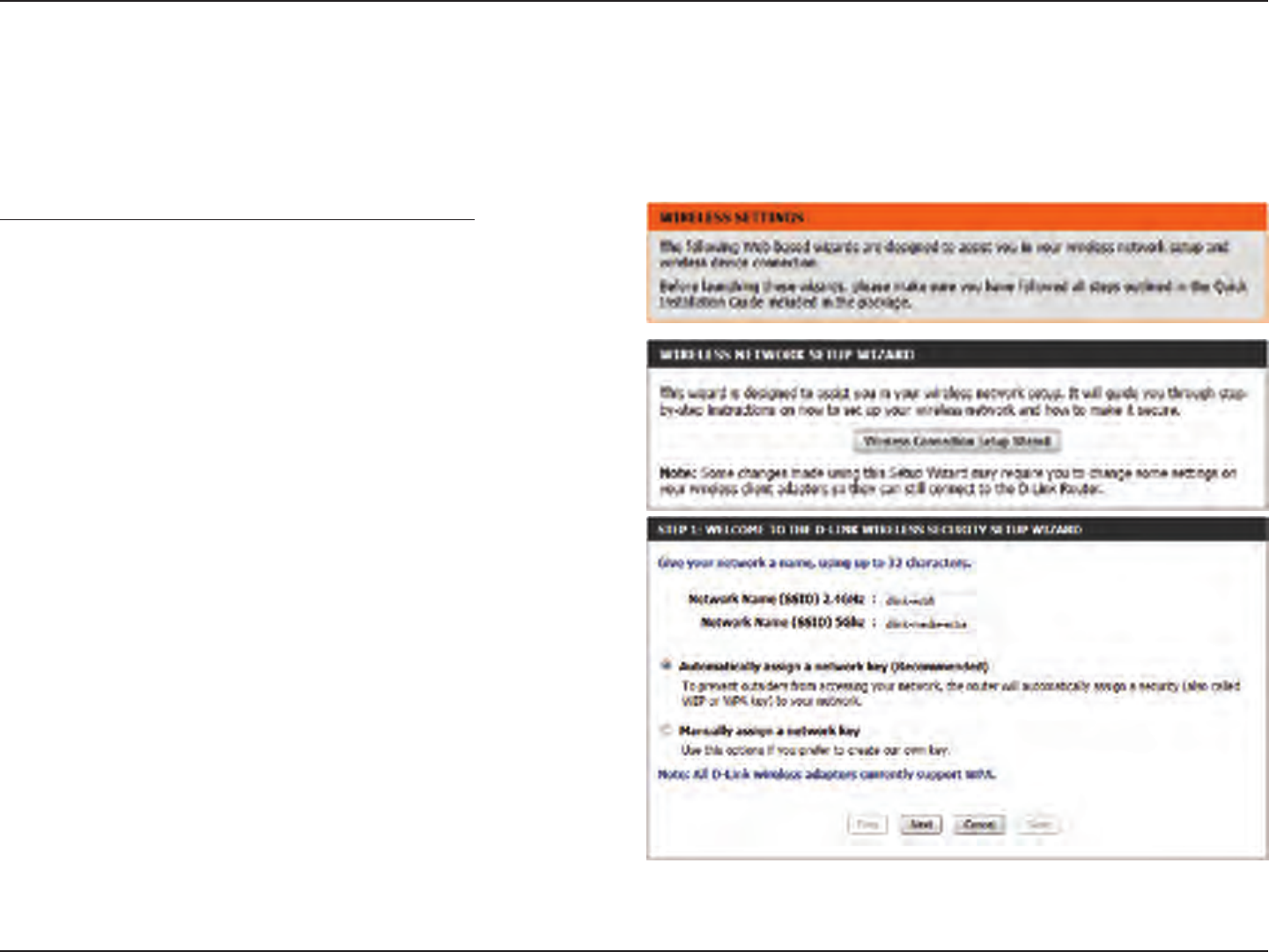
42D-Link DIR-850L User Manual
On this page the user can congure the Wireless settings for this device. There are 3 ways to congure Wireless using this router. Firstly, the user
can choose to make use for the quick and easy Wireless Connection Setup Wizard. Secondly, the user can choose to make use Wi-Fi Protected
Setup. Lastly, the user can congure the Wireless settings manually.
Wireless Settings: Wireless Connection Setup Wizard
The Wireless Connection Setup Wizard is specially designed to assist
basic network users with a simple, step-by-step set of instructions to
congure the wireless settings of this router. It is highly recommended
to customized the wireless network settings to t into your environment
and to add higher security.
Step 1: In this step, the user must enter a custom Wireless Network
Name or SSID. Enter the new Network Name (SSID) in the appropriate
space provided.
There are seperate spaces provided for a 2.4GHz Network Name and a
5GHz Network Name.
Secondly the user can choose between two wireless security wizard
congurations. The user can select ‘Automatically assign a network
key’, by which the router will automatically generate a WPA/WPA2 pre-
shared key using the TKIP and AES encryption methods; or the user
can select ‘Manually assign a network key’, by which the user will be
prompt to manually enter a WPA/WPA2 pre-shared key using the TKIP
and AES encryption methods.
Click on the Prev button to return to the previous page. Click on the
Next button to continue to the next page. Click on the Cancel button to
discard the changes made and return to the main wireless page.
To initiate the Wireless Connection Setup Wizard click on the Wireless
Connection Setup Wizard button.
Wireless connection setup wizard
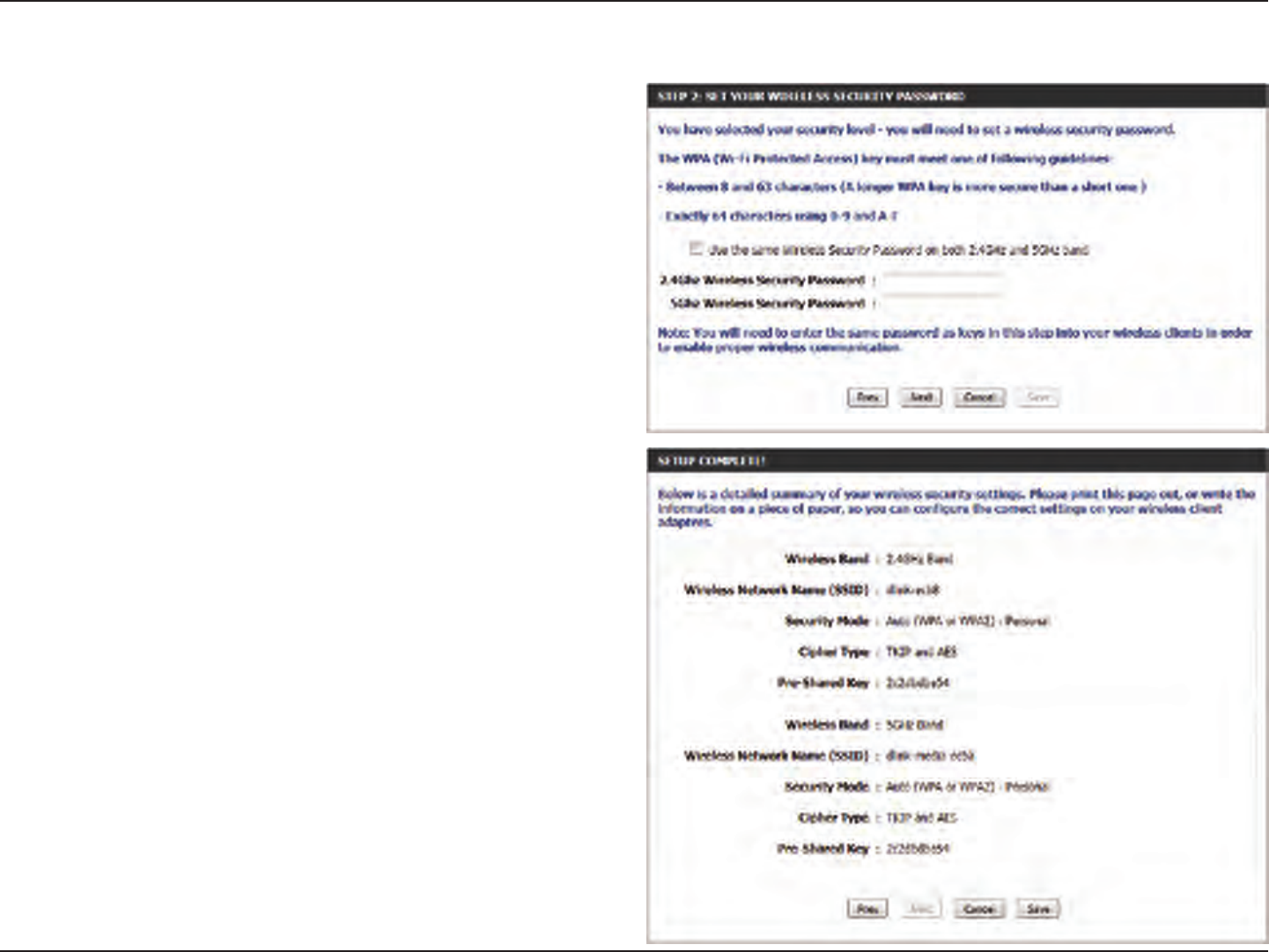
43D-Link DIR-850L User Manual
Step 2: This step will only be available if the user selected ‘Manually
assign a network key’ in the previous step. Here the user can manually
enter the WPA/WPA2 pre-shared key in the Wireless Security Password
space provided. The key entered must be between 8 and 63 characters
long. Remember, this key will be used when wireless clients wants to
connect to this device. So please remember this key to prevent future
troubleshooting.
If you want to use the same Wireless Security Password for both 2.4GHz
and 5GHz bands, tick the option provided. If not selected, you need
to input two seperate Wireless Security Passwords for each individual
Wireless band.
Click on the Prev button to return to the previous page. Click on the
Next button to continue to the next page. Click on the Cancel button to
discard the changes made and return to the main wireless page.
Setup Complete: On this page the user can view the conguration
made and verify whether they are correct.
Click on the Prev button to return to the previous page. Click on the
Cancel button to discard the changes made and return to the main
wireless page. Click on the Save button to accept the changes made.
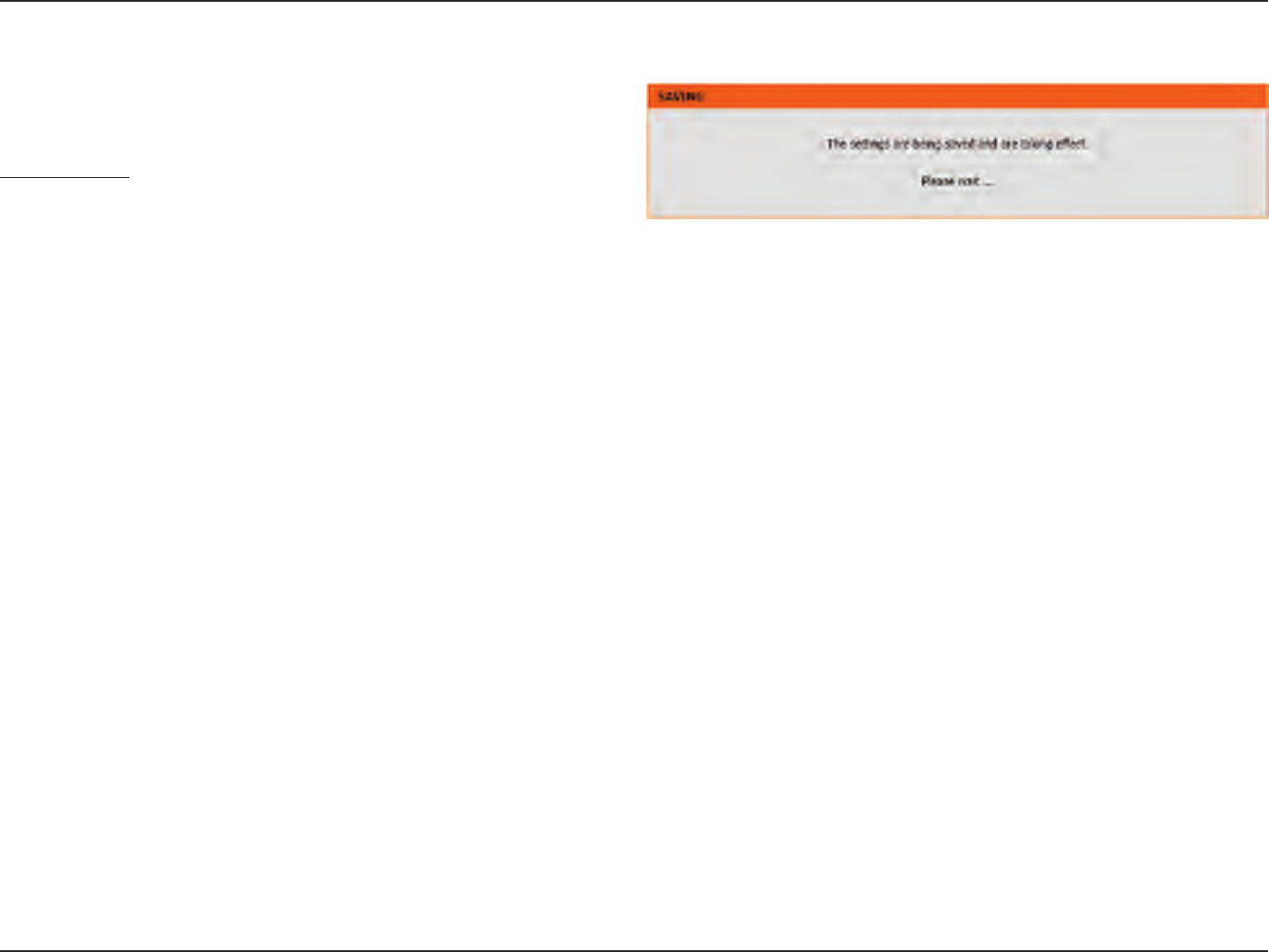
44D-Link DIR-850L User Manual
After click the Save button the device will save the settings made and
return to the main wireless page.
End of Wizard.
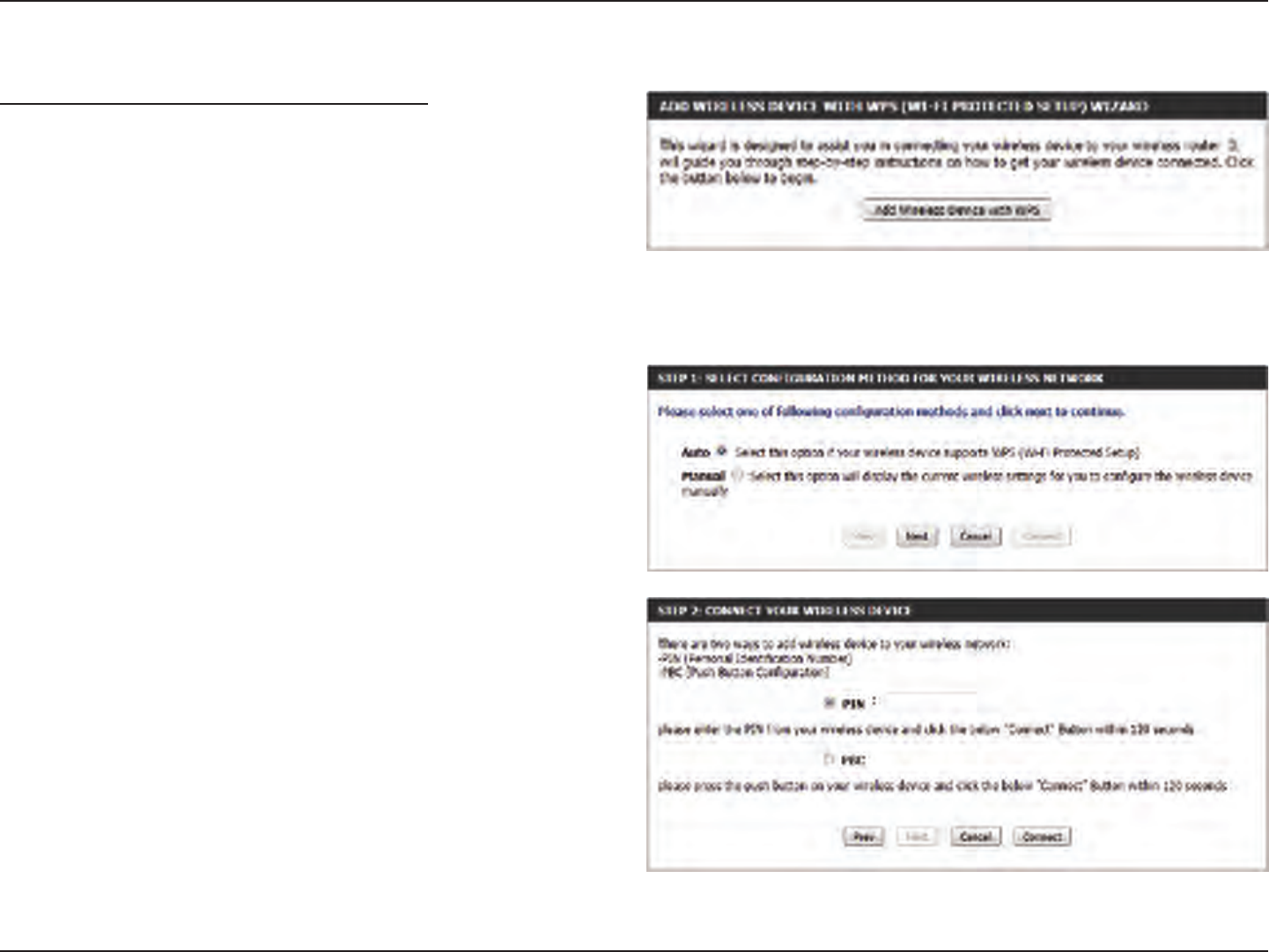
45D-Link DIR-850L User Manual
Wireless Settings: Wi-Fi Protected Setup Wizard
If your Wireless Clients support the WPS connection method, this Wi-Fi
Protected Setup Wizard can be used to initiate a wireless connection
between this device and Wireless clients with a simple click of the WPS
button. The Wi-Fi Protected Setup Wizard is specially designed to assist
basic network users with a simple, step-by-step set of instructions to
connect wireless clients to this router using the WPS method.
To initiate the Wi-Fi Protected Setup Wizard click on the Add Wireless
Device with WPS button.
Step 1: In this step the user have two options to choose from. You can
choose Auto if the wireless client supports WPS, or Manual if the wire-
less client does not support WPS.
Click on the Prev button to return to the previous page. Click on the
Next button to continue to the next page. Click on the Cancel button to
discard the changes made and return to the main wireless page.
Step 2: After selecting Auto, the following page will appear. There are
two ways to add a wireless device, that supports WPS. Firstly, there is the
Personal Identication Number (PIN) method. Using this method will
prompt the user to enter a PIN code. This PIN code should be identical
on the wireless client. Secondly, there is the Push Button Conguration
(PBC) method. Using this method will allow the wireless client to con-
nect to this device by similarly pressing the PBC button on it.
Click on the Prev button to return to the previous page. Click on the
Next button to continue to the next page. Click on the Cancel button to
discard the changes made and return to the main wireless page.
Wi-Fi Protected Setup Wizard
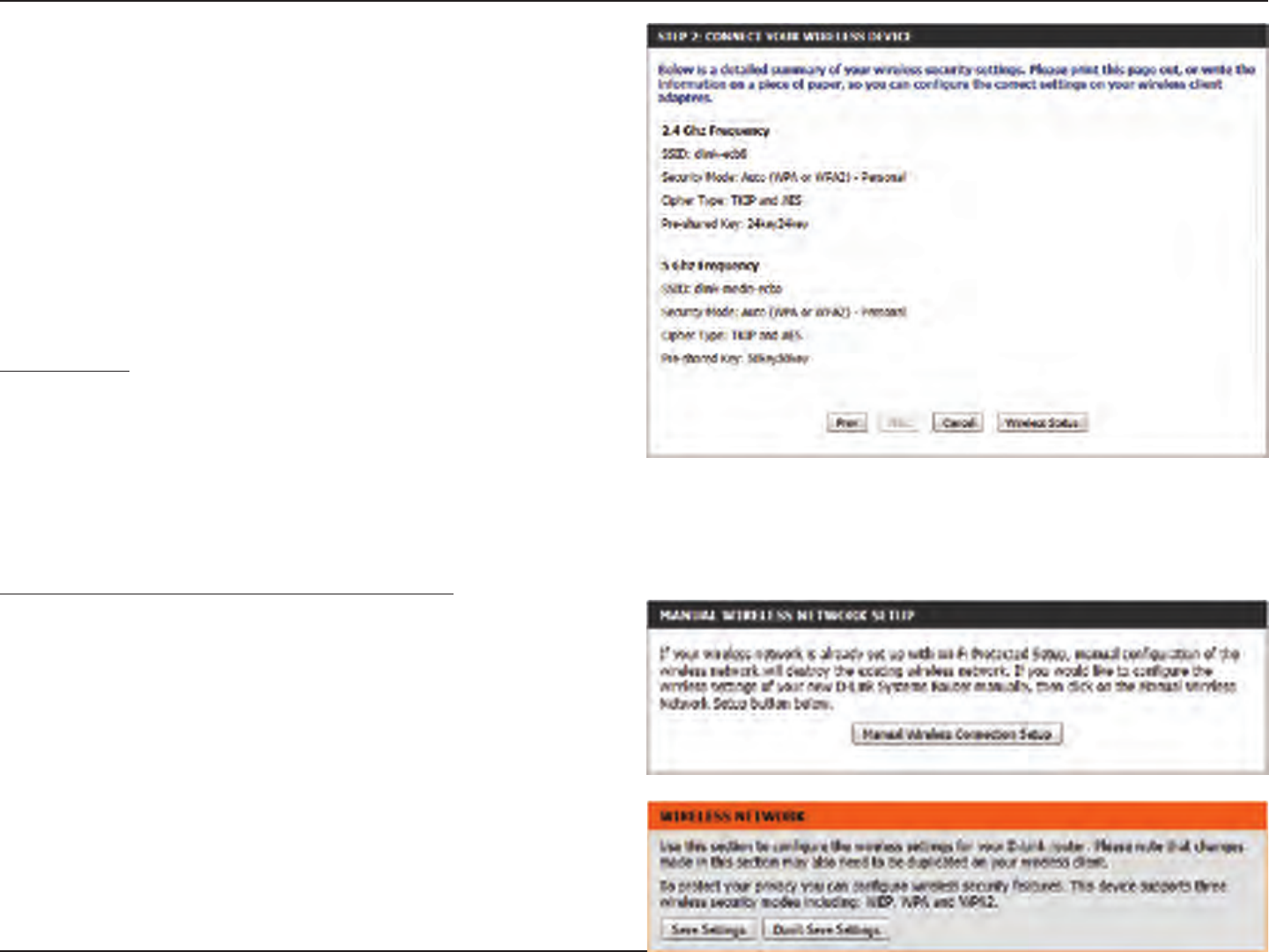
46D-Link DIR-850L User Manual
Step 2: After selecting Manual, the following page will appear. On this
page to user can view the wireless conguration of this router. The wire-
less clients should congure their wireless settings to be identical to the
settings displayed on this page for a successful connection. This option
is for wireless clients that can’t use the WPS method to connect to this
device.
Click on the Prev button to return to the previous page. Click on the
Next button to continue to the next page. Click on the Cancel button to
discard the changes made and return to the main wireless page. Click
on the Wireless Status button to navigate to the Status > Wireless page
to view what wireless client are connected to this device.
End of Wizard.
Wireless Settings: Manual Wireless Network Setup
The manual wireless network setup option allows users to congure
the wireless settings of this device manually. This option is for the more
advanced user and includes all parameters that can be congured for
wireless connectivity.
To initiate the Manual Wireless Setup page, click on the Manual Wire-
less Connection Setup button.
On this page the user can congure all the parameters related to the
wireless connectivity of this router.
Manual wireless network setup
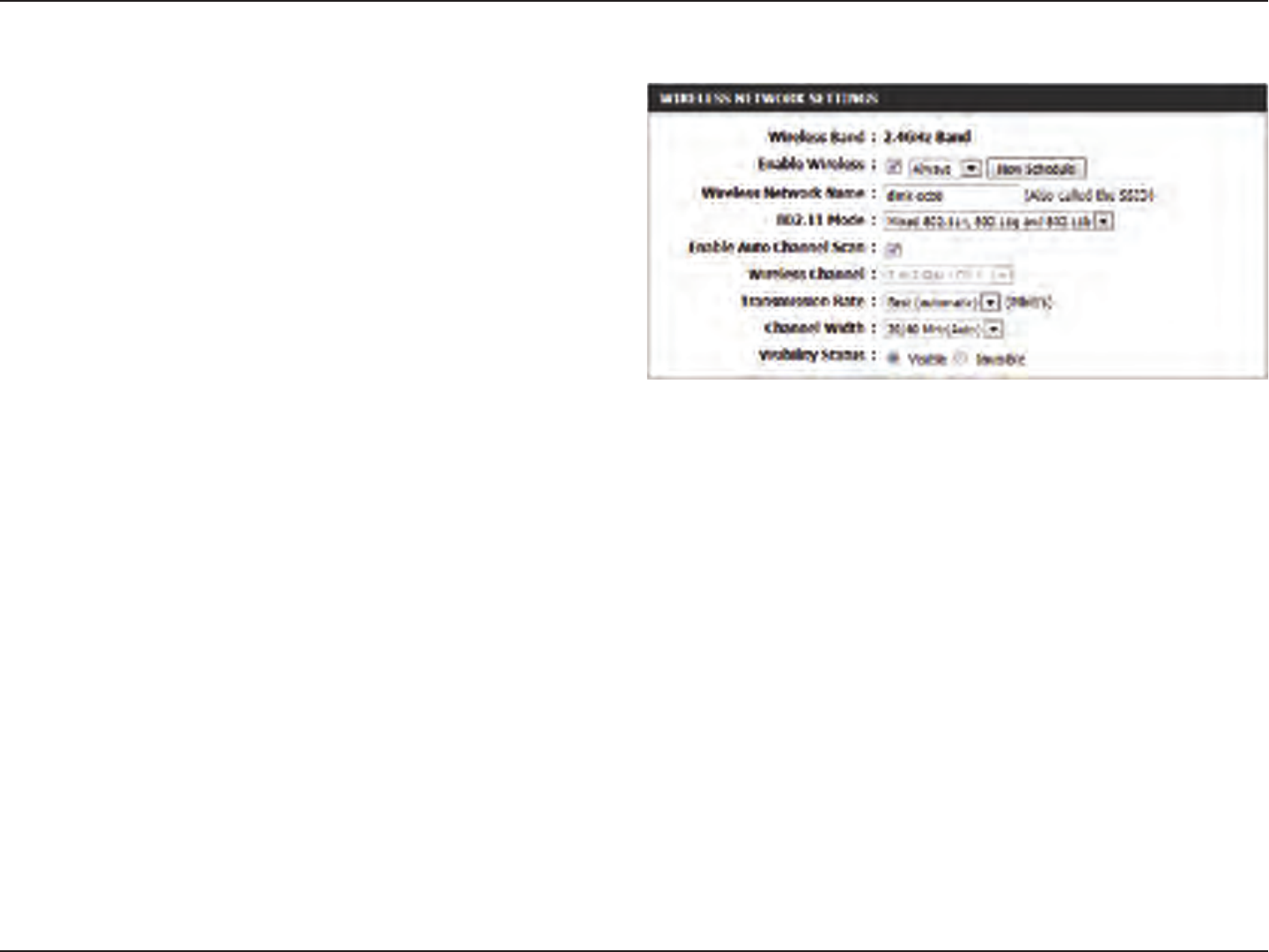
47D-Link DIR-850L User Manual
The following parameters will be available for conguration:
Wireless Band: Displays the wireless band being cong-
ured. In this option we nd that the fol-
lowing parameters will be regarding the
2.4GHz band.
Enable Wireless: Check the box to enable the wireless func-
tion. If you do not want to use wireless,
uncheck the box to disable all the wireless
functions. Select the time frame that you
would like your wireless network enabled.
The schedule may be set to Always. Any
schedule you create will be available in
the drop-down menu. Click New Schedule
to create a new schedule.
Wireless Network Name: The Service Set Identier (SSID) is the name of your wireless network. Create a name using up to 32 characters. The
SSID is case-sensitive. Enable Auto Channel
802.11 Mode: Here the user can manually select the preferred frequency band to use for this wireless network.
Enable Auto Channel Scan: The auto channel selection setting can be selected to allow this device to choose the channel with the least
amount of interference.
Wireless Channel: By default the channel is set to 1. The Channel can be changed to t the channel setting for an existing wireless
network or to customize the wireless network. If you enable Auto Channel Selection, this option will be greyed out.
Transmission Rate: Select the transmit rate. It is strongly suggested to select Best (Automatic) for best performance.
Channel Width: When using the 802.11n frequency band, the user have an option to choose between a 20MHz or 20/40MHz band-
width.
Visibility Status: The Invisible option allows you to hide your wireless network. When this option is set to Visible, your wireless
network name is broadcasted to anyone within the range of your signal. If you are not using encryption then they
could connect to your network. When Invisible mode is enabled, you must enter the Wireless Network Name (SSID)
on the client manually to connect to the network.
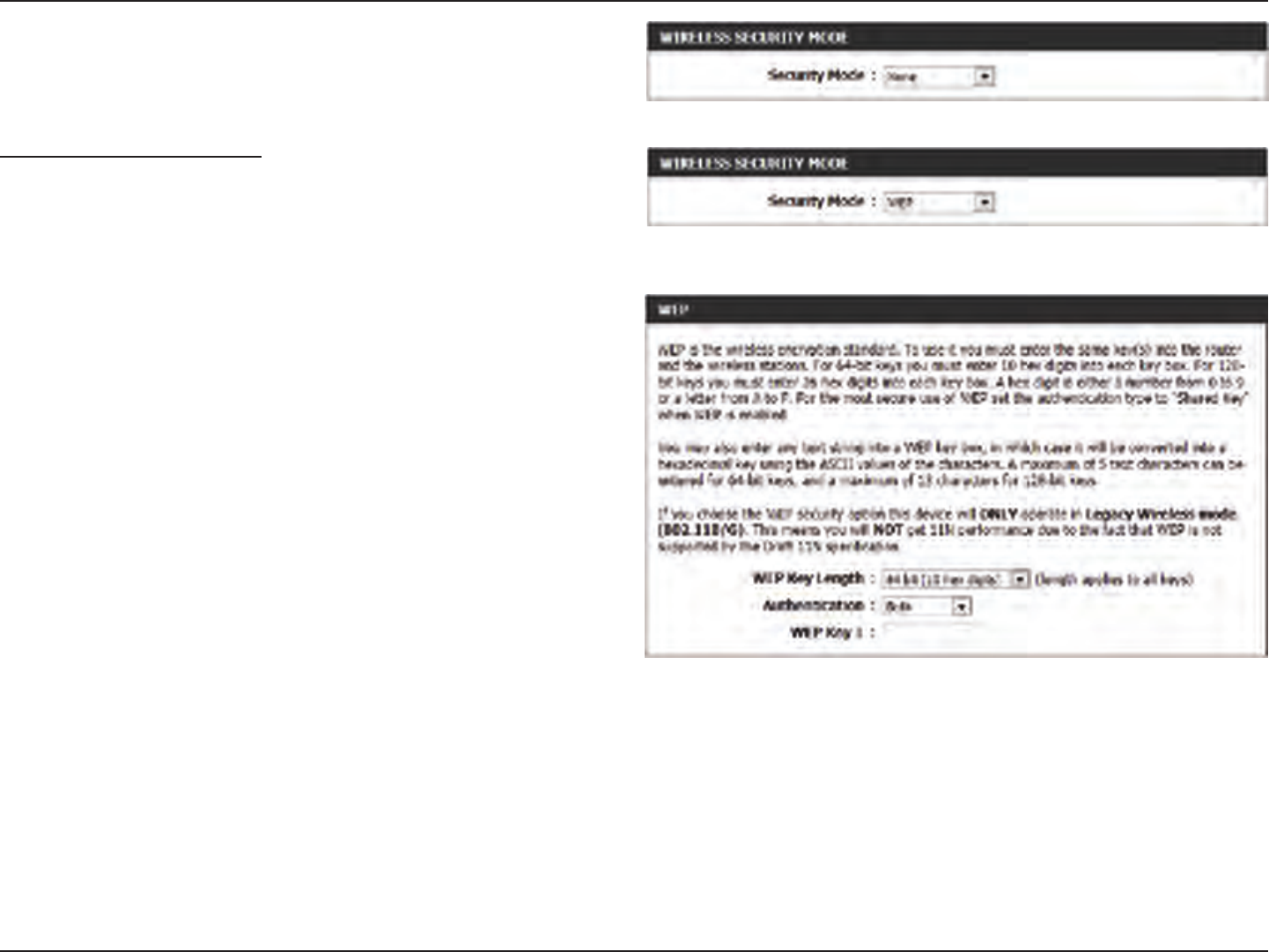
48D-Link DIR-850L User Manual
By default the wireless security of this router will be disabled. In this
next option the user can enabled or disable wireless security for the
frequency band 2.4GHz. There are two types of encryption that can be
used. WEP or WPA/WPA2.
Wireless Security Mode: WEP
Wired Equivalent Privacy (WEP) is the most basic form of encryption
that can be used for wireless networks. Even though it is known as a
‘weak’ security method, it is better than no security at all. Older wireless
adapter sometimes only supports WEP encryption and thus we still nd
this encryption method used today.
The following parameters will be available for conguration:
WEP Key Length: Here the user can specify to either use a
64Bit or a 128Bit encrypted key.
Authentication: Authentication is a process by which the
router veries the identity of a network
device that is attempting to join the wire-
less network. There are two types authen-
tication for this device when using WEP.
Open System allows all wireless devices
to communicate with the router before
they are required to provide the encryp-
tion key needed to gain access to the
network. Shared Key requires any wire-
less device attempting to communicate
with the router to provide the encryption
key needed to access the network before
they are allowed to communicate with the
router.
WEP Key 1: Enter the WEP key used here. For 64-bit keys you must enter 10 hex digits into each key box. For 128-bit keys you
must enter 26 hex digits into each key box. A hex digit is either a number from 0 to 9 or a letter from A to F. You
may also enter any text string into a WEP key box, in which case it will be converted into a hexadecimal key using
the ASCII values of the characters. A maximum of 5 text characters can be entered for 64-bit keys, and a maximum
of 13 characters for 128-bit keys.
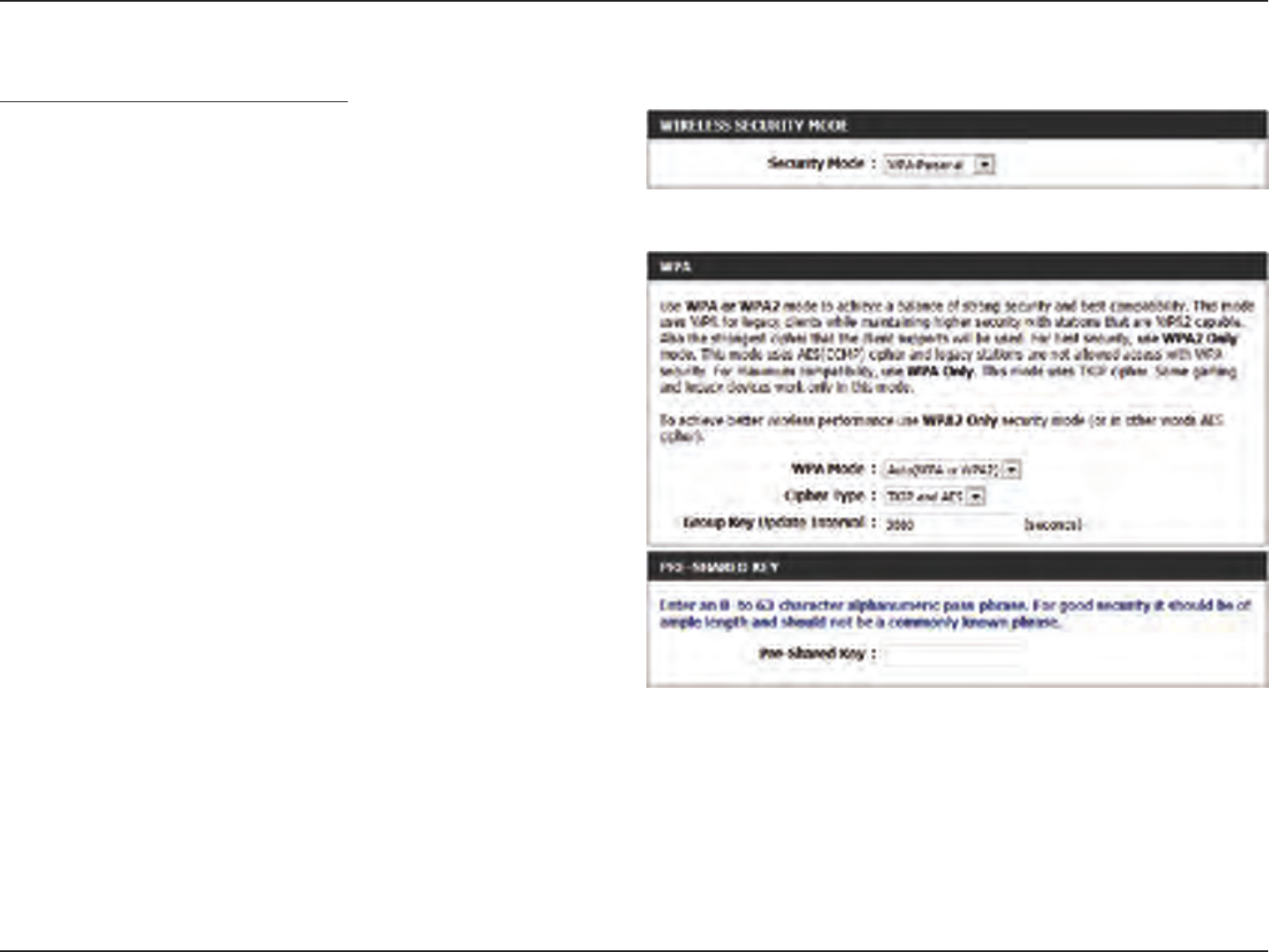
49D-Link DIR-850L User Manual
Wireless Security Mode: WPA-Personal
Wi-Fi Protected Access (WPA) is the most advanced and up to date wire-
less encryption method used today. This is the recommended wireless
security option. WPA supports two authentication frameworks. Personal
(PSK) and Enterprise (EAP). Personal requires only the use of a pass-
phrase (Shared Secret) for security.
The following parameters will be available for conguration:
WPA Mode: WPA is the older standard; select this op-
tion if the clients that will be used with the
router only support the older standard.
WPA2 is the newer implementation of the
stronger IEEE 802.11i security standard.
With the “WPA2” option, the router tries
WPA2 rst, but falls back to WPA if the
client only supports WPA. With the “WPA2
Only” option, the router associates only
with clients that also support WPA2 secu-
rity.
Cipher Type: Select the appropriate cipher type to use
here. Options to choose from are Temporal
Key Integrity Protocol (TKIP), Advanced
Encryption Standard (AES), and Both (TKIP
and AES).
Group Key Update Interval: Enter the amount of time before the group
key used for broadcast and multicast data
is changed.
Pre-Shared Key: Enter the shared secret used here. This
secret phrase needs to be the same on all
of the wireless clients for them to be able
to connect to the wireless network suc-
cessfully.
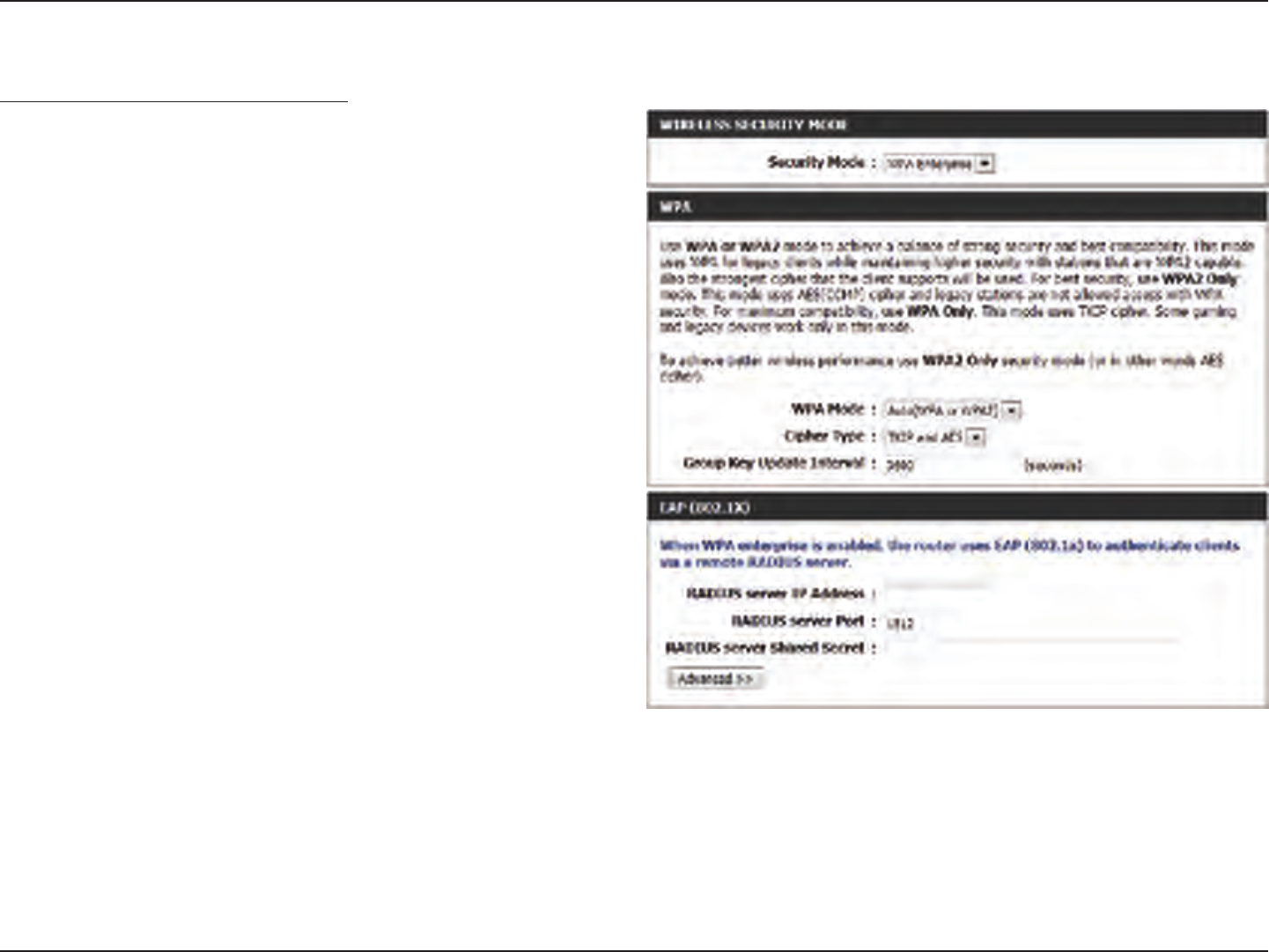
50D-Link DIR-850L User Manual
Wireless Security Mode: WPA-Personal
Wi-Fi Protected Access (WPA) is the most advanced and up to date wire-
less encryption method used today. This is the recommended wireless
security option. WPA supports two authentication frameworks. Personal
(PSK) and Enterprise (EAP). Personal requires only the use of a pass-
phrase (Shared Secret) for security.
The following parameters will be available for conguration:
WPA Mode: WPA is the older standard; select this op-
tion if the clients that will be used with the
router only support the older standard.
WPA2 is the newer implementation of the
stronger IEEE 802.11i security standard.
With the “WPA2” option, the router tries
WPA2 rst, but falls back to WPA if the
client only supports WPA. With the “WPA2
Only” option, the router associates only
with clients that also support WPA2 secu-
rity.
Cipher Type: Select the appropriate cipher type to use
here. Options to choose from are Temporal
Key Integrity Protocol (TKIP), Advanced
Encryption Standard (AES), and Both (TKIP
and AES).
Group Key Update Interval: Enter the amount of time before the group
key used for broadcast and multicast data
is changed.
RADIUS Server IP Address: When the user chooses to use the EAP
authentication framework, the RADIUS
server’s IP address can be entered here.
RADIUS Server Port: When the user chooses to use the EAP authentication framework, the RADIUS server’s port number can be entered
here.
RADIUS Server Shared
Secret:
Enter the shared secret used here. This secret phrase needs to be the same on all of the wireless clients for them to
be able to connect to the wireless network successfully.
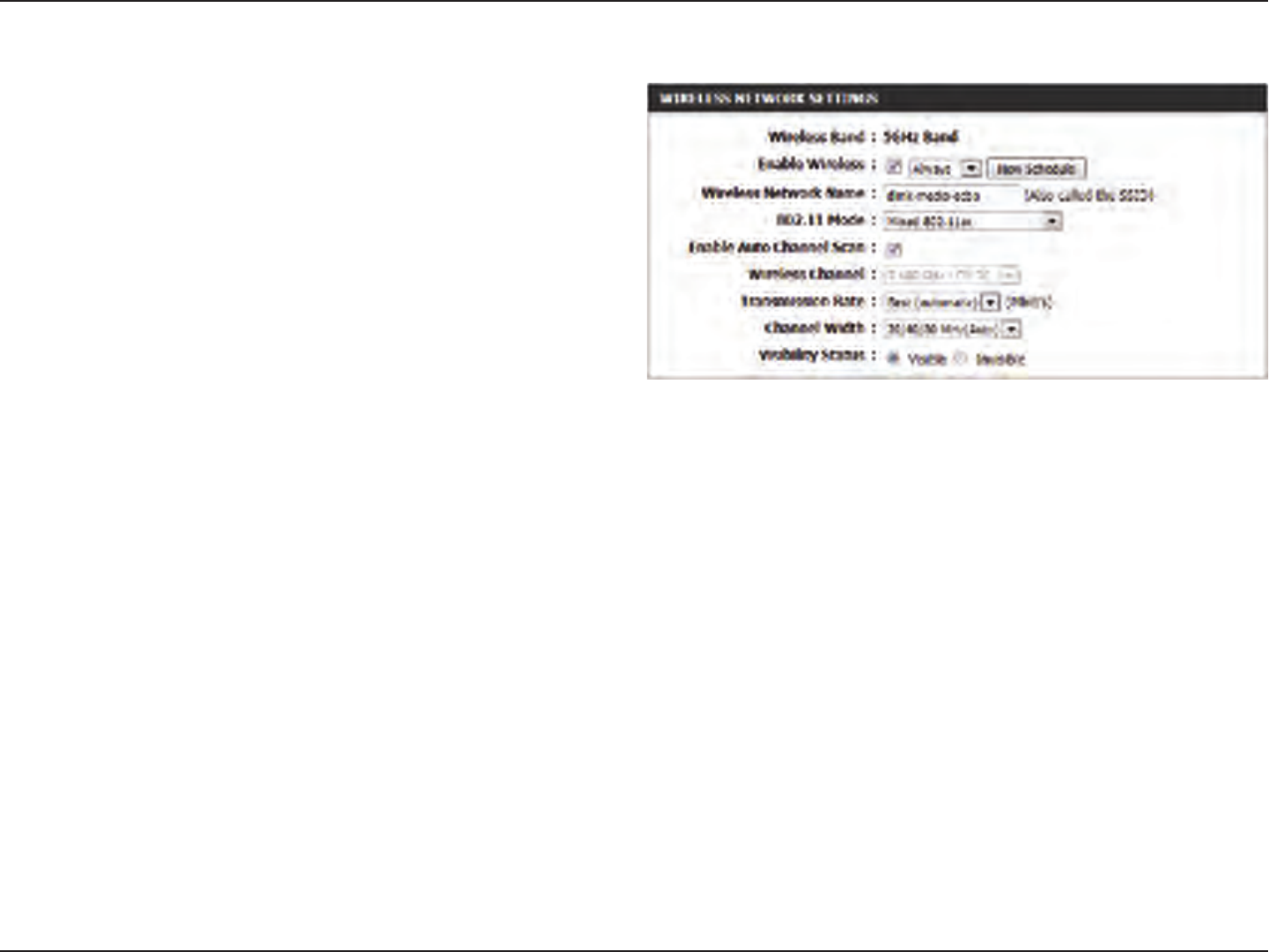
51D-Link DIR-850L User Manual
The following parameters will be available for conguration:
Wireless Band: Displays the wireless band being cong-
ured. In this option we nd that the fol-
lowing parameters will be regarding the
5GHz band.
Enable Wireless: Check the box to enable the wireless func-
tion. If you do not want to use wireless,
uncheck the box to disable all the wireless
functions. Select the time frame that you
would like your wireless network enabled.
The schedule may be set to Always. Any
schedule you create will be available in
the drop-down menu. Click New Schedule
to create a new schedule.
Wireless Network Name: The Service Set Identier (SSID) is the name of your wireless network. Create a name using up to 32 characters. The
SSID is case-sensitive. Enable Auto Channel
802.11 Mode: Here the user can manually select the preferred frequency band to use for this wireless network.
Enable Auto Channel Scan: The auto channel selection setting can be selected to allow this device to choose the channel with the least
amount of interference.
Wireless Channel: By default the channel is set to 36. The Channel can be changed to t the channel setting for an existing wireless
network or to customize the wireless network. If you enable Auto Channel Selection, this option will be greyed out.
Transmission Rate: Select the transmit rate. It is strongly suggested to select Best (Automatic) for best performance.
Channel Width: When using the 802.11n frequency band, the user have an option to choose between a 20 MHz, 20/40 MHz, or
20/40/80 MHz bandwidth.
Visibility Status: The Invisible option allows you to hide your wireless network. When this option is set to Visible, your wireless
network name is broadcasted to anyone within the range of your signal. If you are not using encryption then they
could connect to your network. When Invisible mode is enabled, you must enter the Wireless Network Name (SSID)
on the client manually to connect to the network.
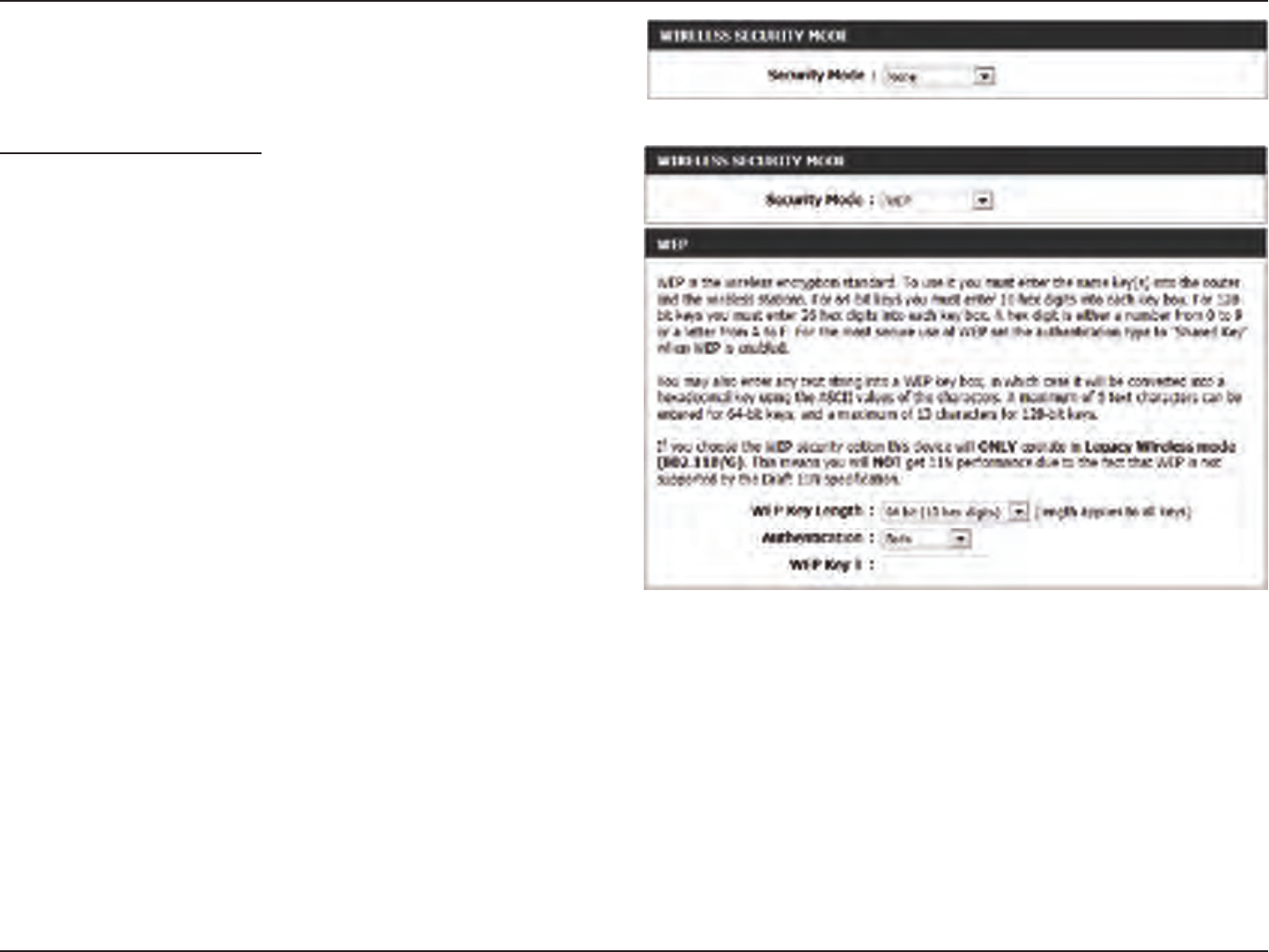
52D-Link DIR-850L User Manual
By default the wireless security of this router will be disabled. In this
next option the user can enabled or disable wireless security for the
frequency band 2.4GHz. There are two types of encryption that can be
used. WEP or WPA/WPA2.
Wireless Security Mode: WEP
Wired Equivalent Privacy (WEP) is the most basic form of encryption
that can be used for wireless networks. Even though it is known as a
‘weak’ security method, it is better than no security at all. Older wireless
adapter sometimes only supports WEP encryption and thus we still nd
this encryption method used today.
The following parameters will be available for conguration:
WEP Key Length: Here the user can specify to either use a
64Bit or a 128Bit encrypted key.
Authentication: Authentication is a process by which the
router veries the identity of a network
device that is attempting to join the wire-
less network. There are two types authen-
tication for this device when using WEP.
Open System allows all wireless devices
to communicate with the router before
they are required to provide the encryp-
tion key needed to gain access to the
network. Shared Key requires any wire-
less device attempting to communicate
with the router to provide the encryption
key needed to access the network before
they are allowed to communicate with the
router.
WEP Key 1: Enter the WEP key used here. For 64-bit keys you must enter 10 hex digits into each key box. For 128-bit keys you
must enter 26 hex digits into each key box. A hex digit is either a number from 0 to 9 or a letter from A to F. You
may also enter any text string into a WEP key box, in which case it will be converted into a hexadecimal key using
the ASCII values of the characters. A maximum of 5 text characters can be entered for 64-bit keys, and a maximum
of 13 characters for 128-bit keys.
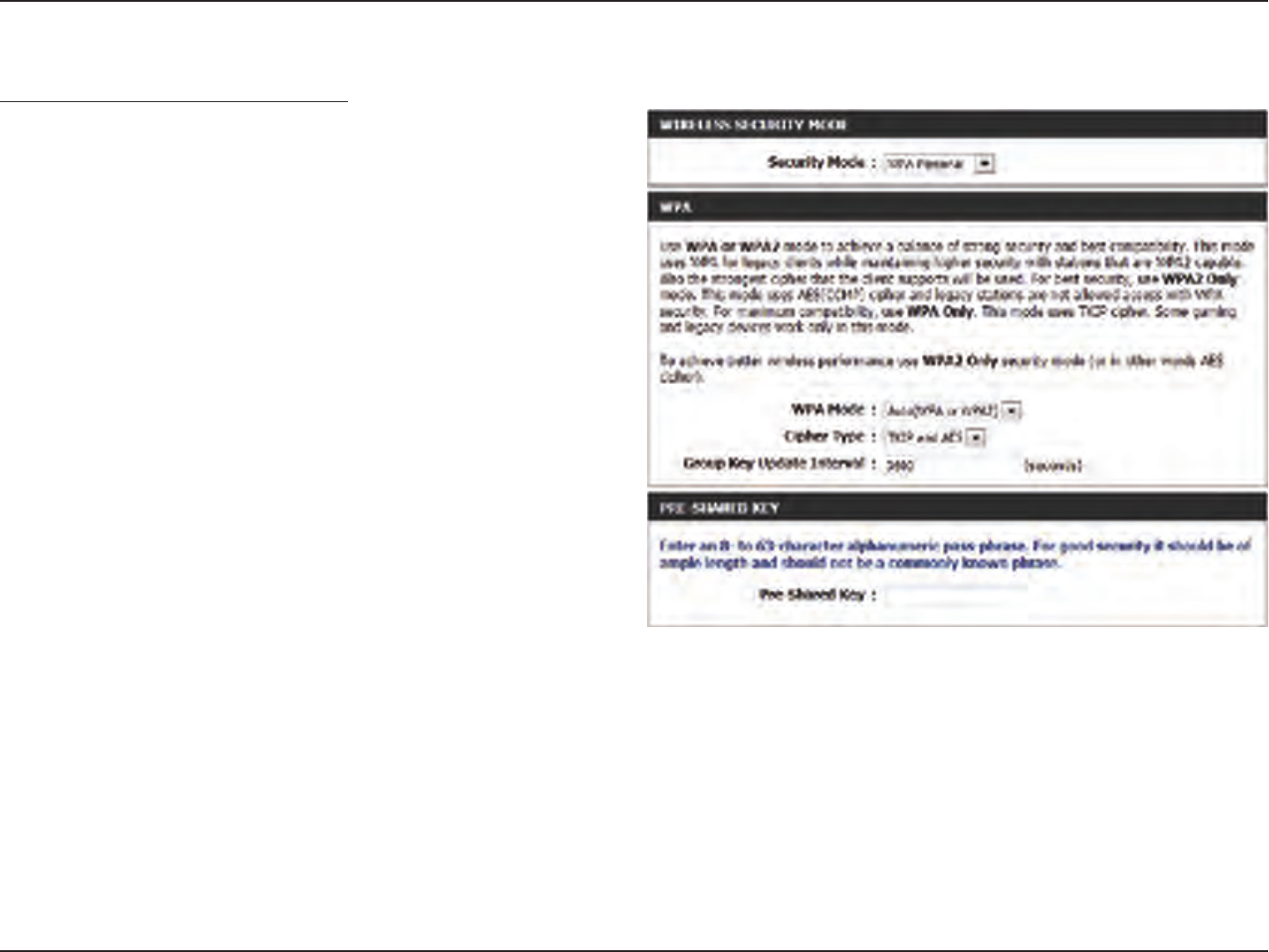
53D-Link DIR-850L User Manual
Wireless Security Mode: WPA-Personal
Wi-Fi Protected Access (WPA) is the most advanced and up to date wire-
less encryption method used today. This is the recommended wireless
security option. WPA supports two authentication frameworks. Personal
(PSK) and Enterprise (EAP).
The following parameters will be available for conguration:
WPA Mode: WPA is the older standard; select this op-
tion if the clients that will be used with the
router only support the older standard.
WPA2 is the newer implementation of the
stronger IEEE 802.11i security standard.
With the “WPA2” option, the router tries
WPA2 rst, but falls back to WPA if the
client only supports WPA. With the “WPA2
Only” option, the router associates only
with clients that also support WPA2 secu-
rity.
Cipher Type: Select the appropriate cipher type to use
here. Options to choose from are Temporal
Key Integrity Protocol (TKIP), Advanced
Encryption Standard (AES), and Both (TKIP
and AES).
Group Key Update Interval: Enter the amount of time before the group
key used for broadcast and multicast data
is changed.
Pre-Shared Key: Enter the shared secret used here. This secret phrase needs to be the same on all of the wireless clients for them to
be able to connect to the wireless network successfully.
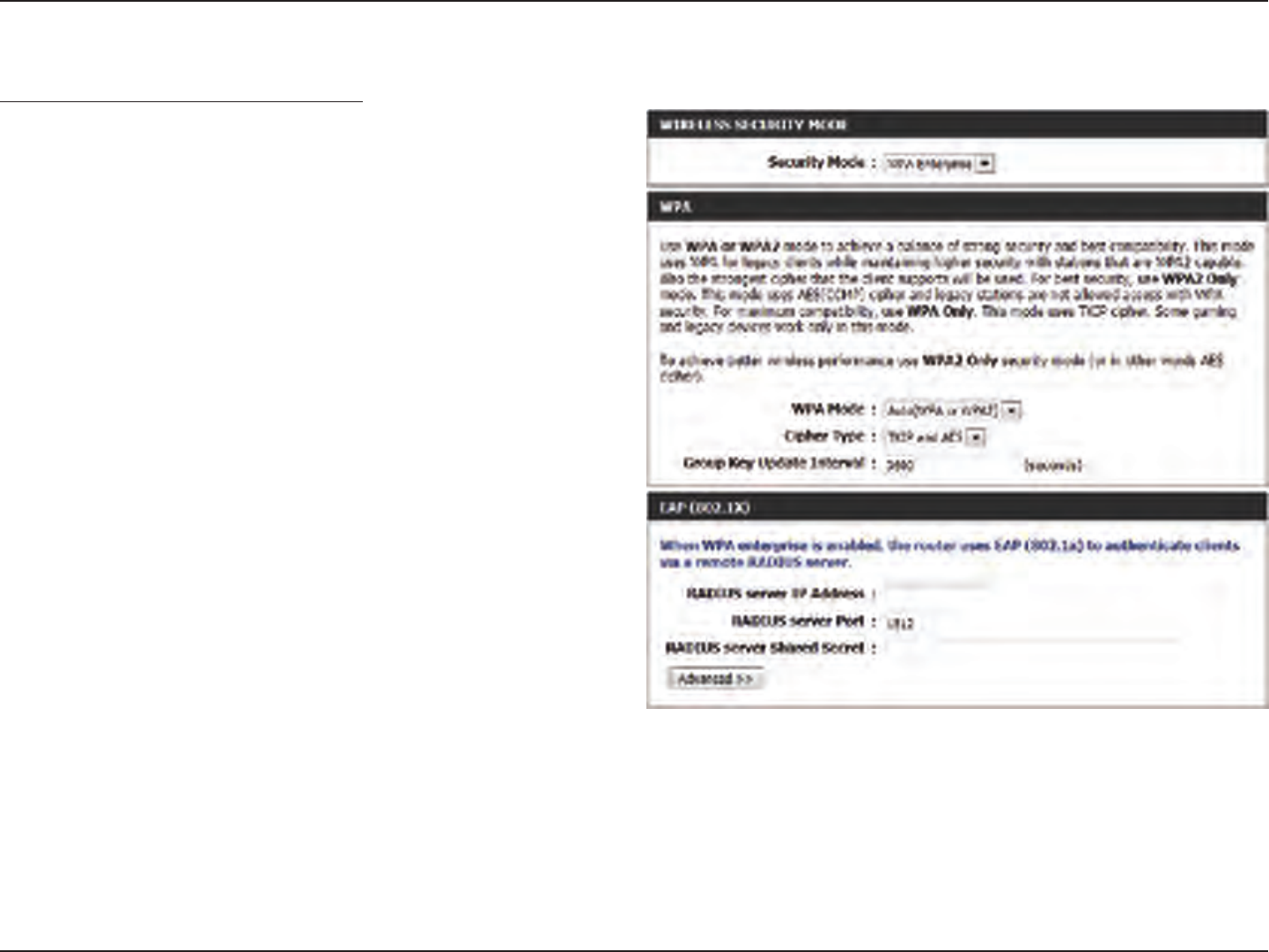
54D-Link DIR-850L User Manual
Wireless Security Mode: WPA-Enterprise
Wi-Fi Protected Access (WPA) is the most advanced and up to date wire-
less encryption method used today. This is the recommended wireless
security option. WPA supports two authentication frameworks. Personal
(PSK) and Enterprise (EAP).
The following parameters will be available for conguration:
WPA Mode: WPA is the older standard; select this op-
tion if the clients that will be used with the
router only support the older standard.
WPA2 is the newer implementation of the
stronger IEEE 802.11i security standard.
With the “WPA2” option, the router tries
WPA2 rst, but falls back to WPA if the
client only supports WPA. With the “WPA2
Only” option, the router associates only
with clients that also support WPA2 secu-
rity.
Cipher Type: Select the appropriate cipher type to use
here. Options to choose from are Temporal
Key Integrity Protocol (TKIP), Advanced
Encryption Standard (AES), and Both (TKIP
and AES).
Group Key Update Interval: Enter the amount of time before the group
key used for broadcast and multicast data
is changed.
RADIUS Server IP Address: When the user chooses to use the EAP
authentication framework, the RADIUS
server’s IP address can be entered here.
RADIUS Server Port: When the user chooses to use the EAP authentication framework, the RADIUS server’s port number can be entered
here.
RADIUS Server Shared
Secret:
Enter the shared secret used here. This secret phrase needs to be the same on all of the wireless clients for them to
be able to connect to the wireless network successfully.
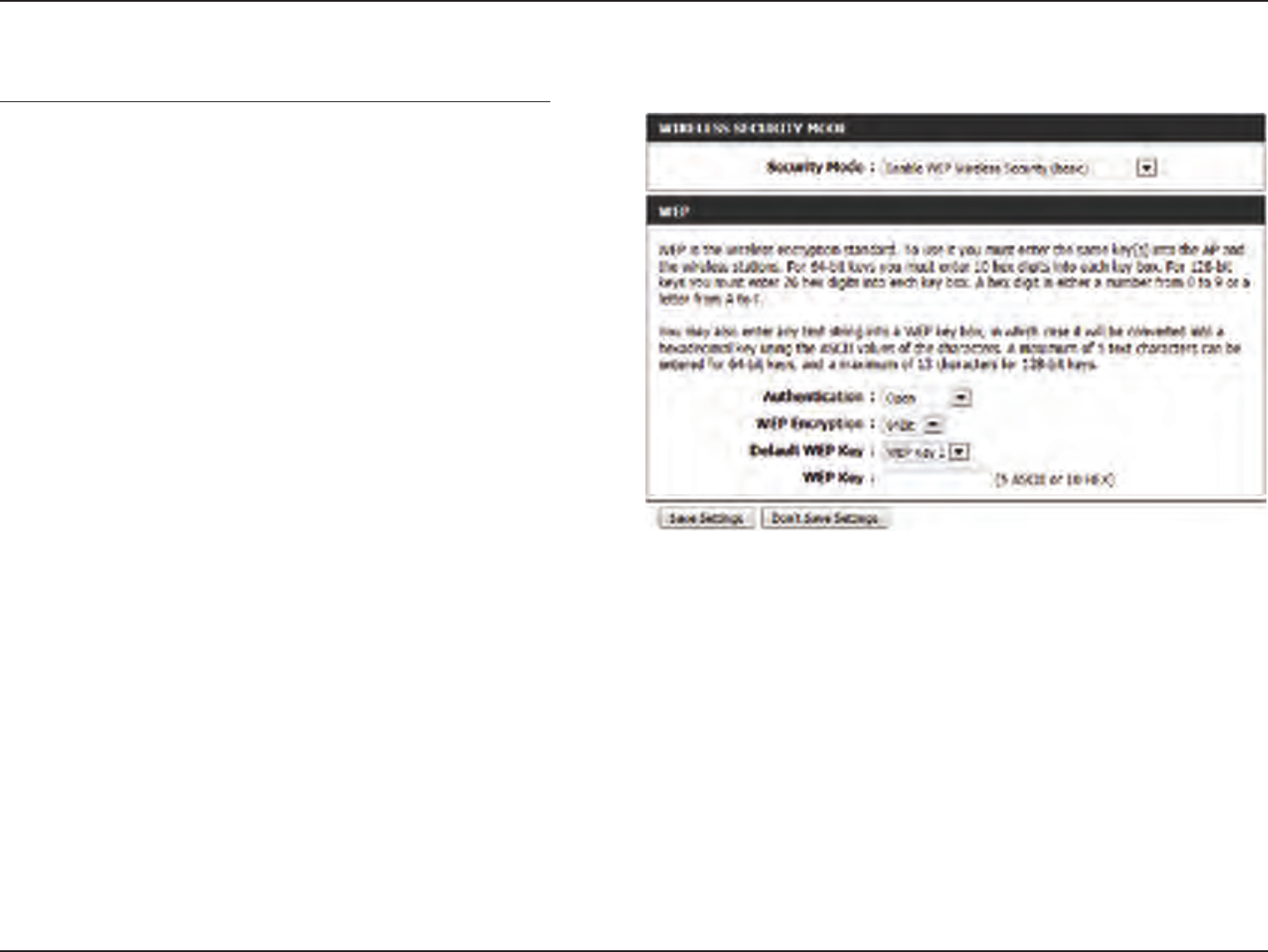
55D-Link DIR-850L User Manual
Wireless Security Mode: Enable WEP Wireless Security (basic)
Wired Equivalent Privacy (WEP) is the most basic form of encryption
that can be used for wireless networks. Even though it is known as a
‘weak’ security method, it is better than no security at all. Older wireless
adapter sometimes only supports WEP encryption and thus we still nd
this encryption method used today.
The following parameters will be available for conguration:
Authentication: Authentication is a process by which the
router veries the identity of a network
device that is attempting to join the wire-
less network. There are two types authen-
tication for this device when using WEP.
Open System allows all wireless devices
to communicate with the router before
they are required to provide the encryp-
tion key needed to gain access to the
network. Shared Key requires any wire-
less device attempting to communicate
with the router to provide the encryption
key needed to access the network before
they are allowed to communicate with the
router.
WEP Encryption: Here the user can specify to either use a
64Bit or a 128Bit encrypted key.
Default WEP Key: Select the default WEP key number that will be used for the encryption.
WEP Key: Enter the WEP key used here. For 64-bit keys you must enter 10 hex digits into each key box. For 128-bit keys you
must enter 26 hex digits into each key box. A hex digit is either a number from 0 to 9 or a letter from A to F. You
may also enter any text string into a WEP key box, in which case it will be converted into a hexadecimal key using
the ASCII values of the characters. A maximum of 5 text characters can be entered for 64-bit keys, and a maximum
of 13 characters for 128-bit keys.
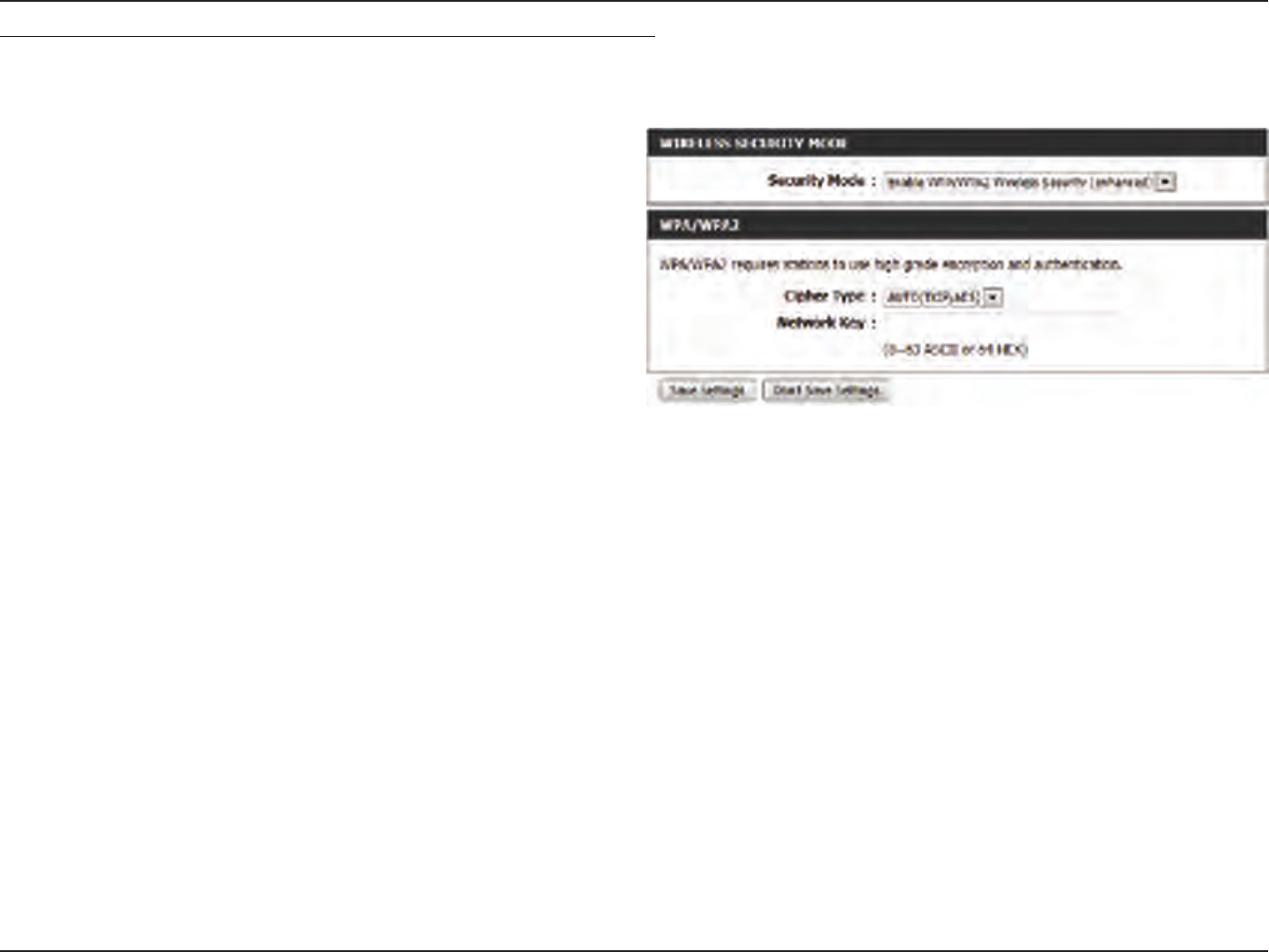
56D-Link DIR-850L User Manual
Wireless Security Mode: Enable WPA/WPA2 Wireless Security (enhanced)
Wi-Fi Protected Access (WPA) is a more advanced and up to date wireless encryption method used today. This is the recommended wireless
security option.
The following parameters will be available for conguration:
Cipher Type: Select the appropriate cipher type to use here.
Options to choose from are Temporal Key
Integrity Protocol (TKIP), Advanced Encryp-
tion Standard (AES), and Both (Auto TKIP and
AES).
Network Key: Enter the shared secret used here. This secret
phrase needs to be the same on all of the
wireless clients for them to be able to connect
to the wireless network successfully.
Click on the Save Settings button to accept the changes made.
Click on the Don’t Save Settings button to discard the changes made.

57D-Link DIR-850L User Manual
Section 4 - Security
Wireless Security
This section will show you the dierent levels of security you can use to protect your data from intruders. The DIR-850L oers the
following types of security:
• WPA2 (Wi-Fi Protected Access 2) • WPA2-PSK (Pre-Shared Key)
• WPA (Wi-Fi Protected Access) • WPA-PSK (Pre-Shared Key)
What is WPA?
WPA (Wi-Fi Protected Access), is a Wi-Fi standard that was designed to improve the security features of WEP (Wired Equivalent Privacy).
The 2 major improvements over WEP:
• Improved data encryption through the Temporal Key Integrity Protocol (TKIP). TKIP scrambles the keys using a hashing
algorithm and, by adding an integrity-checking feature, ensures that the keys haven’t been tampered with. WPA2 is
based on 802.11i and uses Advanced Encryption Standard (AES) instead of TKIP.
• User authentication, which is generally missing in WEP, through the extensible authentication protocol (EAP). WEP
regulates access to a wireless network based on a computer’s hardware-specic MAC address, which is relatively simple
to be snied out and stolen. EAP is built on a more secure public-key encryption system to ensure that only authorized
network users can access the network.
WPA-PSK/WPA2-PSK uses a passphrase or key to authenticate your wireless connection. The key is an alpha-numeric password between
8 and 63 characters long. The password can include symbols (!?*&_) and spaces. This key must be the exact same key entered on your
wireless router or access point.
WPA/WPA2 incorporates user authentication through the Extensible Authentication Protocol (EAP). EAP is built on a more secure public
key encryption system to ensure that only authorized network users can access the network.
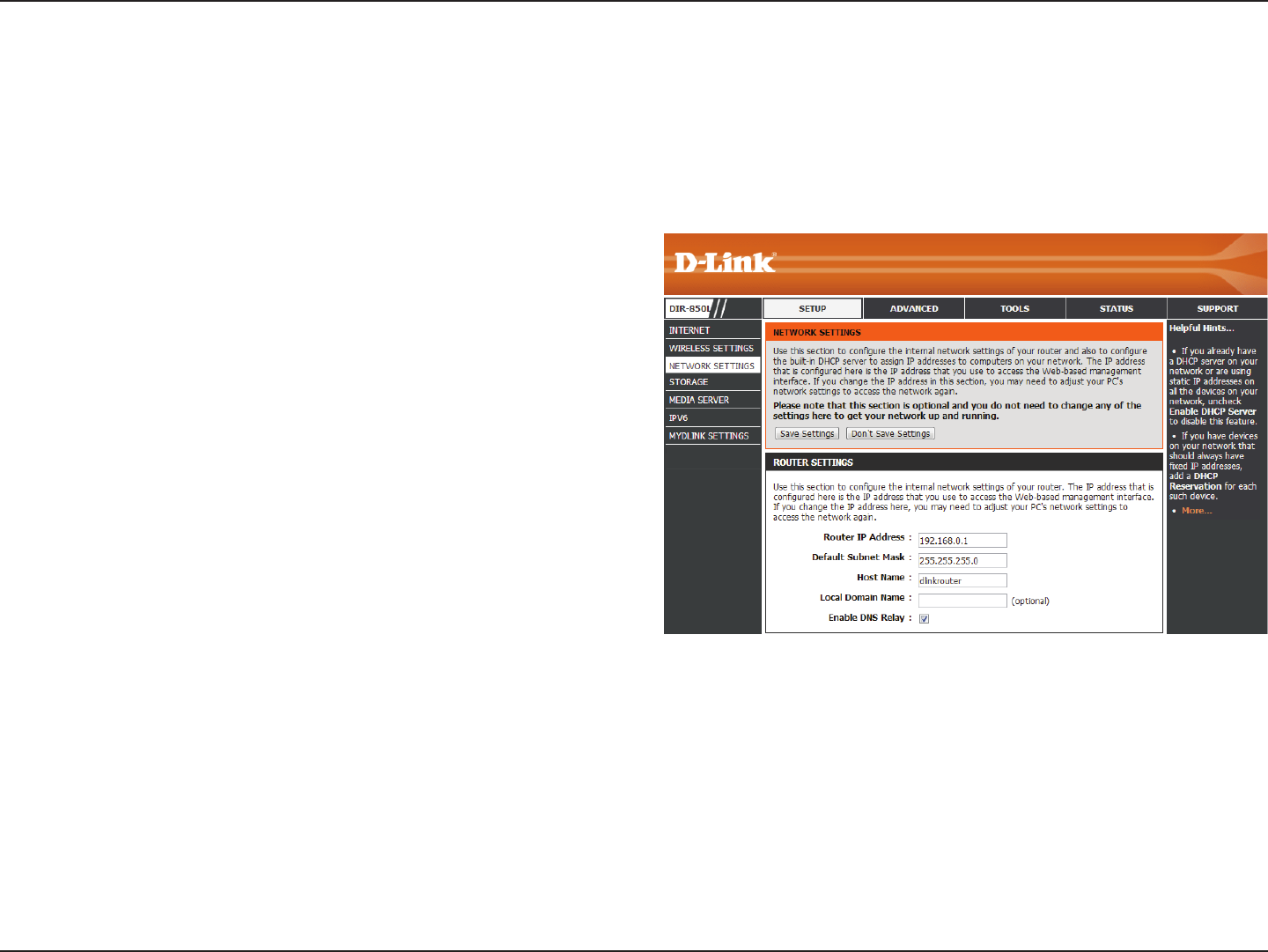
58D-Link DIR-850L User Manual
Section 3 - Conguration
This section will allow you to change the local network settings of the router and to congure the DHCP settings.
Network Settings
Enter the IP address of the router. The default IP address
is 192.168.0.1.
If you change the IP address, once you click Save Settings,
you will need to enter the new IP address in your browser
to get back into the conguration utility.
Enter the Subnet Mask. The default subnet mask is
255.255.255.0.
Enter a name for the router.
Enter the Domain name (Optional).
Uncheck the box to transfer the DNS server information
from your ISP to your computers. If checked, your
computers will use the router for a DNS server.
Router IP Address:
Subnet Mask:
Device Name:
Local Domain:
Enable DNS Relay:
Router Settings
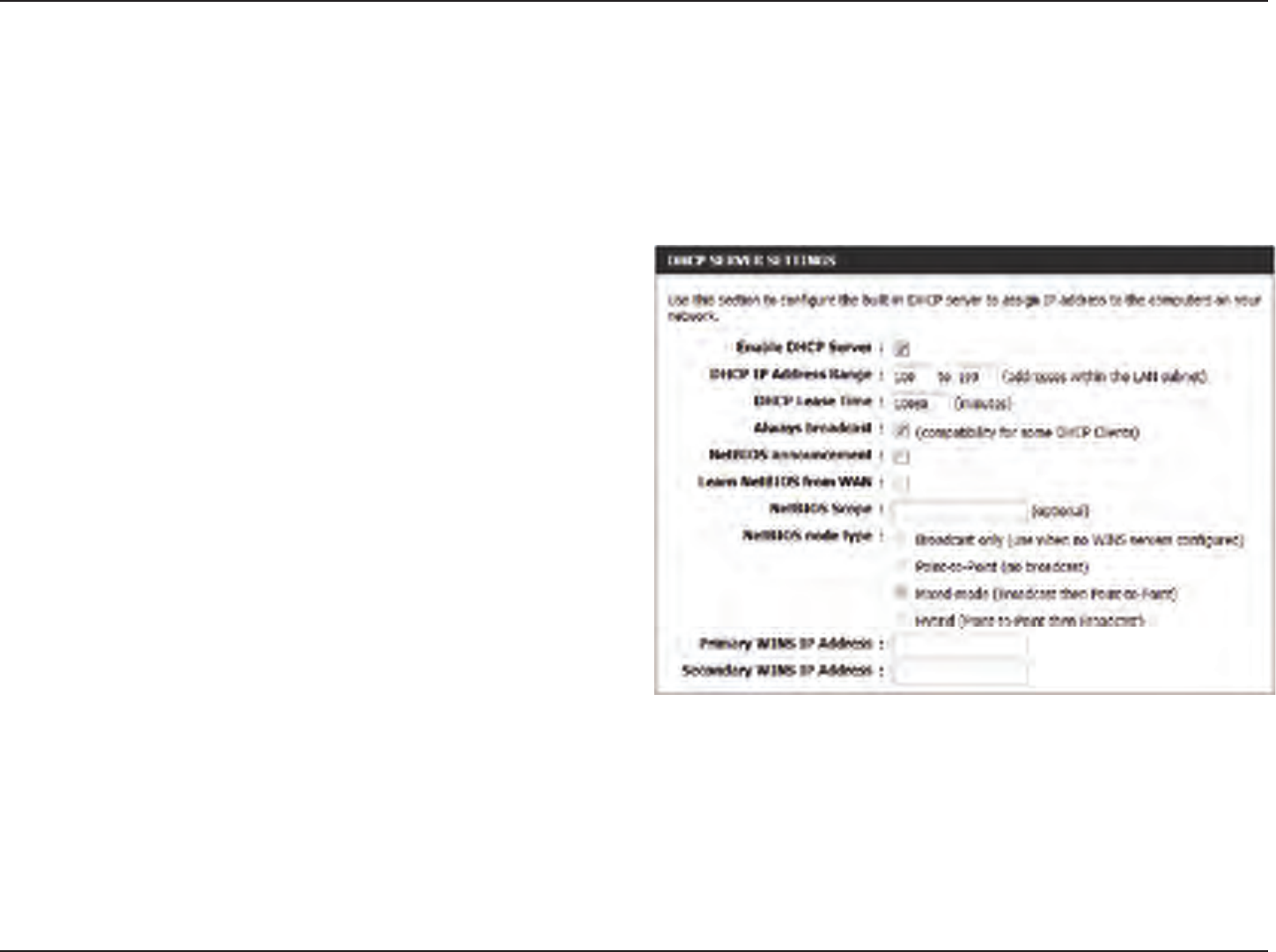
59D-Link DIR-850L User Manual
Section 3 - Conguration
DHCP Server Settings
DHCP stands for Dynamic Host Control Protocol. The DIR-850L has a built-in DHCP server. The DHCP Server will automatically
assign an IP address to the computers on the LAN/private network. Be sure to set your computers to be DHCP clients by setting
their TCP/IP settings to “Obtain an IP Address Automatically.” When you turn your computers on, they will automatically load
the proper TCP/IP settings provided by the DIR-850L. The DHCP Server will automatically allocate an unused IP address from
the IP address pool to the requesting computer. You must specify the starting and ending address of the IP address pool.
Check this box to enable the DHCP server on your router.
Uncheck to disable this function.
Enter the starting and ending IP addresses for the DHCP
server’s IP assignment.
Note: If you statically (manually) assign IP addresses to your
computers or devices, make sure the IP addresses are outside
of this range or you may have an IP conict.
The length of time for the IP address lease. Enter the Lease
time in minutes.
If all the computers on the LAN successfully obtain their
IP addresses from the router’s DHCP server as expected,
this option can remain disabled. However, if one of the
computers on the LAN fails to obtain an IP address from the
router’s DHCP server, it may have an old DHCP client that
incorrectly turns o the broadcast ag of DHCP packets.
Enabling this option will cause the router to always broadcast its responses to all clients, thereby working around the problem, at
the cost of increased broadcast trac on the LAN.
Check this box to allow the DHCP Server to oer NetBIOS conguration settings to the LAN hosts. NetBIOS allow LAN hosts to
discover all other computers within the network, e.g. within Network Neighborhood.
If NetBIOS announcement is switched on, it will cause WINS information to be learned from the WAN side, if available. Turn this
setting o to congure manually.
Enable DHCP
Server:
DHCP IP Address
Range:
DHCP Lease Time:
Always
Broadcast:
NetBIOS
Announcement:
Learn NetBIOS
from WAN:

60D-Link DIR-850L User Manual
Section 3 - Conguration
NetBIOS Scope:
NetBIOS Node:
WINS IP
Address:
This is an advanced setting and is normally left blank. This allows the conguration of a NetBIOS ‘domain’ name under which network
hosts operate. This setting has no eect if the ‘Learn NetBIOS information from WAN’ is activated.
This eld indicates how network hosts are to perform NetBIOS name registration and discovery. H-Node, this indicates a Hybrid-State
of operation. First WINS servers are tried, if any, followed by local network broadcast. This is generally the preferred mode if you
have congured WINS servers. M-Node (default), this indicates a Mixed-Mode of operation. First Broadcast operation is performed
to register hosts and discover other hosts, if broadcast operation fails, WINS servers are tried, if any. This mode favours broadcast
operation which may be preferred if WINS servers are reachable by a slow network link and the majority of network services such as
servers and printers are local to the LAN. P-Node, this indicates to use WINS servers ONLY. This setting is useful to force all NetBIOS
operation to the congured WINS servers. You must have congured at least the primary WINS server IP to point to a working WINS
server. B-Node, this indicates to use local network broadcast ONLY. This setting is useful where there are no WINS servers available,
however, it is preferred you try M-Node operation rst. This setting has no eect if the ‘Learn NetBIOS information from WAN’ is
activated.
Enter your WINS Server IP address(es).
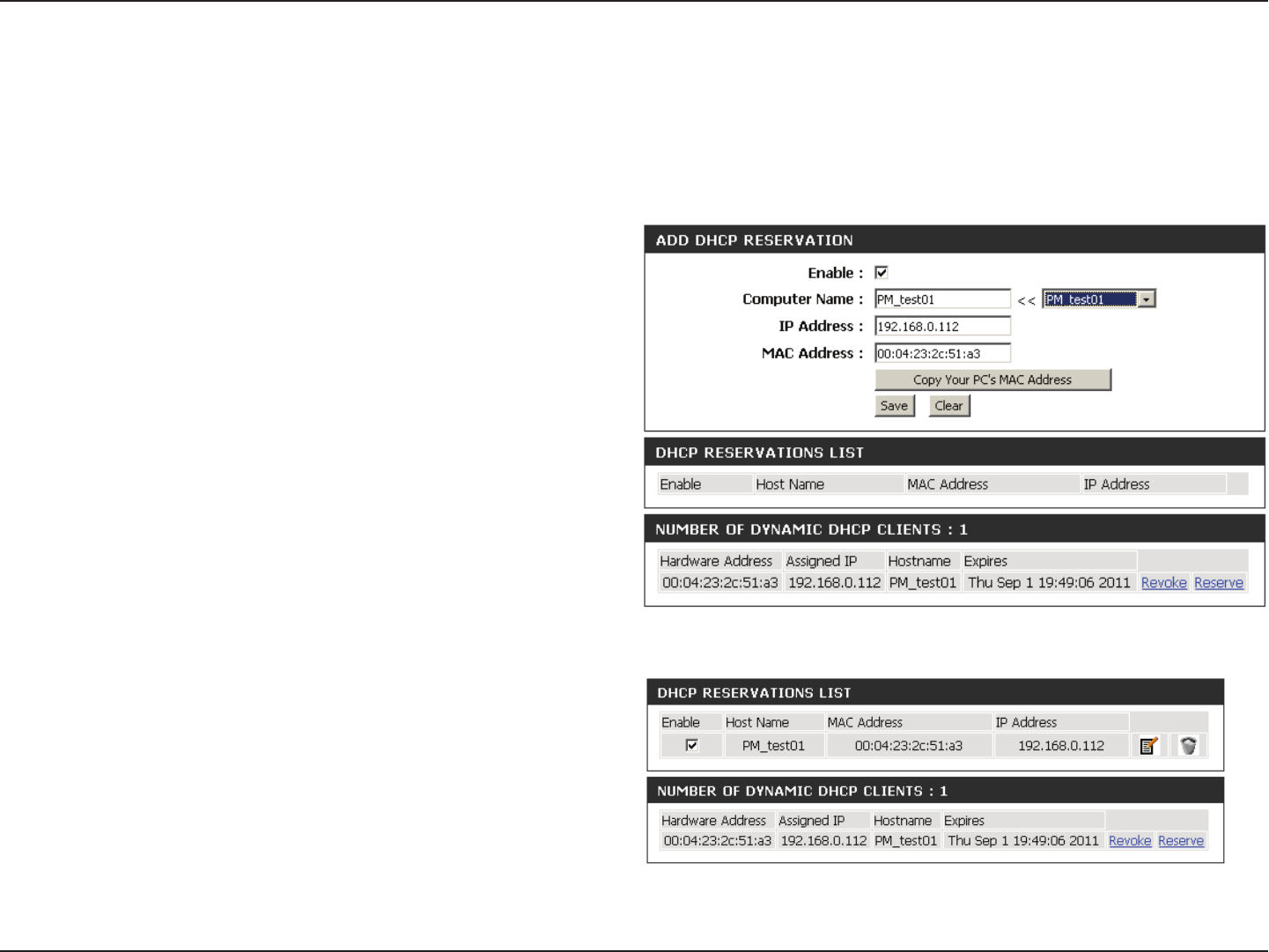
61D-Link DIR-850L User Manual
Section 3 - Conguration
DHCP Reservation
If you want a computer or device to always have the same IP address assigned, you can create a DHCP reservation. The router will assign the IP
address only to that computer or device.
Note: This IP address must be within the DHCP IP Address Range.
Check this box to enable the reservation.
Enter the computer name or select from the drop-down
menu and click <<.
Enter the IP address you want to assign to the computer
or device. This IP Address must be within the DHCP IP
Address Range.
Enter the MAC address of the computer or device.
If you want to assign an IP address to the computer you
are currently on, click this button to populate the elds.
Click Save to save your entry. You must click Save Settings
at the top to activate your reservations.
Displays any reservation entries. Displays the host name
(name of your computer or device), MAC Address, and IP
address.
Check to enable the reservation.
Click the edit icon to make changes to the reservation entry.
Click to remove the reservation from the list.
Enable:
Computer Name:
IP Address:
MAC Address:
Copy Your PC’s
MAC Address:
Save:
DHCP
Reservations List:
Enable:
Edit:
Delete:
DHCP Reservations List
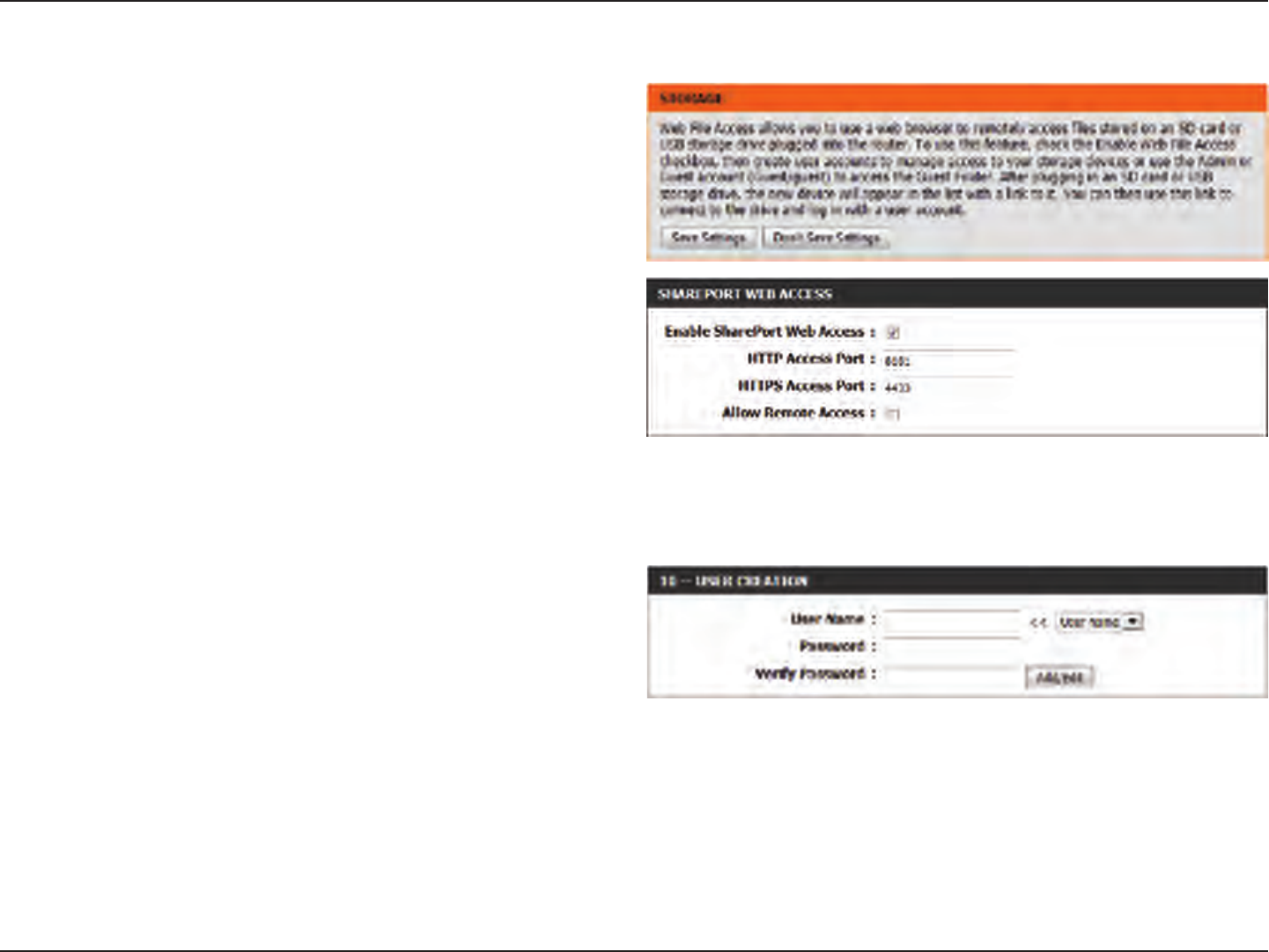
62D-Link DIR-850L User Manual
Storage
This page allows the user to use a web browser to remotely access les
stored on an SD card or USB storage drive plugged into the router.
You can access storage device by http://shareport.local when you
enable SharePort Web Access
The following parameters will be available for conguration:
Enable SharePort Web
Access:
Tick this option to enable the share port
web access feature.
HTTP Access Port: Enter the HTTP Access Port number used
here. By default, this value is 8181.
HTTPS Access Port: Enter the HTTPS Access Port number used
here. By default, this value is 4433.
Allow Remote Access: Tick this option the allow remote access to this router.
In the User Creation section, the user can create and modify usernames and passwords.
The following parameters will be available for conguration:
User Name: In the User Name eld we can enter the
new username that will be created. Alter-
natively, if we want to modify an existing
user account, select a username from the
drop-down menu. It will automatically be
added to the User Name eld for modica-
tion.
Password: In the Password eld, the user can enter the password that will be associated with the user account.
Verify Password: In the Verify Password eld, the user can re-enter the password that will be associated with the user account.
Click the Add/Edit button the add a new user account or modify an existing account.
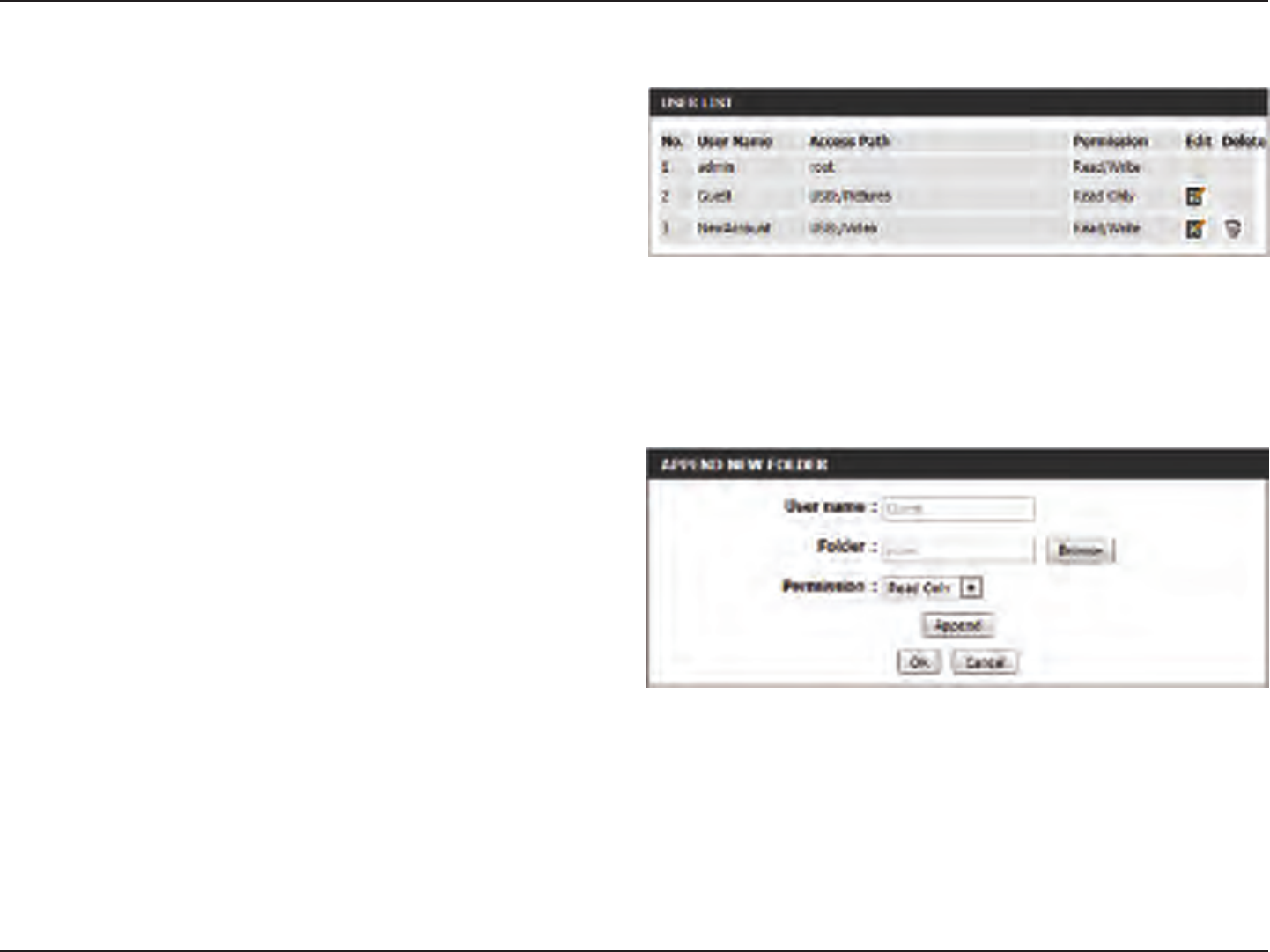
63D-Link DIR-850L User Manual
In the User List section, the user can modify or delete dierent user settings for each account.
The following parameters will be available in the display.
No. Displays the number of the entry in the
user list.
User Name: Displays the user name of the entry in the
list.
Access Path: Displays the access path of the entry in the
list.
Permission: Displays the permission settings of the
entry in the list.
Click the Edit icon to edit the access path and permission, for each user.
Click the Delete icon to delete an account from the list.
After click on the Edit button, this window will appear.
The following parameters will be available for conguration:
User Name: This eld will display the current user
name that will be modied.
Folder: This led will display the access path that
this user will have access to, after logging
in. Click the Browse button to navigate
to a folder, located on the USB storage
device.
Permission: Here the user can select the appropriate
permission setting for this user account.
Permissions available for selection, from
the drop-down menu are Read Only and
Read/Write.
Read Only permission will only allow this account to read data stored on the USB storage device within the con-
strains of the access path specied. Read/Write permission will allow this account to read and write data to and
from the USB storage device within the constrains of the access path specied.
Click the Append button to add a blank account with the access path and permission specied.
Click the OK button to accept the changes made for the existing account.
Click the Cancel button to discard the changes made.
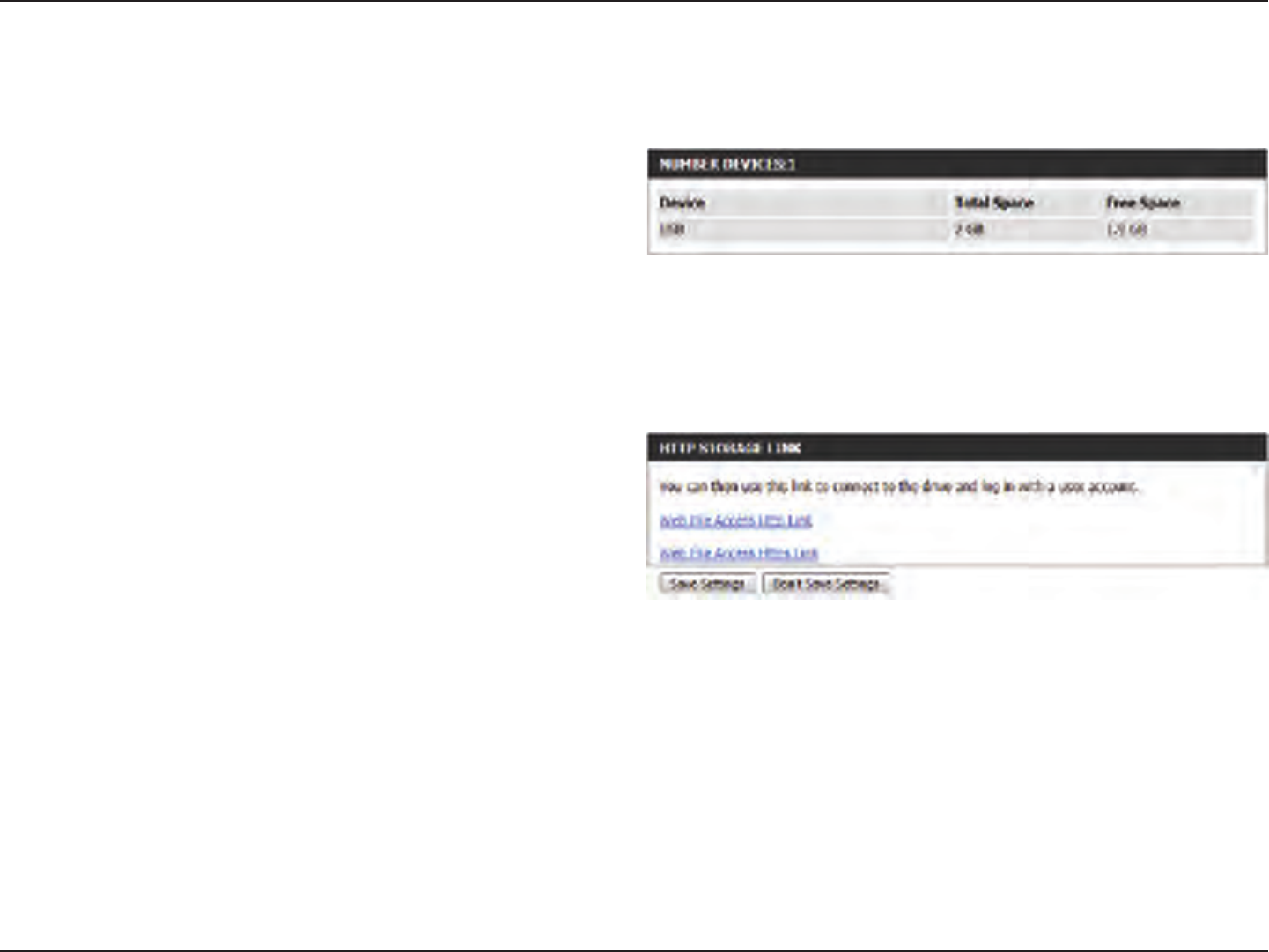
64D-Link DIR-850L User Manual
In the Number Devices section, the user can view information about the external USB storage devices inserted into the USB port of this router.
The following parameters will be available in the display
Number of Devices: This eld will display the number of USB
storage devices that are attached to the
USB port of the router.
Device: This eld will display the USB storage de-
vice’s name.
Total Space: This eld will display the total space that is available on the USB storage device attached.
Free Space: This eld will display the free space that is available on the USB storage device attached.
In the HTTP Storage Link section, the user can use this link to connect to the drive remotely after logging in with a user account.
Notice the path of the link(s) provided will point the external interface
of this router. If no DDNS account is specied on the Dynamic DNS
page, the WAN IP address will be used. If, however, a DDNS account is
specied, then the domain name will be used.
Click on the Save Settings button to accept the changes made.
Click on the Don’t Save Settings button to discard the changes made.
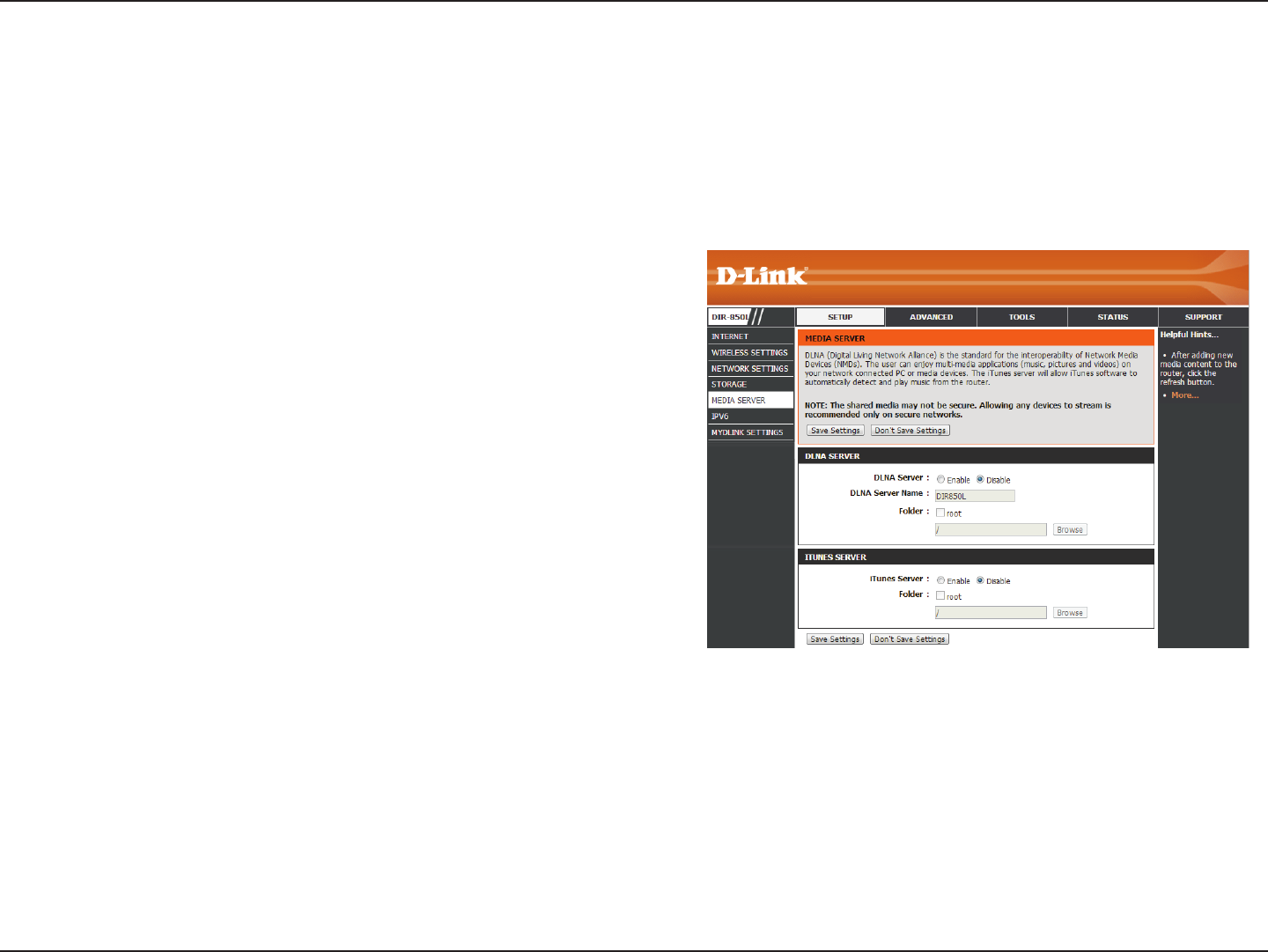
65D-Link DIR-850L User Manual
Section 3 - Conguration
Media Server
This page will allow you to enable a DLNA Media Server. DLNA (Digital Living Network Alliance) is the standard for the interoperability of Network
Media Devices (NMDs). The user can enjoy multimedia applications (music, pictures and videos) on your network connected PC or media devices.
If you agree to share media with devices, any computer or device that connects to your network can play your shared music, pictures and videos.
Note: The shared media may not be secure. Allowing any devices to stream is recommended only on secure networks.
Check to enable DLNA Media Server functions.
Choose a name for your DLNA media server so that it can be
found.
Choose the location of the folder you wish to share or check the
box to use the root folder of the entire drive.
Check to enable iTunes Server functions.
Choose the location of the iTunes Library folder you wish to share
or check the box to use the root folder if it is located on the root
folder of the connected drive.
Use this setting to enable USB 3.0 functionality for the USB port
on the back of the router. USB 3.0 provides high-speed transfer
speeds with compatible devices. This setting is disabled by
default, which means that the USB port will operate at the USB
2.0 specication.
DLNA Server:
DLNA Server
Name:
Folder:
iTunes Server:
Folder:
USB 3.0:
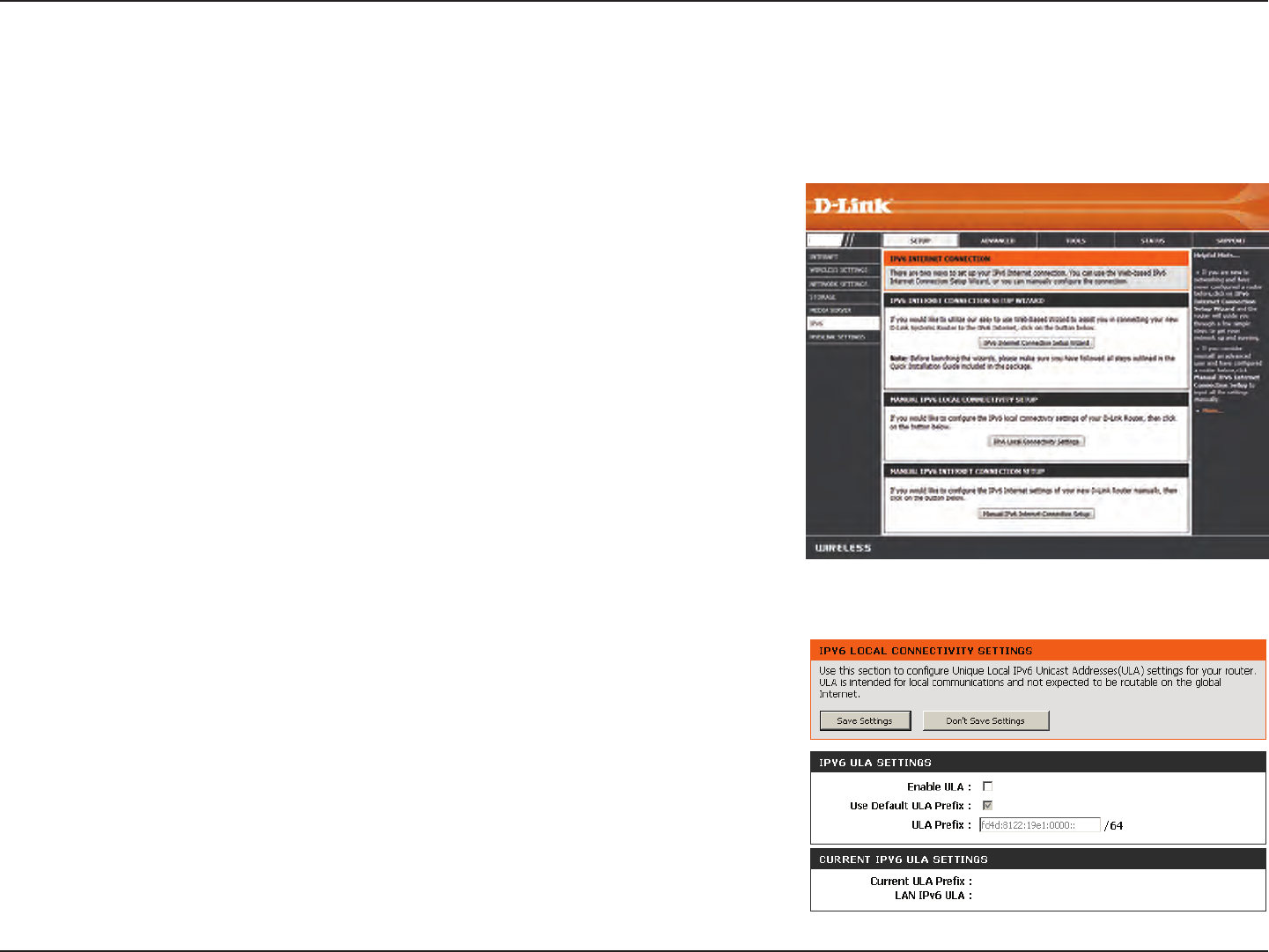
66D-Link DIR-850L User Manual
Section 3 - Conguration
IPv6
On this page, the user can congure the IPv6 Connection type. There are two ways to set up the IPv6 Internet connection. You
can use the Web-based IPv6 Internet Connection Setup Wizard, or you can manually congure the connection.
For the beginner user that has not congured a router before, click on
the IPv6 Internet Connection Setup Wizard button and the router will
guide you through a few simple steps to get your network up and running.
For the advanced user that has congured a router before, click on the
Manual IPv6 Internet Connection Setup button to input all the settings
manually.
To congure the IPv6 local settings, click on the IPv6 Local Connectivity
Setup button.
DIR-850L
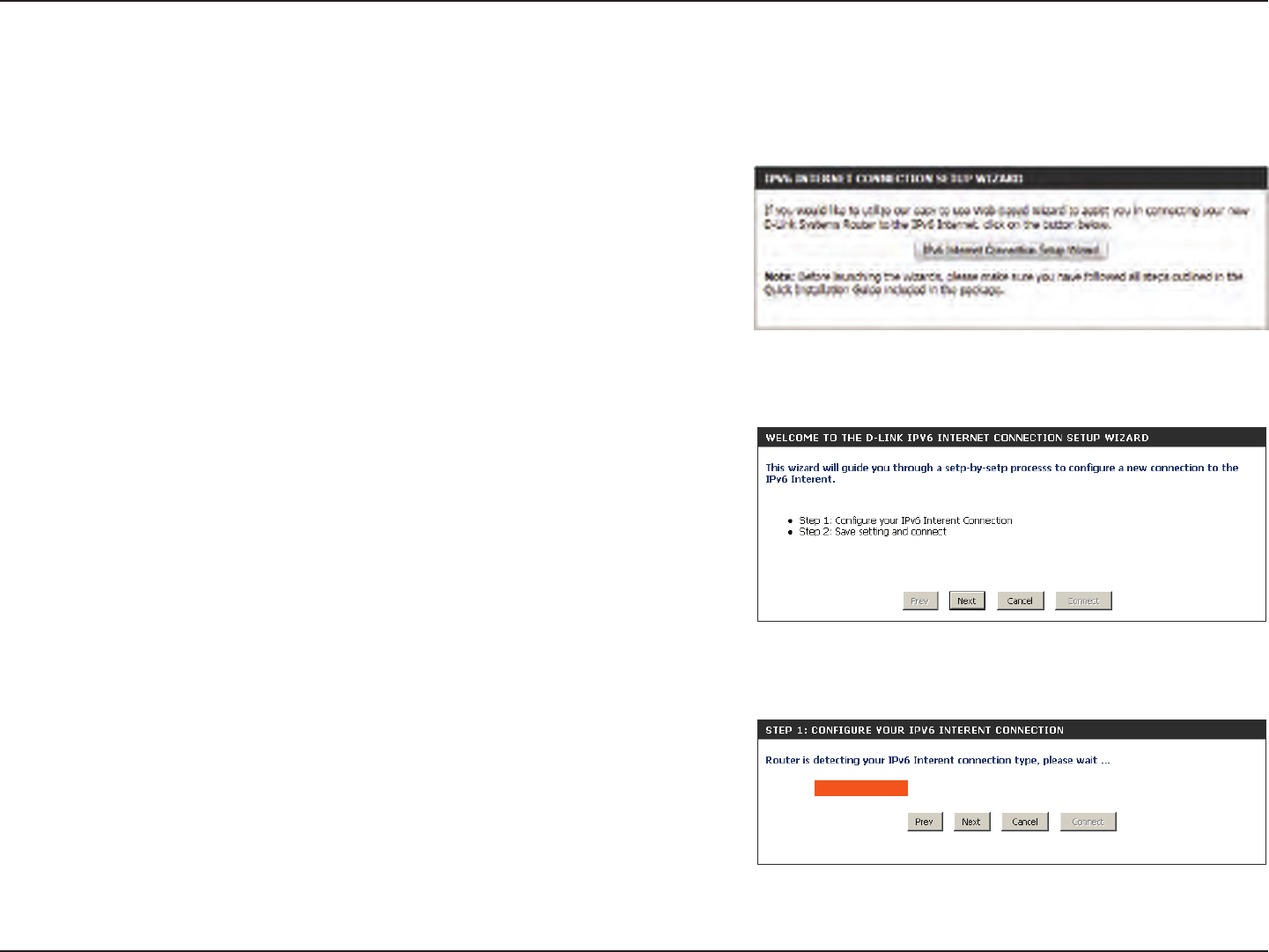
67D-Link DIR-850L User Manual
Section 3 - Conguration
IPv6 Internet Connection Setup Wizard
On this page, the user can congure the IPv6 Connection type using the IPv6 Internet Connection Setup Wizard.
Click the IPv6 Internet Connection Setup Wizard button and the router will guide
you through a few simple steps to get your network up and running.
Click Next to continue to the next page. Click Cancel to discard the changes made
and return to the main page.
The router will try to detect whether its possible to obtain the IPv6 Internet
connection type automatically. If this succeeds then the user will be guided through
the input of the appropriate parameters for the connection type found.
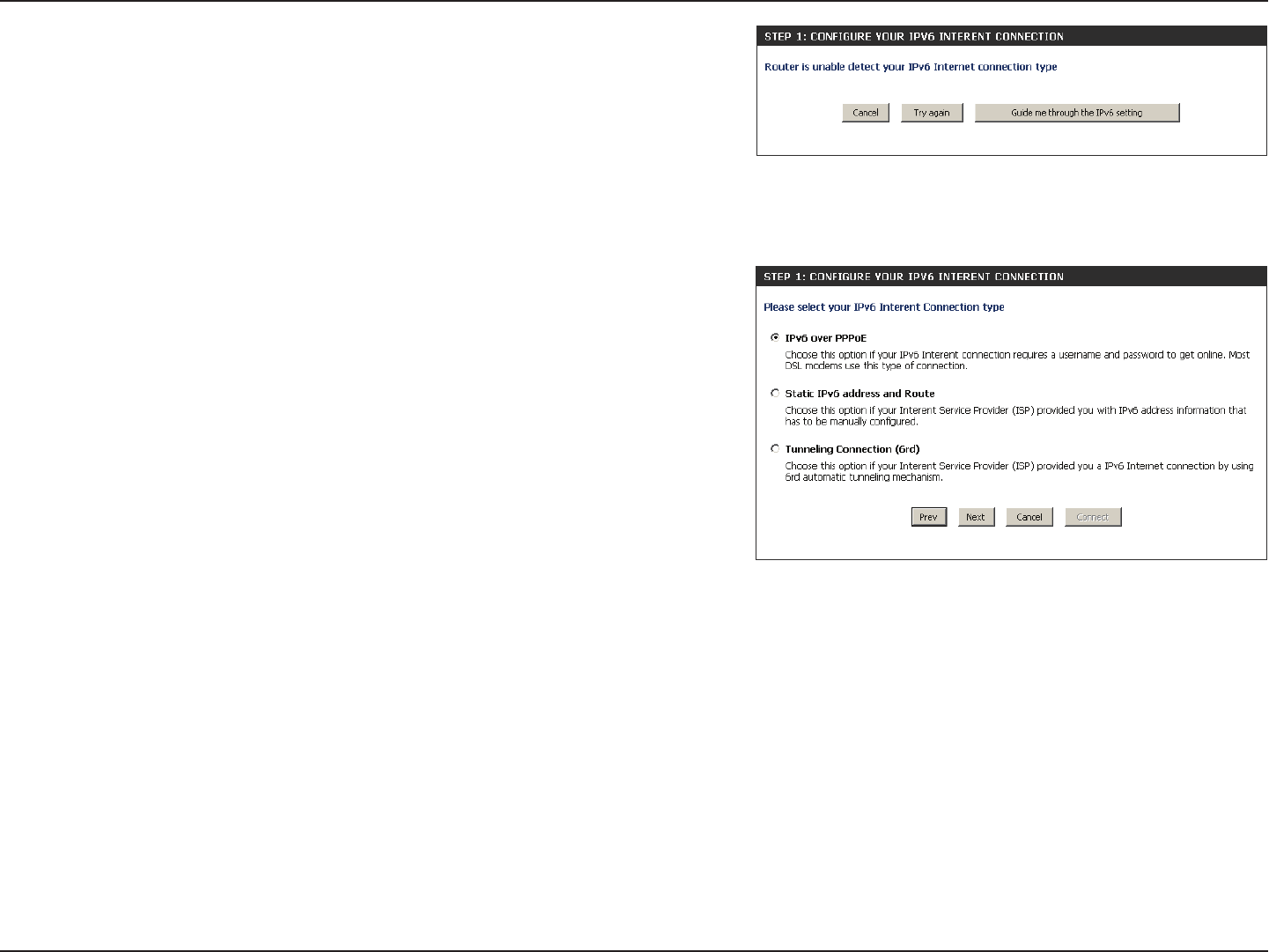
68D-Link DIR-850L User Manual
Section 3 - Conguration
However, if the automatic detection fails, the user will be prompt to either Try
again or to click on the Guide me through the IPv6 settings button to initiate the
manual continual of the wizard.
There are several connection types to choose from. If you are unsure of your
connection method, please contact your IPv6 Internet Service Provider.
Note: If using the PPPoE option, you will need to ensure that any PPPoE client
software on your computers has been removed or disabled. The 3 options available
on this page are IPv6 over PPPoE, Static IPv6 address and Route, and Tunneling
Connection.
Choose the required IPv6 Internet Connection type and click on the Next button
to continue. Click on the Prev button to return to the previous page. Click on the
Cancel button to discard all the changes made and return to the main page.
Click on the Next button to continue. Click on the Prev button to return to the previous page.
Click on the Cancel button to discard all the changes made and return to the main page.
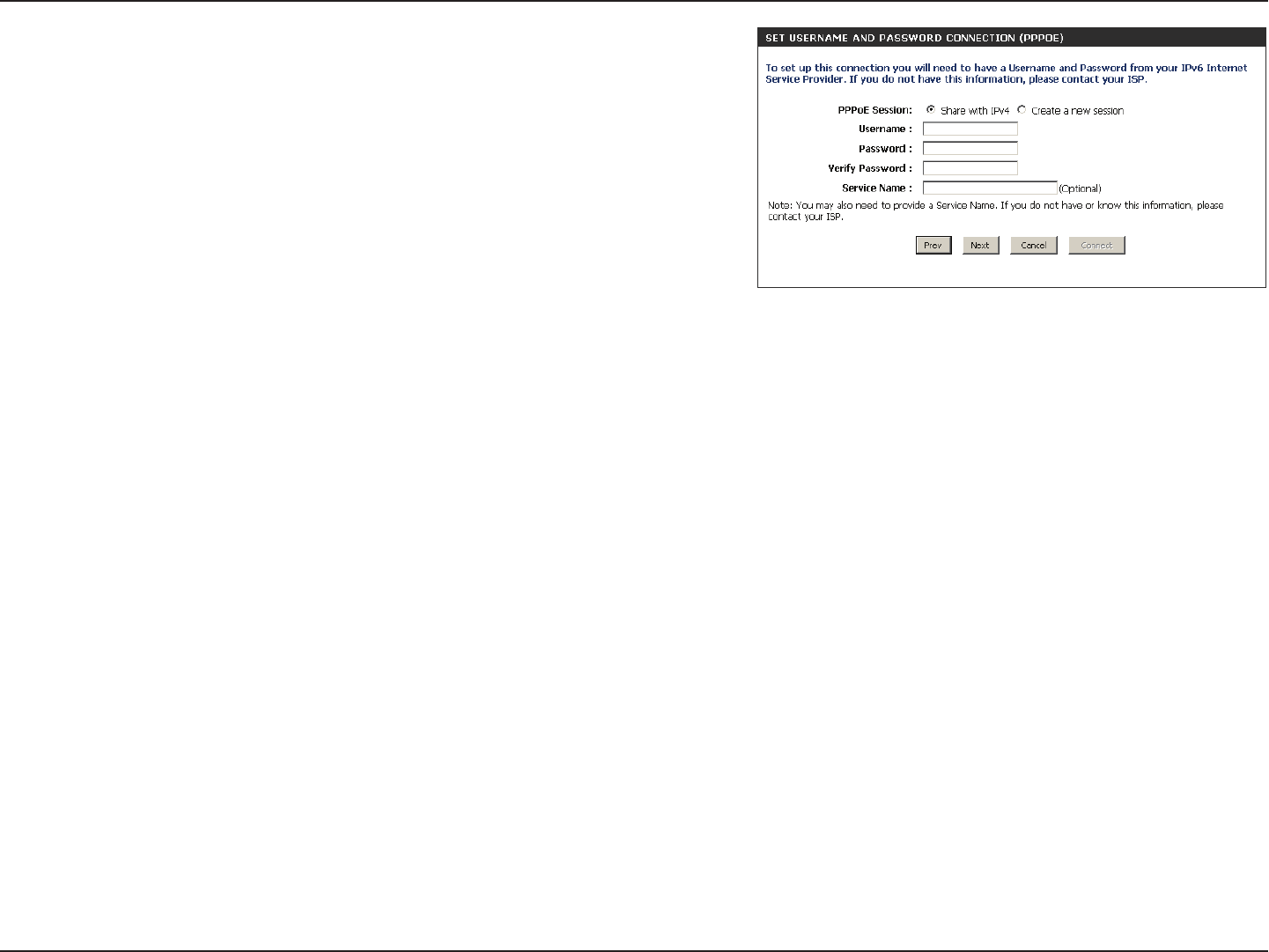
69D-Link DIR-850L User Manual
Section 3 - Conguration
IPv6 over PPPoE
After selecting the IPv6 over PPPoE option, the user will be able to congure the
IPv6 Internet connection that requires a username and password to get online.
Most DSL modems use this type of connection.
The following parameters will be available for conguration:
PPPoE Session: Select the PPPoE Session value used here. This
option will state that this connection shares it’s
information with the already congured IPv6
PPPoE connection, or the user can create a new
PPPoE connection here.
User Name: Enter the PPPoE username used here. If you do not
know your user name, please contact your ISP.
Password: Enter the PPPoE password used here. If you do not
know your password, please contact your ISP.
Verify Password: Re-enter the PPPoE password used here.
Service Name: Enter the service name for this connection here.
This option is optional.
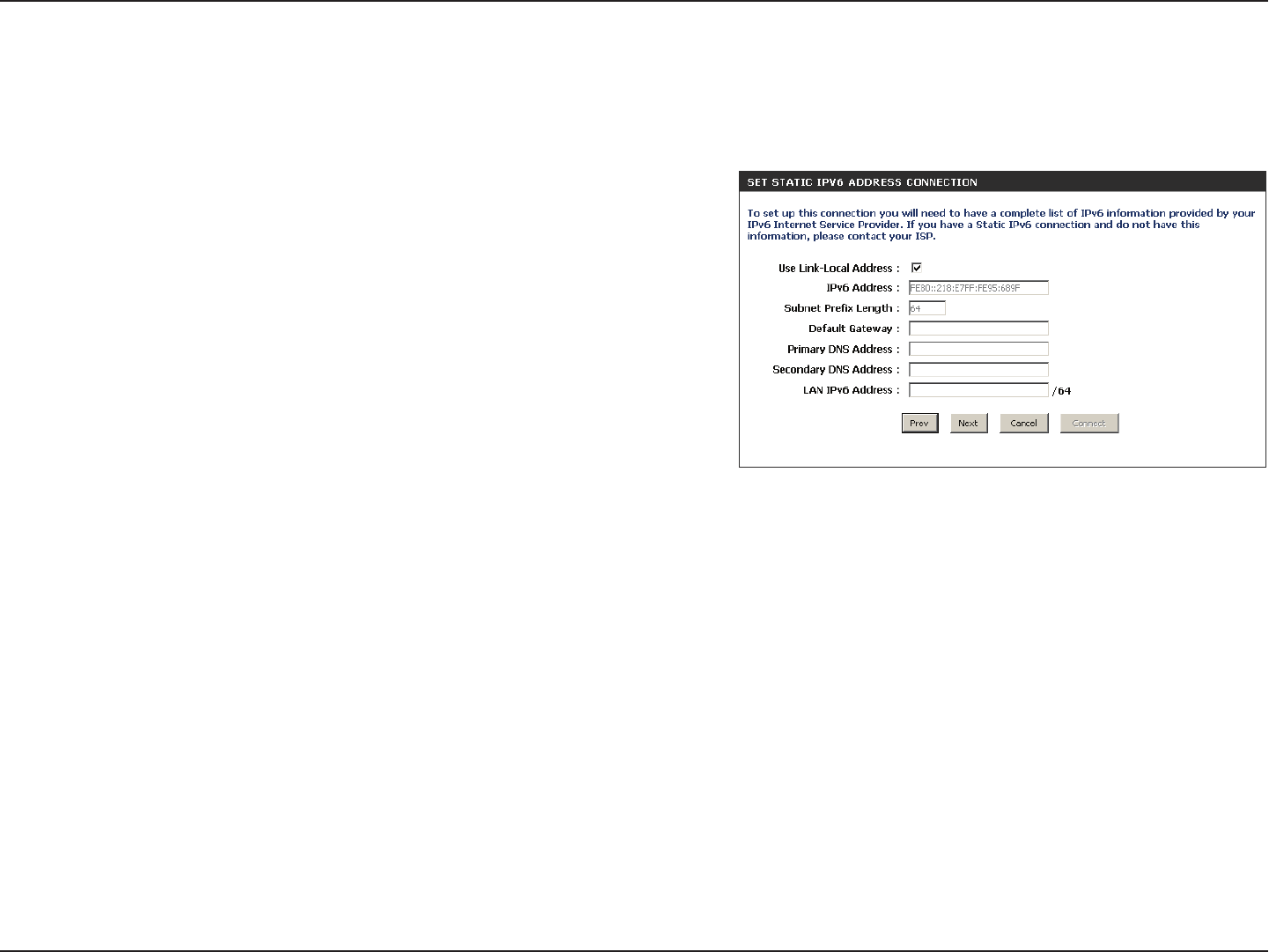
70D-Link DIR-850L User Manual
Section 3 - Conguration
Static IPv6 Address Connection
This mode is used when your ISP provides you with a set IPv6 addresses that does not change. The IPv6 information is manually entered in your
IPv6 conguration settings. You must enter the IPv6 address, Subnet Prex Length, Default Gateway, Primary DNS Server, and Secondary DNS
Server. Your ISP provides you with all this information.
Use Link-Local
Address:
IPv6 Address:
Subnet Prex
Length:
Default Gateway:
Primary IPv6 DNS
Address:
Secondary IPv6
DNS Address:
LAN IPv6 Address:
The Link-local address is used by nodes and routers when
communicating with neighboring nodes on the same link.
This mode enables IPv6-capable devices to communicate
with each other on the LAN side.
Enter the WAN IPv6 address for the router here.
Enter the WAN subnet prex length value used here.
Enter the WAN default gateway IPv6 address used here.
Enter the WAN primary DNS Server address used here.
Enter the WAN secondary DNS Server address used here.
These are the settings of the LAN (Local Area Network)
IPv6 interface for the router. The router’s LAN IPv6 Address
conguration is based on the IPv6 Address and Subnet
assigned by your ISP. (A subnet with prex /64 is supported
in LAN.)
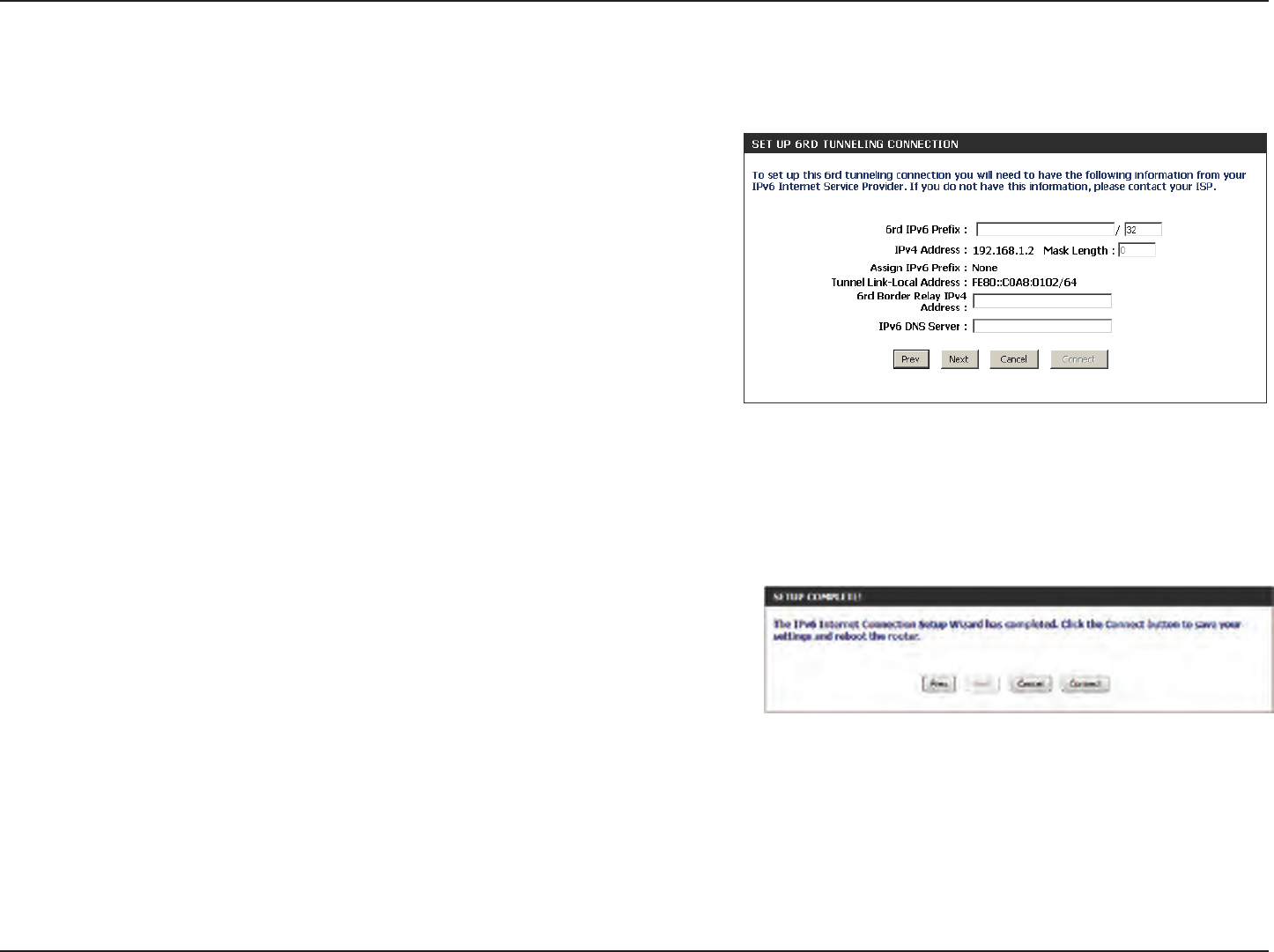
71D-Link DIR-850L User Manual
Section 3 - Conguration
The following parameters will be available for conguration:
6rd IPv6 Prex: Enter the 6rd IPv6 address and prex value used
here.
IPv4 Address: Enter the IPv4 address used here.
Mask Length: Enter the IPv4 mask length used here.
Assigned IPv6 Prex: Displays the IPv6 assigned prex value here.
6rd Border Relay IPv4
Address:
Enter the 6rd border relay IPv4 address used here.
IPv6 DNS Server: Enter the primary DNS Server address used here.
The IPv6 Internet Connection Setup Wizard is complete.
Click on the Connect button to continue. Click on the Prev button to return to
the previous page. Click on the Cancel button to discard all the changes made
and return to the main page.
Tunneling Connection (6rd)
After selecting the Tunneling Connection (6rd) option, the user can congure the IPv6 6rd connection settings.
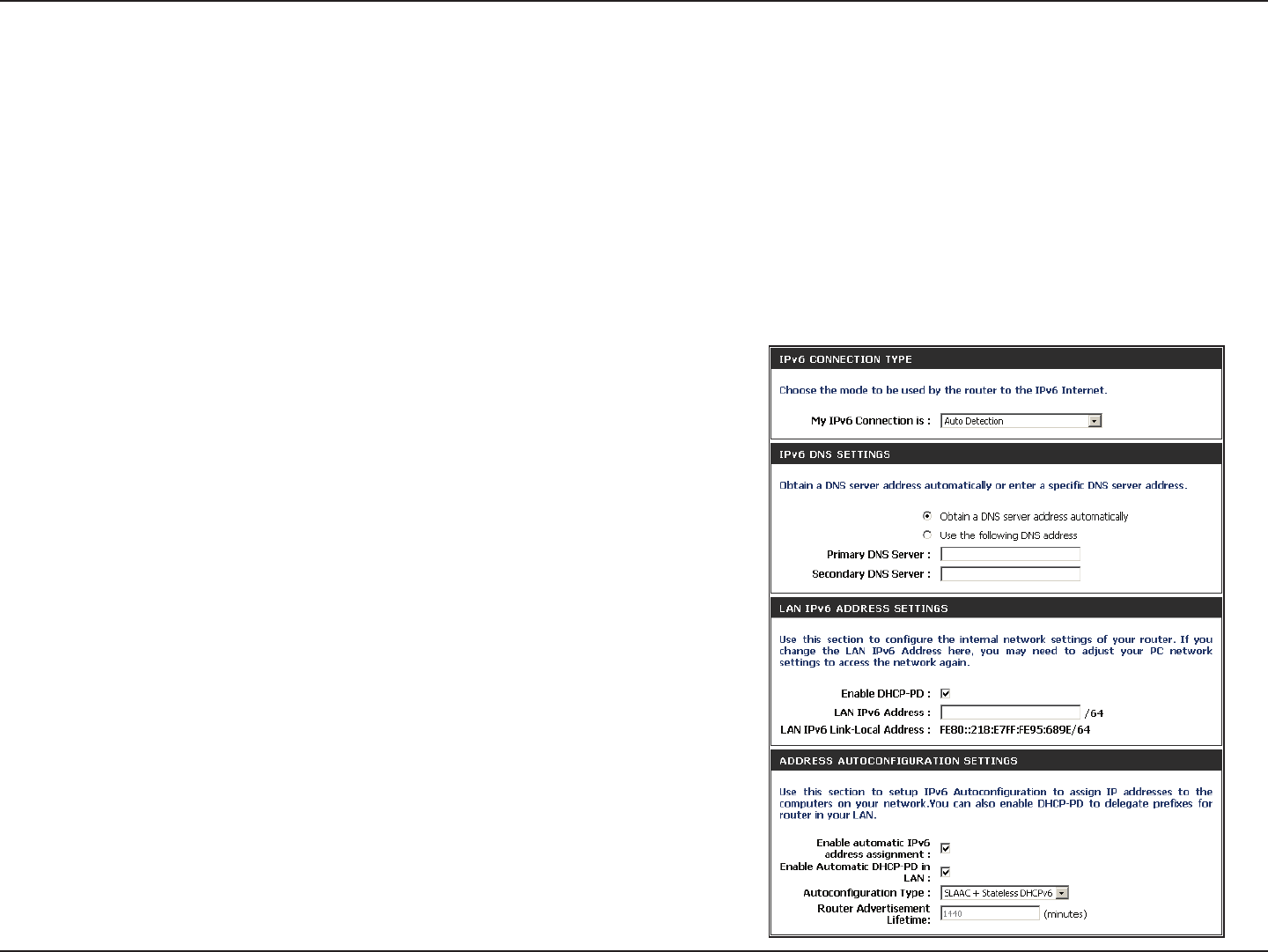
72D-Link DIR-850L User Manual
Section 3 - Conguration
IPv6 Manual Setup
There are several connection types to choose from: Auto Detection, Static IPv6, Autoconguration (SLAAC/DHCPv6), PPPoE,
IPv6 in IPv4 Tunnel, 6to4, 6rd, and Link-local. If you are unsure of your connection method, please contact your IPv6 Internet
Service Provider.
Note: If using the PPPoE option, you will need to ensure that any PPPoE client software on your computers has been removed
or disabled.
Auto Detection
Select Auto Detection to have the router detect and automatically
congure your IPv6 setting from your ISP.
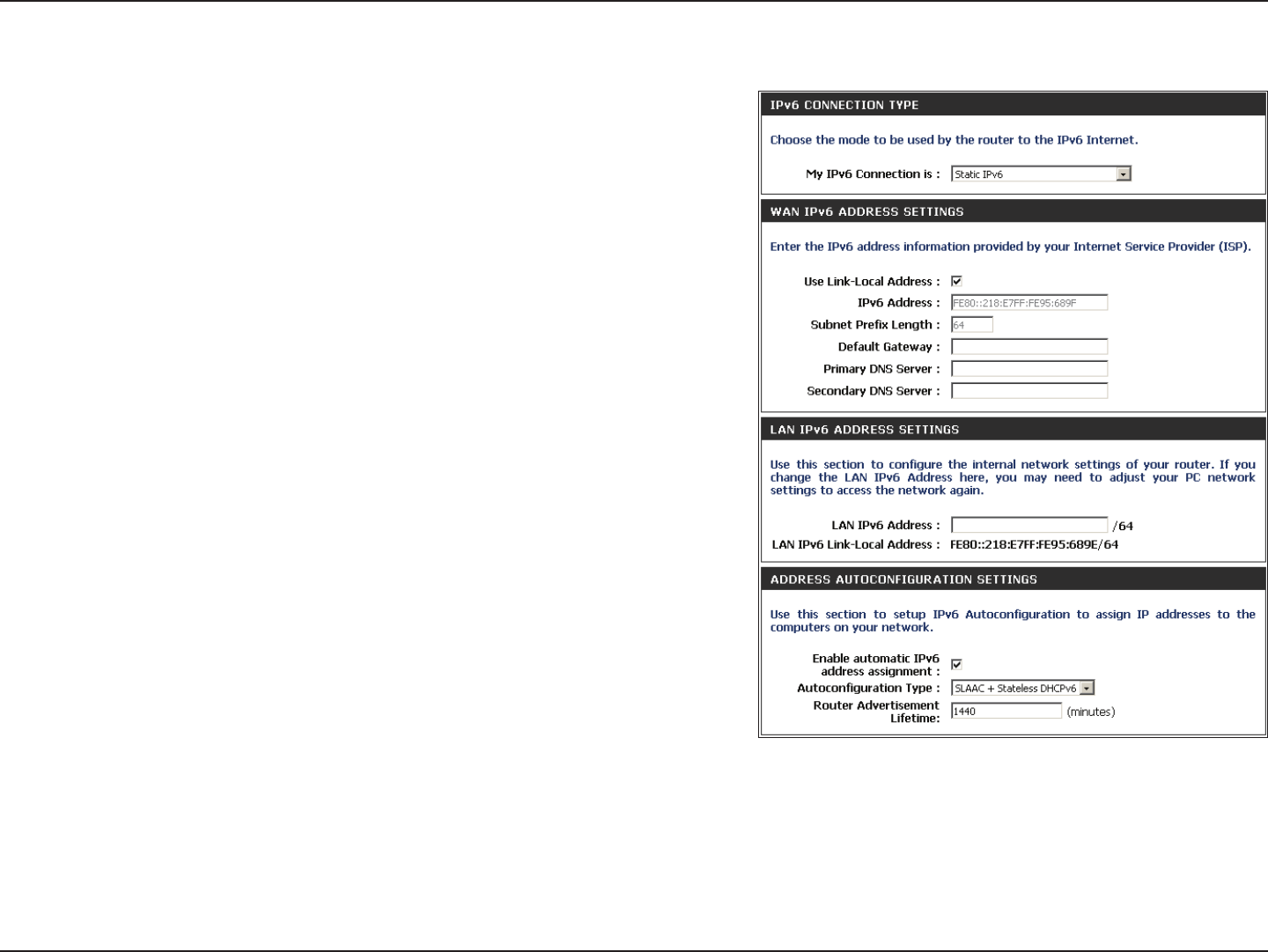
73D-Link DIR-850L User Manual
Section 3 - Conguration
Static IPv6
Select Static IPv6 from the drop-down menu.
Enter the address settings supplied by your Internet provider
(ISP).
Enter the LAN (local) IPv6 address for the router.
Displays the Router’s LAN Link-Local Address.
Check to enable the Autoconguration feature.
Select Stateful (DHCPv6), SLAAC + RDNSS or SLAAC +
Stateless DHCPv6.
Enter the start IPv6 Address for the DHCPv6 range for your
local computers.
Enter the end IPv6 Address for the DHCPv6 range for your
local computers.
Enter the IPv6 Address Lifetime (in minutes).
My IPv6 Connection:
WAN IPv6 Address
Settings:
LAN IPv6 Address:
LAN Link-Local Address:
Enable
Autoconguration:
Autoconguration Type:
IPv6 Address Range
Start:
IPv6 Address Range
End:
IPv6 Address Lifetime:
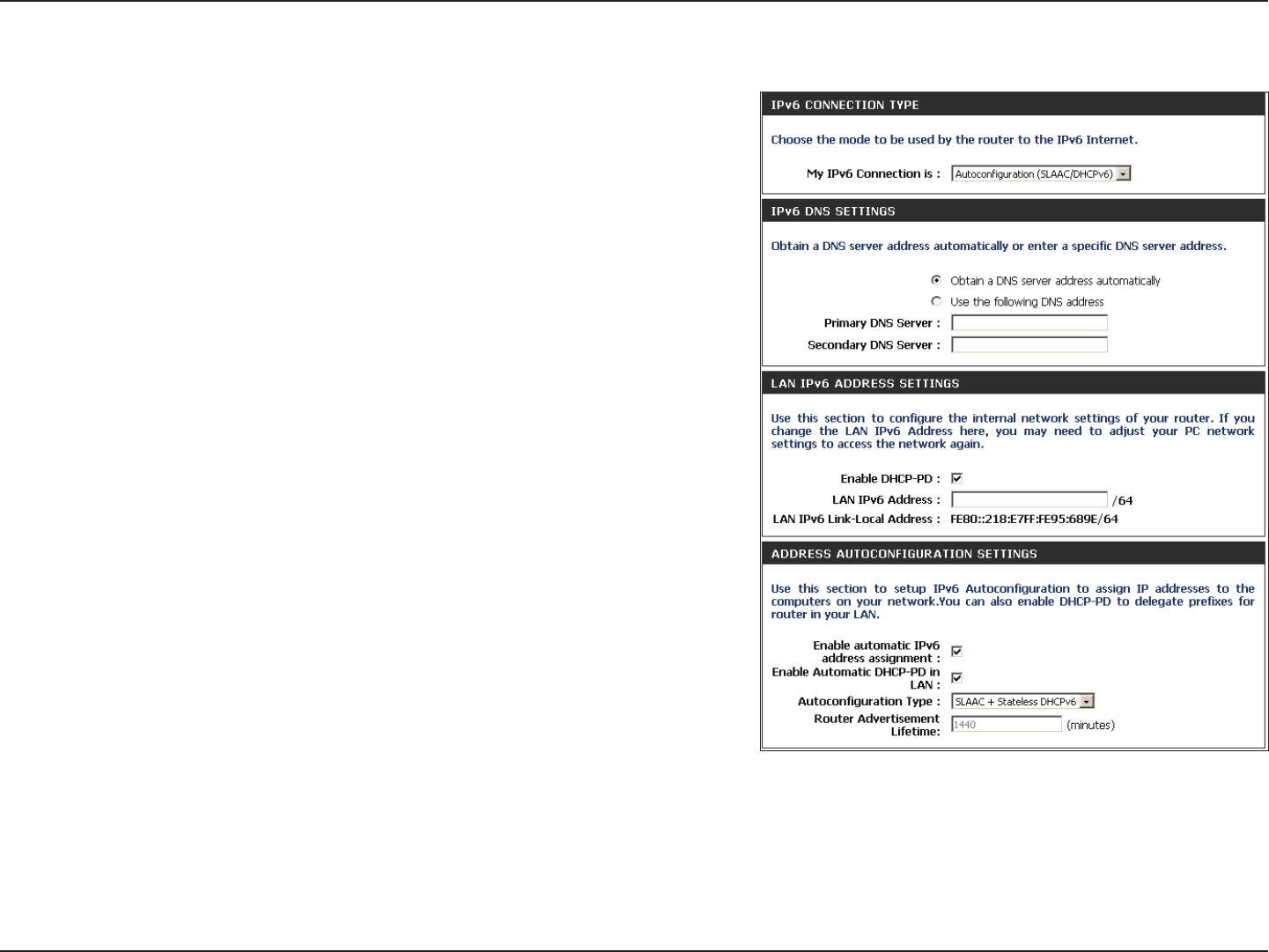
74D-Link DIR-850L User Manual
Section 3 - Conguration
Autoconguration
Select Autoconguration (Stateless/DHCPv6) from the
drop-down menu.
Select either Obtain DNS server address automatically or
Use the following DNS Address.
Enter the primary and secondary DNS server addresses.
Enter the LAN (local) IPv6 address for the router.
Displays the Router’s LAN Link-Local Address.
Check to enable the Autoconguration feature.
Select Stateful (DHCPv6), SLAAC + RDNSS or SLAAC +
Stateless DHCPv6.
Enter the start IPv6 Address for the DHCPv6 range for your
local computers.
Enter the end IPv6 Address for the DHCPv6 range for your
local computers.
Enter the IPv6 Address Lifetime (in minutes).
My IPv6 Connection:
IPv6 DNS Settings:
Primary/Secondary DNS
Address:
LAN IPv6 Address:
LAN Link-Local Address:
Enable
Autoconguration:
Autoconguration Type:
IPv6 Address Range
Start:
IPv6 Address Range
End:
IPv6 Address Lifetime:
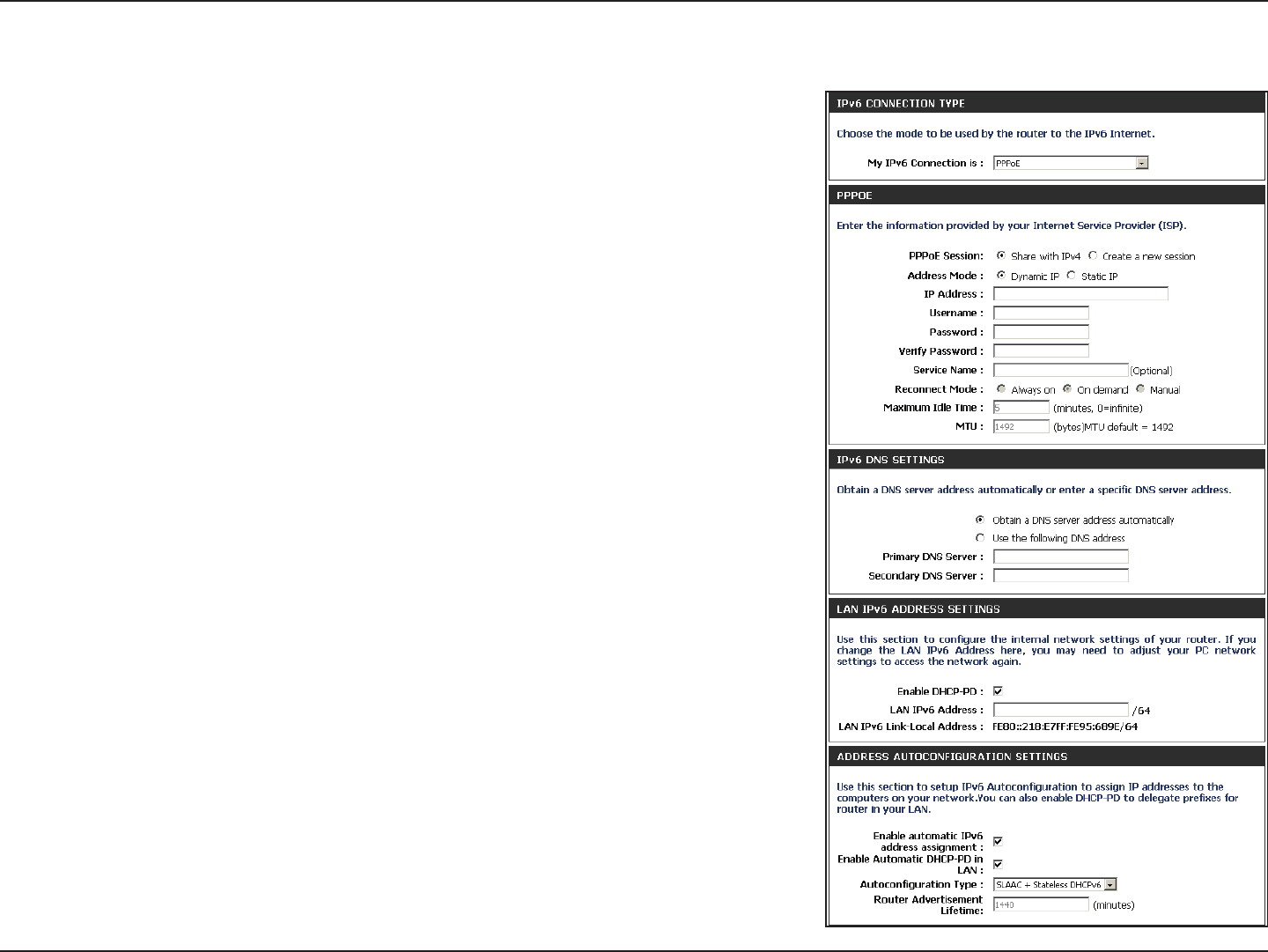
75D-Link DIR-850L User Manual
Section 3 - Conguration
PPPoE
Select PPPoE from the drop-down menu.
Enter the PPPoE account settings supplied by your Internet
provider (ISP).
Select Static if your ISP assigned you the IP address, subnet mask,
gateway, and DNS server addresses. In most cases, select Dynamic.
Enter the IP address (Static PPPoE only).
Enter your PPPoE user name.
Enter your PPPoE password and then retype the password in the
next box.
Enter the ISP Service Name (optional).
Select either Always-on, On-Demand, or Manual.
Enter a maximum idle time during which the Internet connection
is maintained during inactivity. To disable this feature, enable
Auto-reconnect.
Maximum Transmission Unit - you may need to change the MTU for
optimal performance with your specic ISP. 1492 is the default MTU.
Select either Obtain DNS server address automatically or Use
the following DNS Address.
Enter the primary and secondary DNS server addresses.
Enter the LAN (local) IPv6 address for the router.
Displays the Router’s LAN Link-Local Address.
Check to enable the Autoconguration feature.
My IPv6 Connection:
PPPoE:
Address Mode:
IP Address:
User Name:
Password:
Service Name:
Reconnection Mode:
Maximum Idle Time:
MTU:
IPv6 DNS Settings:
Primary/Secondary DNS
Address:
LAN IPv6 Address:
LAN Link-Local Address:
Enable Autoconguration:

76D-Link DIR-850L User Manual
Section 3 - Conguration
Autoconguration Type:
IPv6 Address Range Start:
IPv6 Address Range End:
IPv6 Address Lifetime:
Select Stateful (DHCPv6), SLAAC + RDNSS or SLAAC + Stateless DHCPv6.
Enter the start IPv6 Address for the DHCPv6 range for your local computers.
Enter the end IPv6 Address for the DHCPv6 range for your local computers.
Enter the IPv6 Address Lifetime (in minutes).
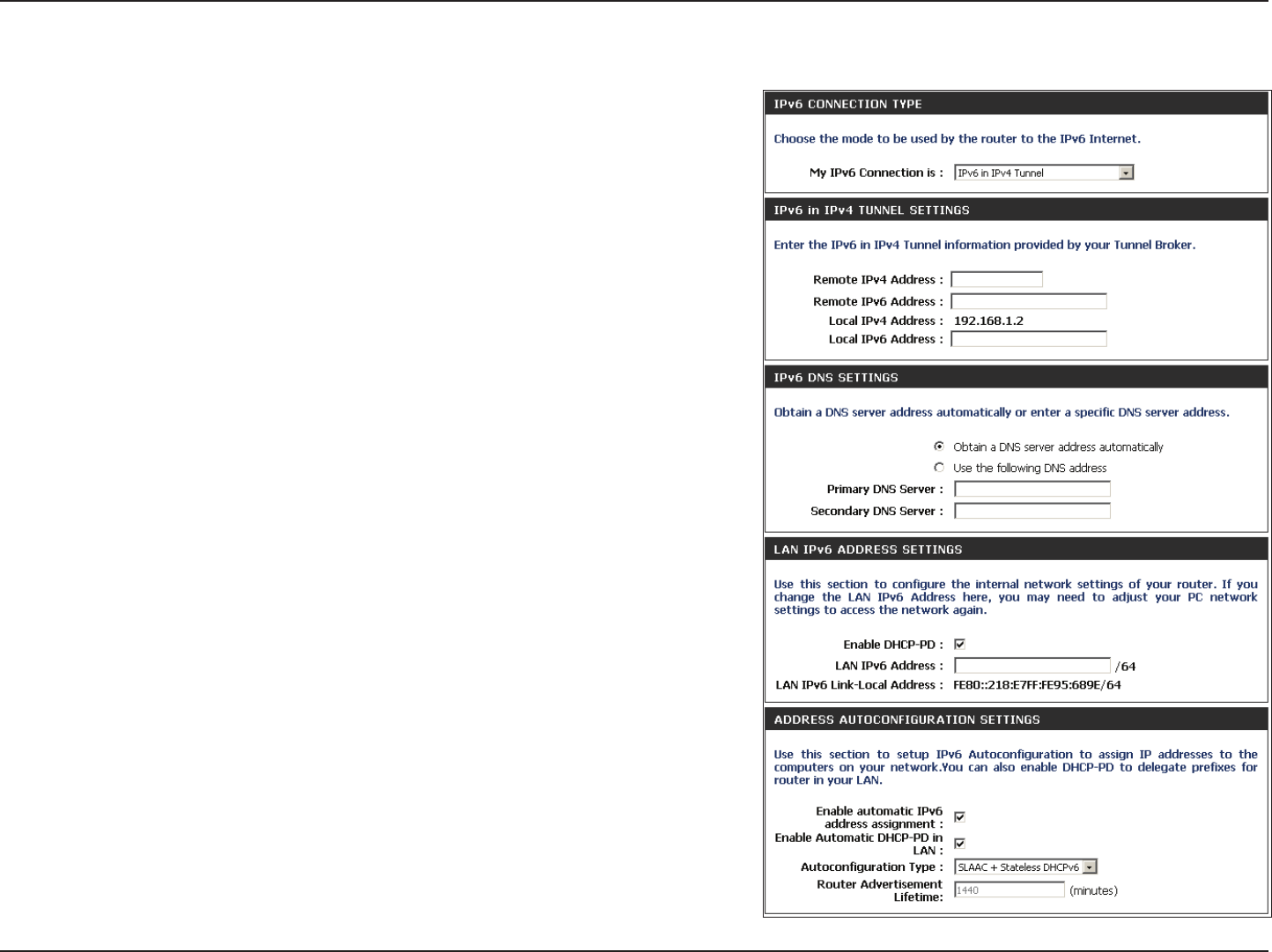
77D-Link DIR-850L User Manual
Section 3 - Conguration
IPv6 in IPv4 Tunneling
Select IPv6 in IPv4 Tunnel from the drop-down menu.
Enter the settings supplied by your Internet provider (ISP).
Enter the LAN (local) IPv6 address for the router.
Displays the Router’s LAN Link-Local Address.
Check to enable the Autoconguration feature.
Select Stateful (DHCPv6), SLAAC + RDNSS or SLAAC + Stateless
DHCPv6.
Enter the start IPv6 Address for the DHCPv6 range for your local
computers.
Enter the end IPv6 Address for the DHCPv6 range for your local
computers.
Enter the Router Advertisement Lifetime (in minutes).
My IPv6
Connection:
IPv6 in IPv4 Tunnel
Settings:
LAN IPv6 Address:
LAN Link-Local
Address:
Enable
Autoconguration:
Autoconguration
Type:
IPv6 Address
Range Start:
IPv6 Address
Range End:
Pv6 Address
Lifetime:
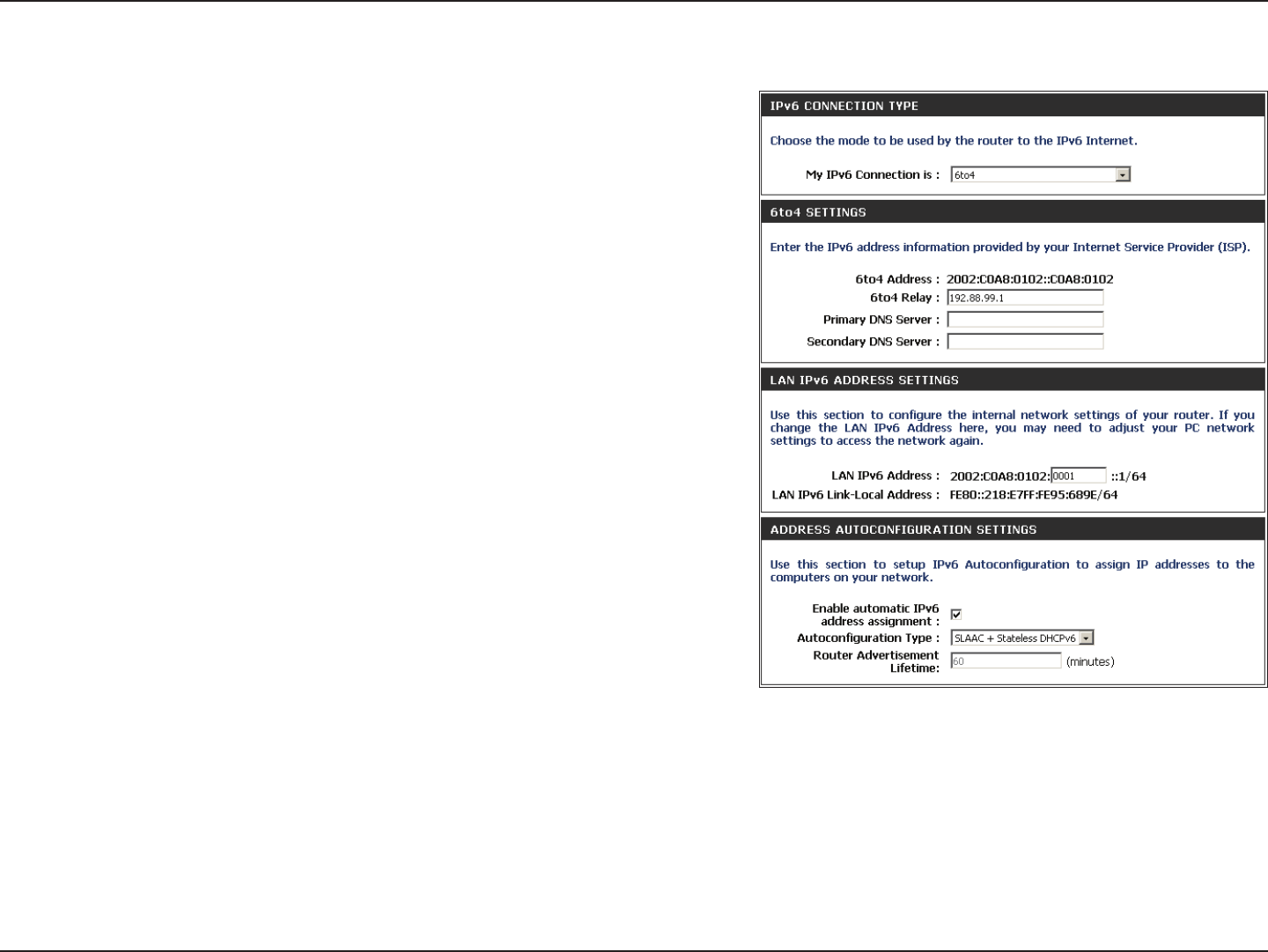
78D-Link DIR-850L User Manual
Section 3 - Conguration
6 to 4 Tunneling
Select 6 to 4 from the drop-down menu.
Enter the IPv6 settings supplied by your Internet provider (ISP).
Enter the primary and secondary DNS server addresses.
Enter the LAN (local) IPv6 address for the router.
Displays the Router’s LAN Link-Local Address.
Check to enable the Autoconguration feature.
Select Stateful (DHCPv6), SLAAC + RDNSS or SLAAC + Stateless
DHCPv6.
Enter the start IPv6 Address for the DHCPv6 range for your local
computers.
Enter the end IPv6 Address for the DHCPv6 range for your local
computers.
Enter the IPv6 Address Lifetime (in minutes).
My IPv6 Connection:
6 to 4 Settings:
Primary/Secondary
DNS Address:
LAN IPv6 Address:
LAN Link-Local
Address:
Enable
Autoconguration:
Autoconguration
Type:
IPv6 Address Range
Start:
IPv6 Address Range
End:
IPv6 Address
Lifetime:
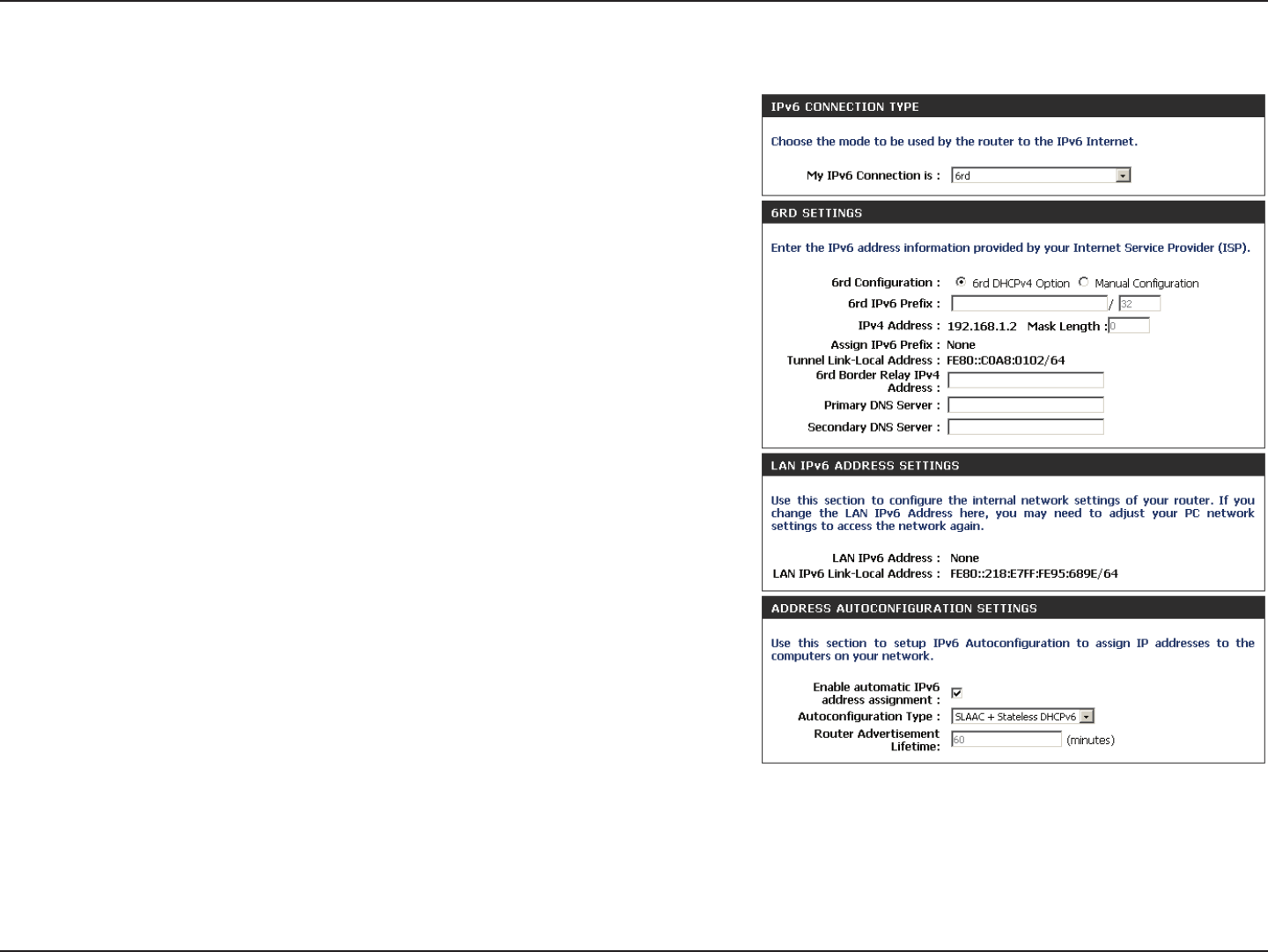
79D-Link DIR-850L User Manual
Section 3 - Conguration
6rd
Select 6rd from the drop-down menu.
Enter the address settings supplied by your Internet provider
(ISP).
Enter the LAN (local) IPv6 address for the router.
Displays the Router’s LAN Link-Local Address.
Check to enable the Autoconguration feature.
Select Stateful (DHCPv6), SLAAC+RDNSS or SLAAC + Stateless
DHCPv6.
Enter the Router Advertisement Lifetime (in minutes).
My IPv6 Connection:
6RD Settings:
LAN IPv6 Address:
LAN Link-Local Address:
Enable
Autoconguration:
Autoconguration Type:
Router Advertisement
Lifetime:
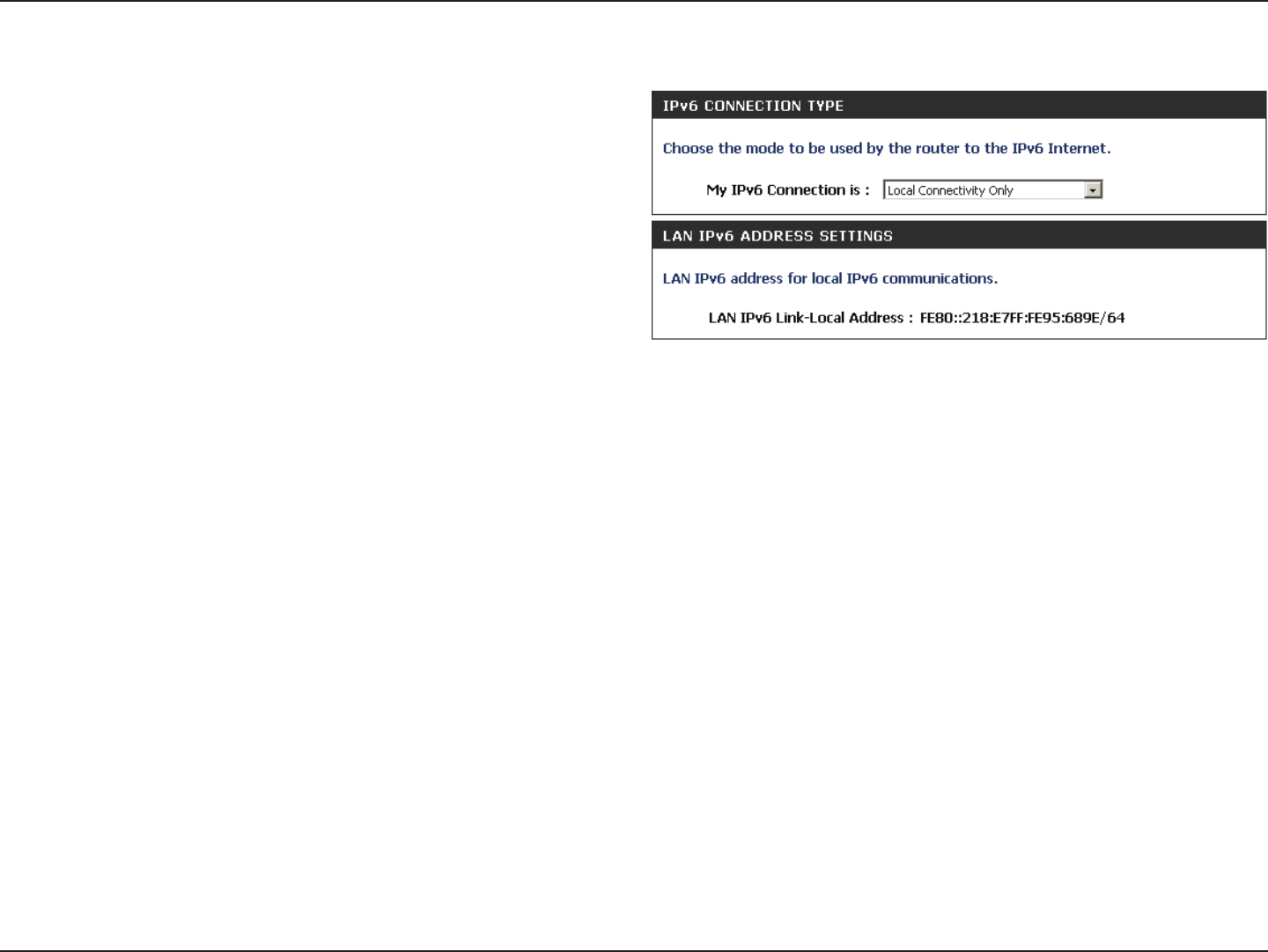
80D-Link DIR-850L User Manual
Section 3 - Conguration
Select Link-Local Only from the drop-down
menu.
Displays the IPv6 address of the router.
My IPv6 Connection:
LAN IPv6 Address
Settings:
Link-Local Connectivity
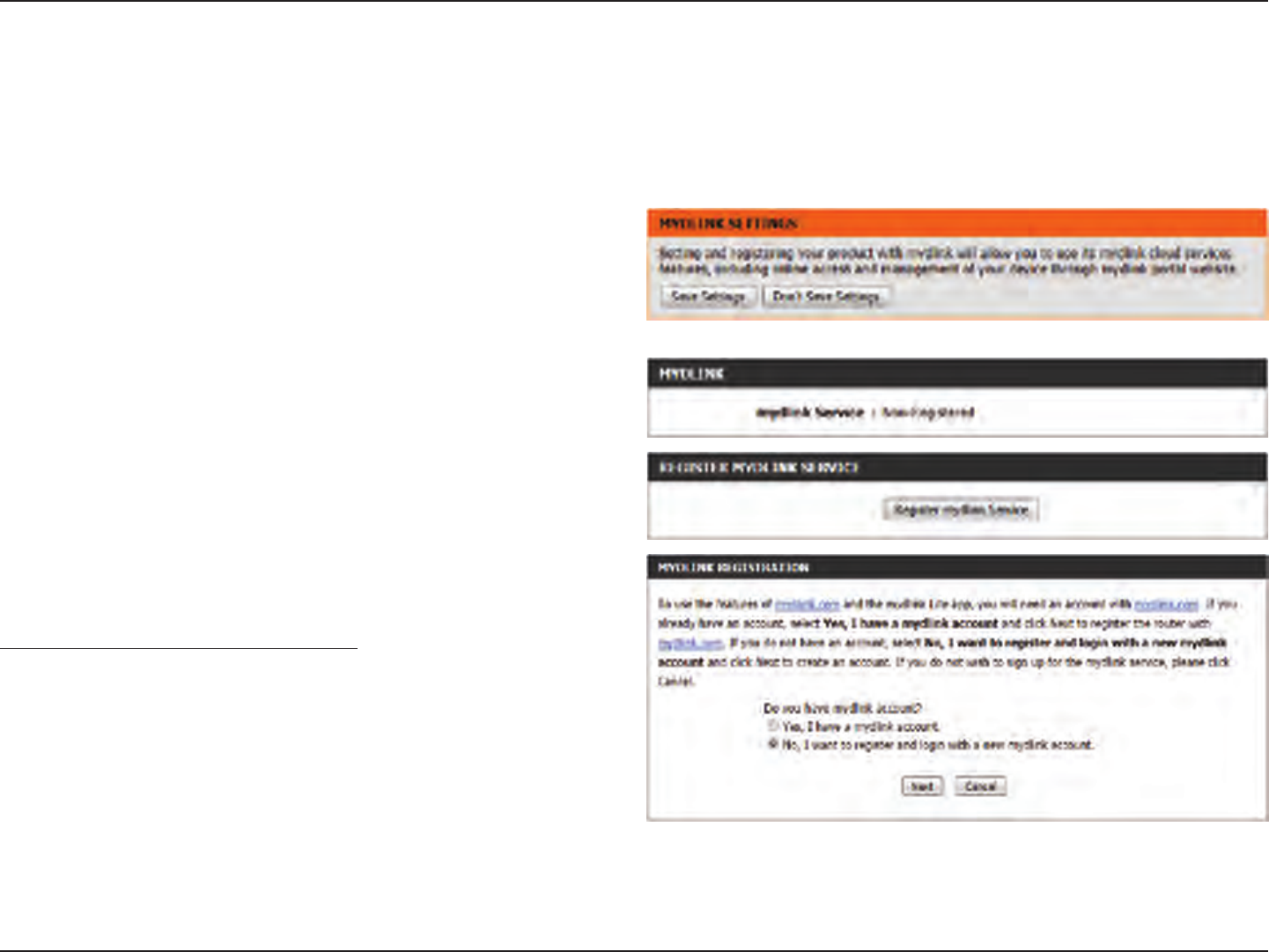
81D-Link DIR-850L User Manual
mydlink Settings
On this page the user can congure the mydlink™ settings for this
router. This feature will allow us to use the mydlink cloud services that
includes online access and management of this router through the
mydlink portal website or portable device applications like iOS apps and
Android applications.
In the mydlink section, we can view the registration status of the
mydlink account service. The mydlink Service eld will either display
Registered or Non-Registered.
In the Register mydlink Service section, we can register or modify a
mydlink account. Click on the Register mydlink Service button to initi-
ate this procedure.
After clicking the Register mydlink Service button, this window will ap-
pear.
Register mydlink Service Wizard: Step 1
In this section we can select one of two options.
• Select the ‘Yes, I have a mydlink account.’ option if you already have
a mydlink account that you want to use on this router.
• Select the ‘No, I want to register and login with a new mydlink ac-
count.’ option to register a new account and use it on this router.
Click the Next button to proceed to the next step.
Click the Cancel button to discard the changes made and return to the
main page.
The DIR-865L features a new cloud service that pushes information such as rmware upgrade notications, user activity, and intrusion alerts to
the mydlink™ app on Android and Apple mobile devices. To insure that your router is up-to-date with the latest features, mydlink™ will notify you
when an update is available for your router. You can also monitor a user’s online activity with real-time website browsing history, maintaining a
safe and secure environment, especially for children at home.
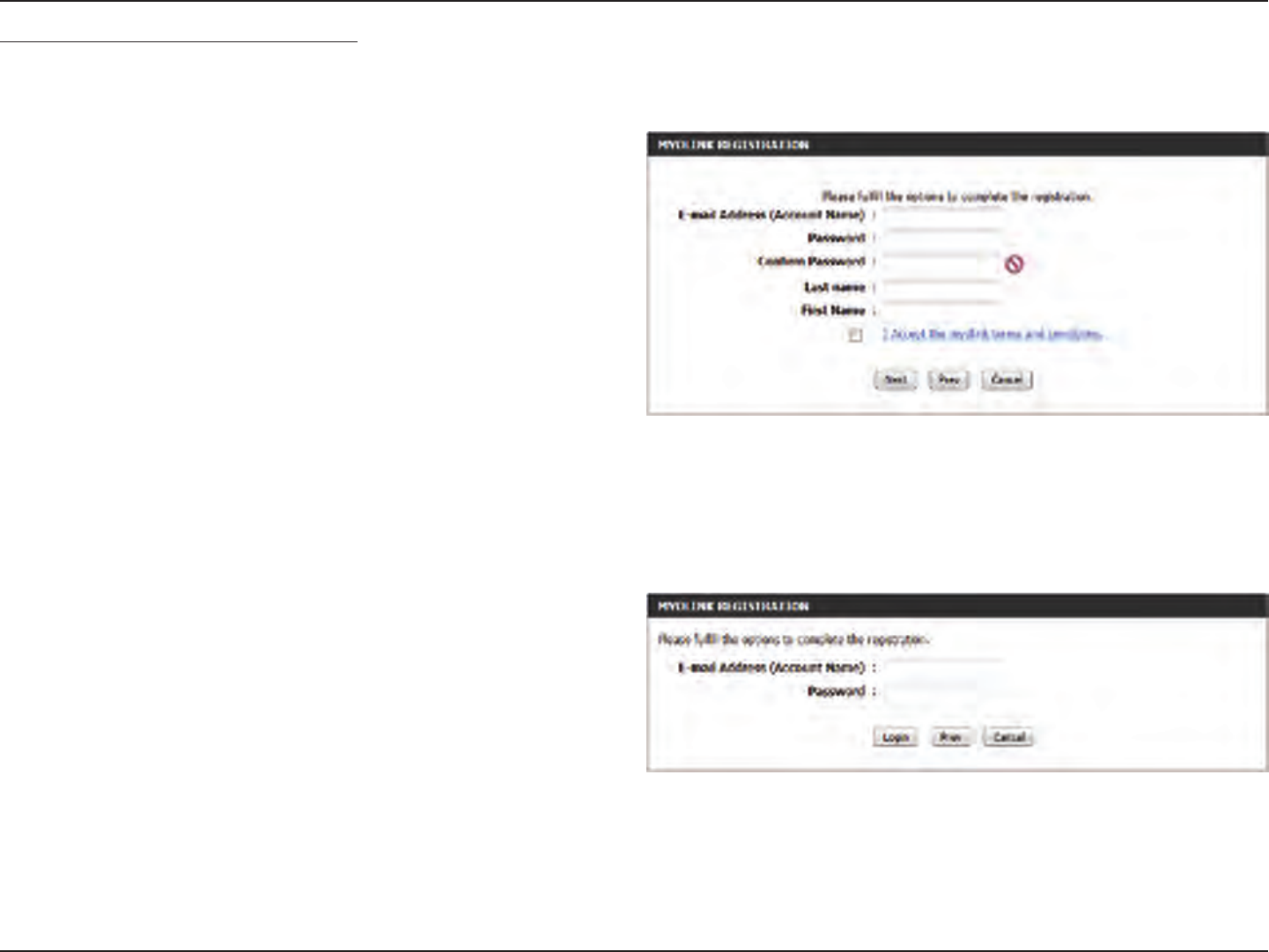
82D-Link DIR-850L User Manual
Register mydlink Service Wizard: Step 2
When registering a new account, the following page appears. The fol-
lowing parameters will be available for conguration:
E-mail Address (Account
Name):
Enter your e-mail address here. This e-mail
address will also become your account
name.
Password: Enter your preferred password choice
here.
Conrm Password: Re-enter your preferred password choice
here.
Last Name: Enter your last name here.
First Name: Enter your rst name here.
Accept terms and
conditions:
Tick this option to accept the mydlink
terms and conditions.
Click the Next button to proceed to the next step.
Click the Prev button to return to the previous step.
Click the Cancel button to discard the changes made and return to the
main page.
When logging in with an existing account, the following page appears.
The following parameters will be available for conguration:
E-mail Address (Account
Name):
Enter your e-mail address here. This e-mail
address will also be your account name.
Password: Enter your preferred password choice
here.
Click the Login button to login using these account details.
Click the Prev button to return to the previous step.
Click the Cancel button to discard the changes made and return to the
main page.
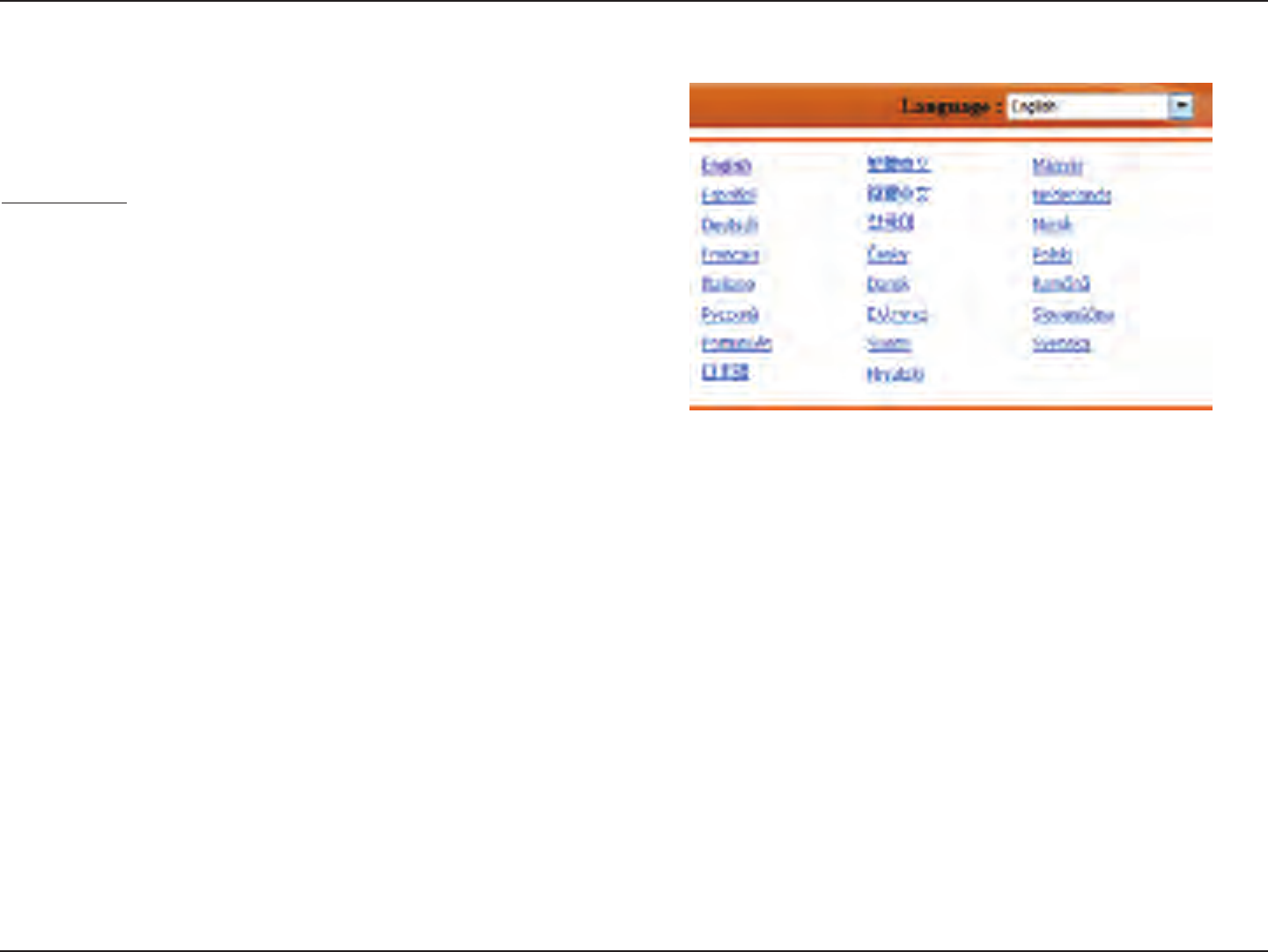
83D-Link DIR-850L User Manual
At any point during this wizard, we can change the prefered language
used. To change the language, select the desired language option from
the Language drop-down menu, found on the top right of this page.
End of Wizard
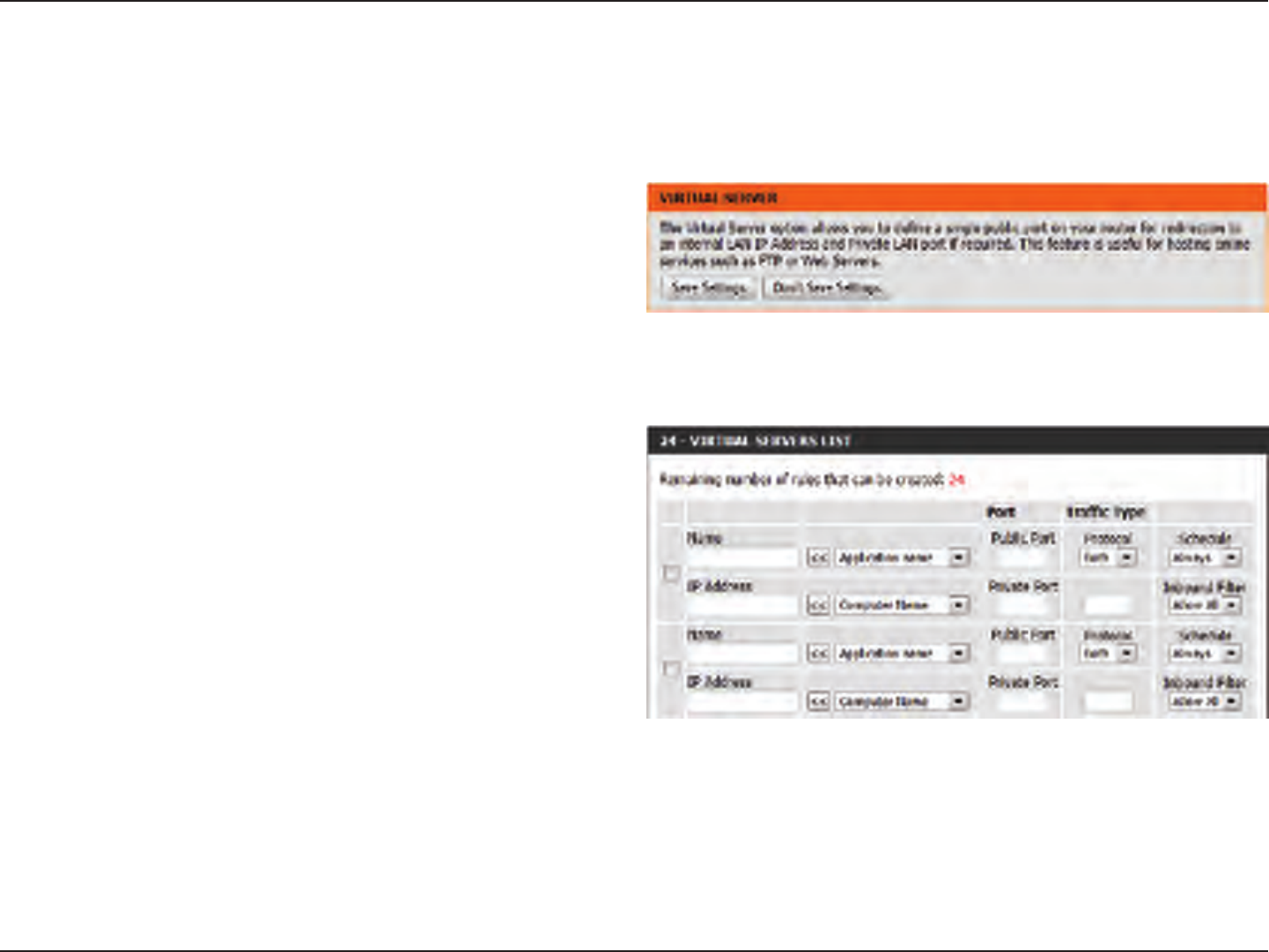
84D-Link DIR-850L User Manual
Section 3 - Conguration
This will allow you to open a single port. If you would like to open a range of ports, refer to the next page.
Enter a name for the rule or select an application from
the drop-down menu. Select an application and click
<< to populate the elds.
Enter the IP address of the computer on your local
network that you want to allow the incoming
service to. If your computer is receiving an IP address
automatically from the router (DHCP), you computer
will be listed in the “Computer Name” drop-down
menu. Select your computer and click <<.
Enter the port that you want to open next to Private
Port and Public Port. The private and public ports are
usually the same. The public port is the port seen from
the Internet side, and the private port is the port being
used by the application on the computer within your
local network.
Select TCP, UDP, or Both from the drop-down menu.
The schedule of time when the Virtual Server Rule
will be enabled. The schedule may be set to Always,
which will allow the particular service to always be
enabled. You can create your own times in the Tools
> Schedules section.
Select Allow All (most common) or a created Inbound
lter. You may create your own inbound lters in the
Advanced > Inbound Filter page.
Name:
IP Address:
Private Port/
Public Port:
Protocol Type:
Schedule:
Inbound Filter:
Virtual Server
Advanced
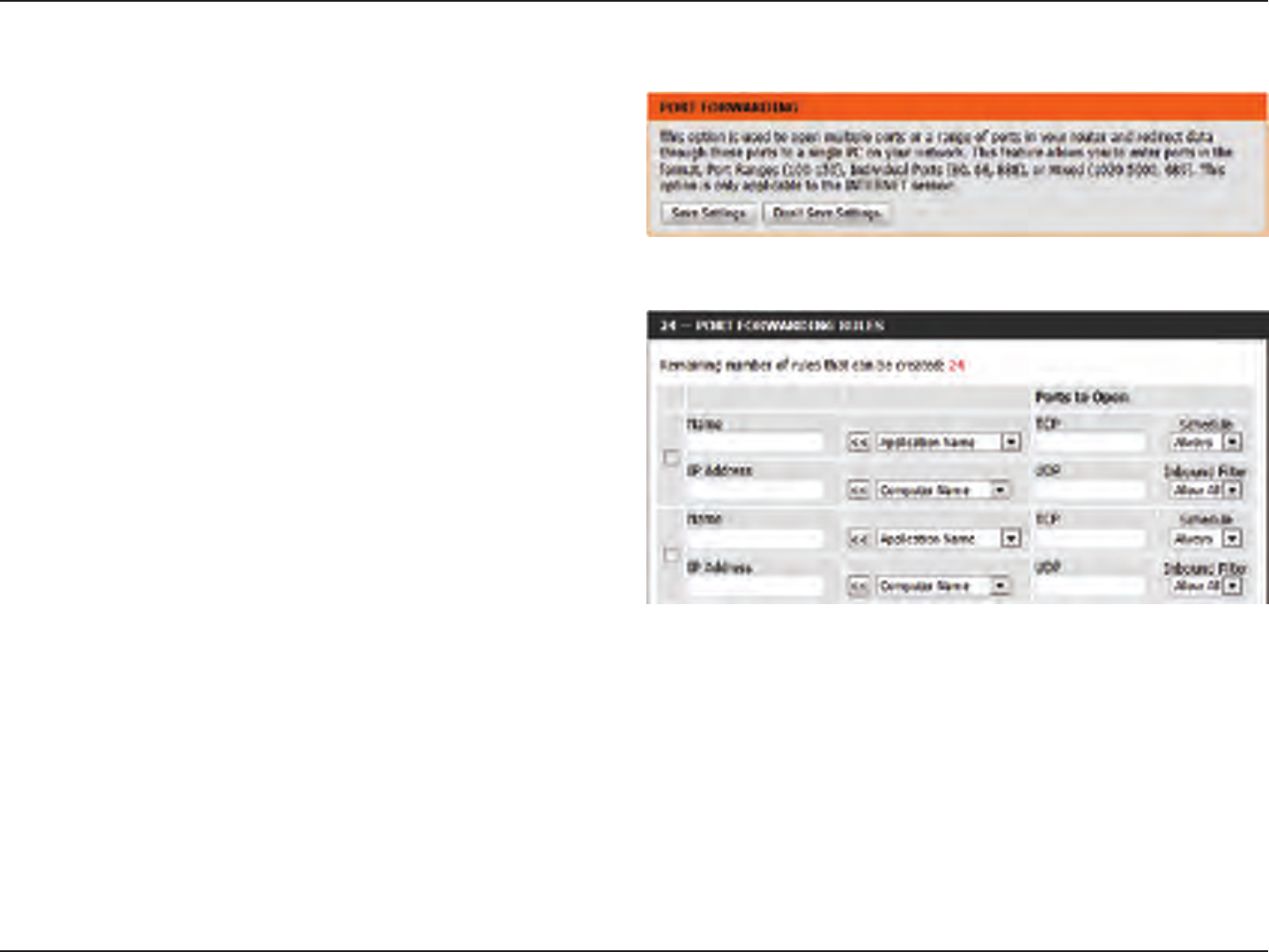
85D-Link DIR-850L User Manual
Section 3 - Conguration
This will allow you to open a single port or a range of ports.
Port Forwarding
Enter a name for the rule or select an application
from the drop-down menu. Select an application
and click << to populate the elds.
Enter the IP address of the computer on your local
network that you want to allow the incoming service
to. If your computer is receiving an IP address
automatically from the router (DHCP), you computer
will be listed in the “Computer Name” drop-down
menu. Select your computer and click <<.
Enter the TCP and/or UDP port or ports that you
want to open. You can enter a single port or a range
of ports. Separate ports with a common.
Example: 24,1009,3000-4000
The schedule of time when the Virtual Server Rule
will be enabled. The schedule may be set to Always,
which will allow the particular service to always be
enabled. You can create your own times in the Tools
> Schedules section.
Select Allow All (most common) or a created
Inbound lter. You may create your own inbound
lters in the Advanced > Inbound Filter page.
Name:
IP Address:
TCP/UDP:
Schedule:
Inbound Filter:
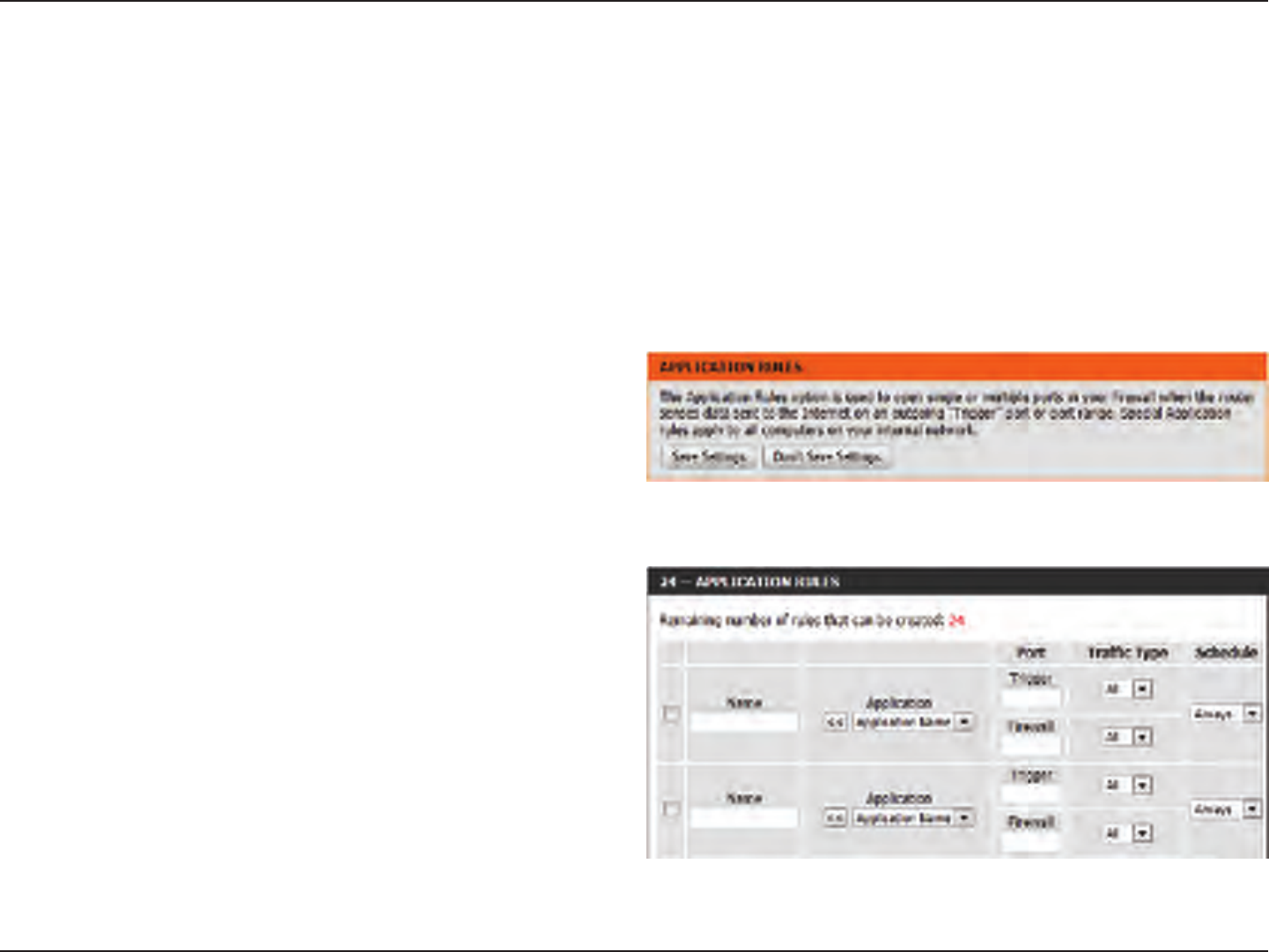
86D-Link DIR-850L User Manual
Section 3 - Conguration
Enter a name for the rule. You may select a
pre-dened application from the drop-down menu
and click <<.
This is the port used to trigger the application. It
can be either a single port or a range of ports.
Select the protocol of the trigger port (TCP, UDP,
or Both).
This is the port number on the Internet side that
will be used to access the application. You may
dene a single port or a range of ports. You can
use a comma to add multiple ports or port ranges.
Select the protocol of the rewall port (TCP, UDP,
or Both).
The schedule of time when the Application Rule
will be enabled. The schedule may be set to Always,
which will allow the particular service to always
be enabled. You can create your own times in the
Tools > Schedules section.
Name:
Trigger:
Trac Type:
Firewall:
Trac Type:
Schedule:
Application Rules
Some applications require multiple connections, such as Internet gaming, video conferencing, Internet telephony and others.
These applications have diculties working through NAT (Network Address Translation). Special Applications makes some of
these applications work with the DIR-850L. If you need to run applications that require multiple connections, specify the port
normally associated with an application in the “Trigger Port” eld, select the protocol type as TCP or UDP, then enter the rewall
(public) ports associated with the trigger port to open them for inbound trac.
The DIR-850L provides some predened applications in the table on the bottom of the web page. Select the application you
want to use and enable it.
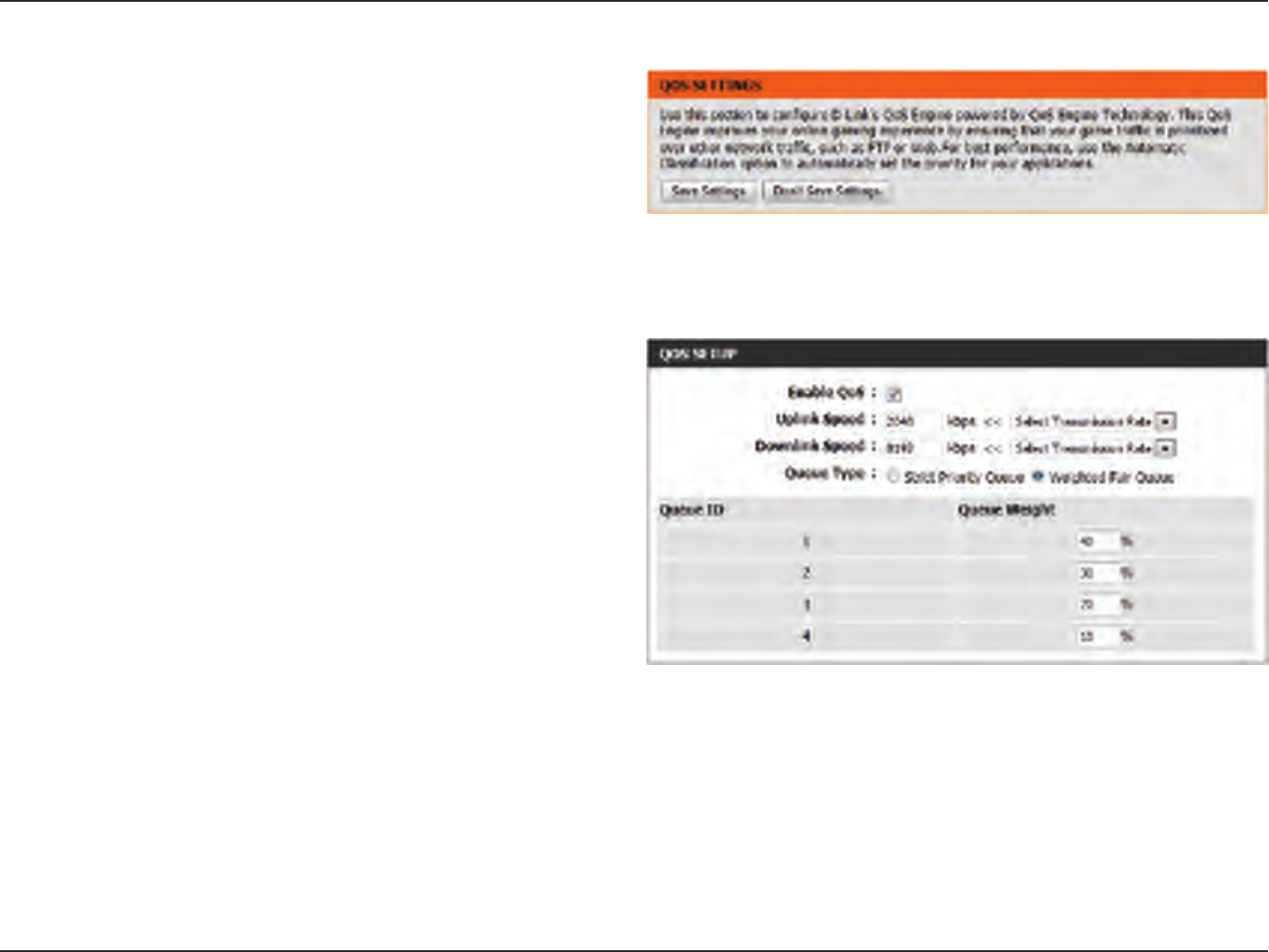
87D-Link DIR-850L User Manual
Section 3 - Conguration
QoS Engine
The QoS Engine option helps improve your network gaming performance by
prioritizing applications. By default the QoS Engine settings are disabled and
application priority is not classied automatically. The QoS section contains a
queuing mechanism, trac shaping and classication. It supports two kinds
of queuing mechanisms. Strict Priority Queue (SPQ) and Weighted Fair Queue
(WFQ). SPQ will process trac based on trac priority. Queue1 has the highest
priority and Queue4 has the lowest priority. WFQ will process trac based on
the queue weight. Users can congure each queue’s weight. The sum of all the queue’s weight must be 100. When surng the Internet, the system will do
trac shaping based on the uplink and downlink speed. The classication rules can be used to classify trac to dierent queues, then SPQ or WFQ will
do QoS based on the queue’s priority or weight.
The following parameters will be available for conguration:
Enable QoS: This option is disabled by default. Enable this option for
better performance and experience with online games and
other interactive applications, such as VoIP.
Uplink Speed: The speed at which data can be transferred from the
router to your ISP. This is determined by your ISP. ISP’s often
dene speed as a download/upload pair. For example,
1.5Mbits/284Kbits. Using this example, you would enter
284. Alternatively you can test your uplink speed with a
service such as www.dslreports.com.
Downlink Speed: The speed at which data can be transferred from the ISP
to the router. This is determined by your ISP. ISP’s often
dene speed as a download/upload pair. For example,
1.5Mbits/284Kbits.
Using this example, you would enter 1500. Alternatively
you can test your downlink speed with a service such as
www.dslreports.com.
Queue Type: Here the user can specify the queue type used. When choosing the option Strict Priority Queue, the router will apply QoS based on the
internal specication for the queue ID’s listed. When choosing the option Weight Fair Queue, the router will apply QoS based on the user
dened percentage in the Queue Weight column.
Queue ID: In this column the Queue ID used will be displayed.
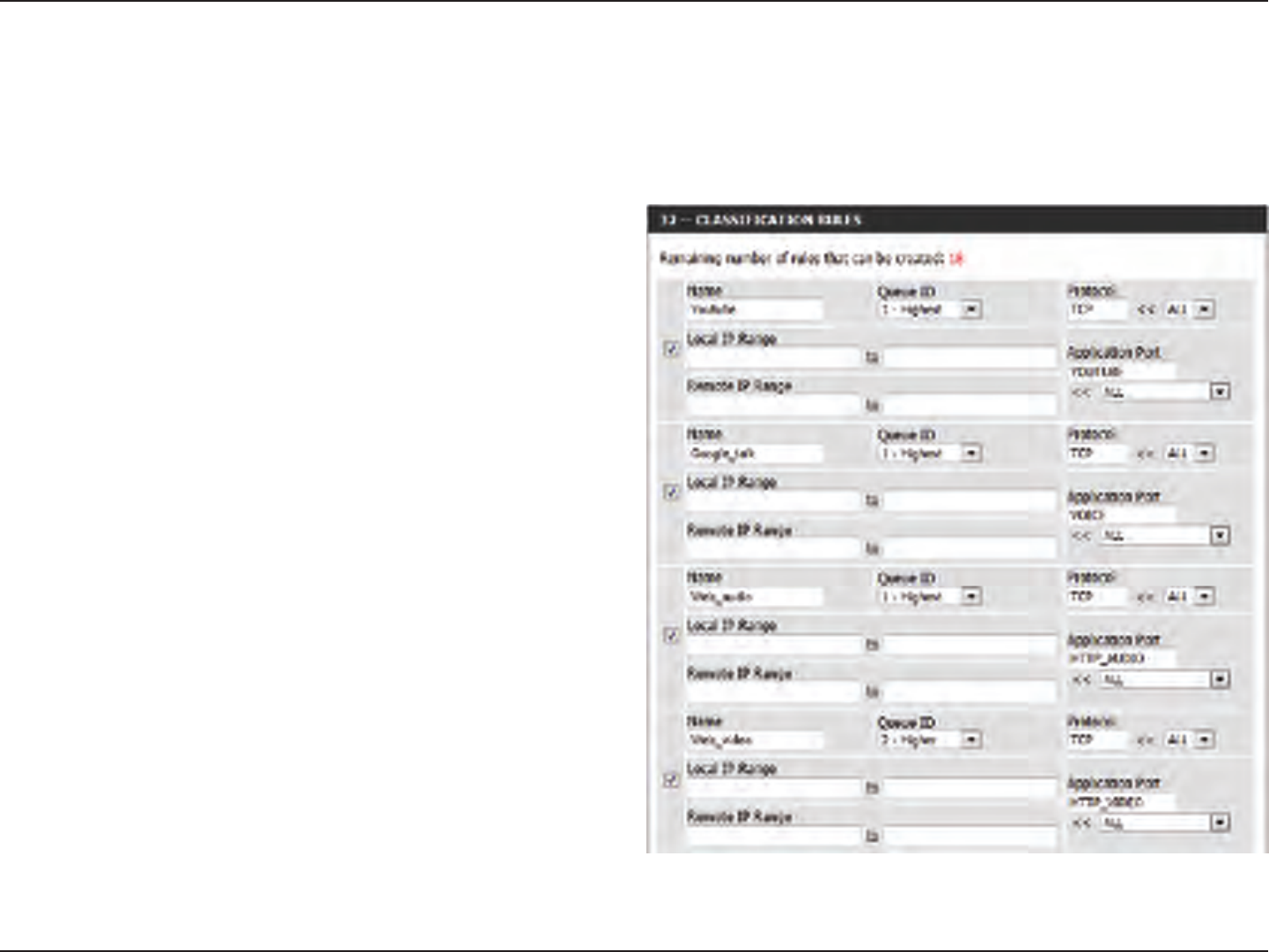
88D-Link DIR-850L User Manual
Section 3 - Conguration
The following parameters will be available for conguration:
Checkbox: Tick this option to enable the rule specied.
Name: Enter a custom name for the rule being created here.
This name is used for identication.
Queue ID: Select the appropriate priority requirement from the
drop-down menu that will be applied to this rule. Op-
tion to choose from are Highest, Higher, Normal, and
Best Eort.
Protocol: Select the protocol used for the application for in the
drop-down menu and it will automatically place it in
the Protocol eld.
Local IP Range: Enter the local IP range used here. This is the IP range
of you Local Area Network. The Router’s IP cannot be
included in this range.
Remote IP
Range:
Enter the remote IP range used here. This is the IP
range of the public network from the Internet Port
side. To apply this rule to any IP addresses from the
public side, enter the range 0.0.0.1 to 255.255.255.254.
Application
Port:
Enter the application port number used here.
Click on the Save Settings button to accept the changes made.
Click on the Don’t Save Settings button to discard the changes made.
After specifying the QoS framework used, in the QoS setup section, the user can now create individual rules for scenarios that require the use of
trac control and data priority manipulation.
Queue Priority: In this column the Queue Priority used will be displayed.
Queue Weight: After choosing to use the Weight Fair Queue option, under Queue Type, the user will be able to manual enter
the Queue Weight for each individual Queue ID.
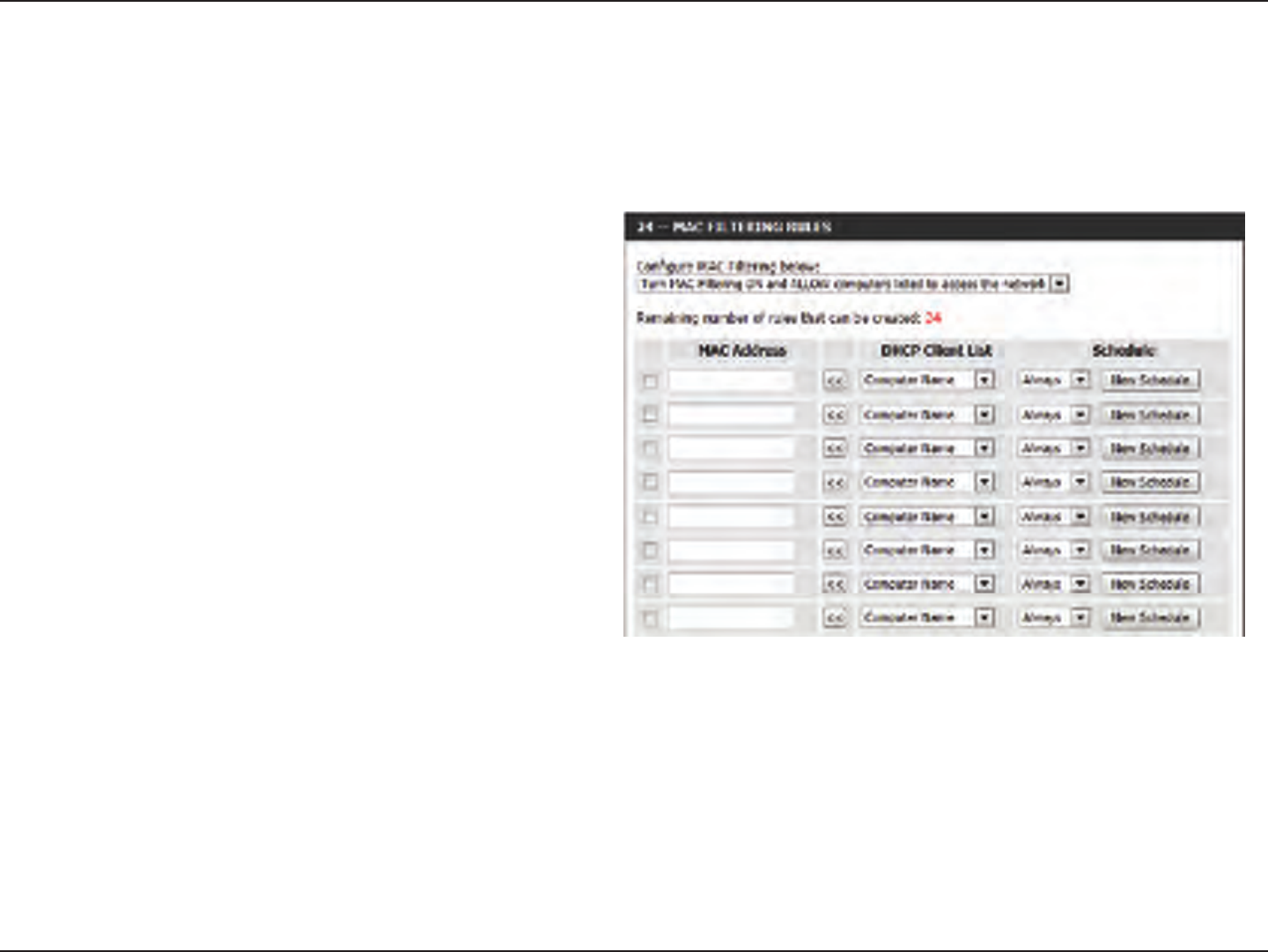
89D-Link DIR-850L User Manual
Section 3 - Conguration
Network Filters
Select Turn MAC Filtering O, Allow MAC addresses
listed below, or Deny MAC addresses listed below
from the drop-down menu.
Enter the MAC address you would like to lter.
To nd the MAC address on a computer, please refer
to the Networking Basics section in this manual.
Select a DHCP client from the drop-down menu and
click << to copy that MAC Address.
Congure MAC
Filtering:
MAC Address:
DHCP Client:
Use MAC (Media Access Control) Filters to allow or deny LAN (Local Area Network) computers by their MAC addresses from
accessing the network. You can either manually add a MAC address or select the MAC address from the list of clients that are
currently connected to the Broadband Router.
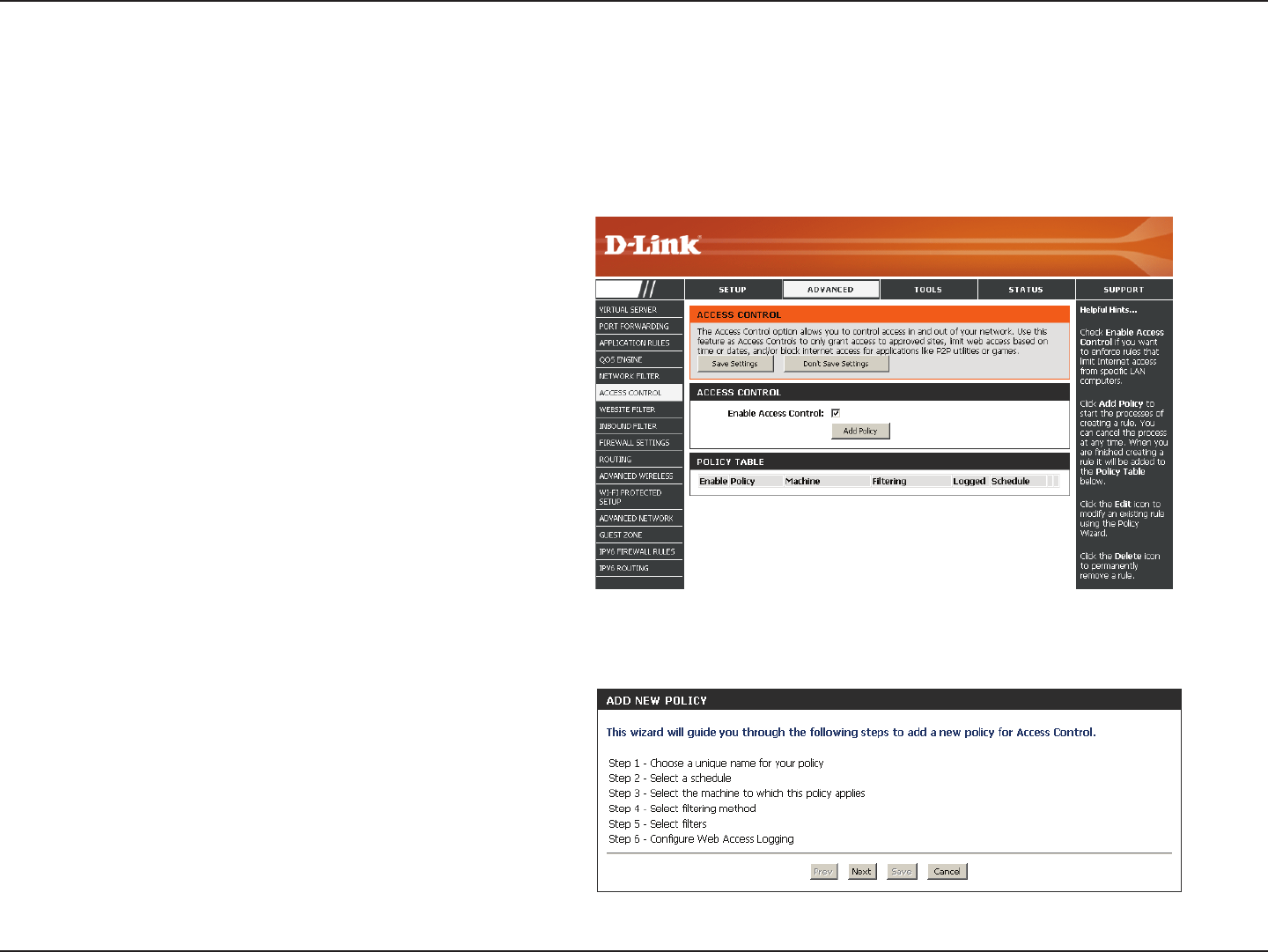
90D-Link DIR-850L User Manual
Section 3 - Conguration
Access Control
Click the Add Policy button to start the Access
Control Wizard.
Add Policy:
The Access Control section allows you to control access in and out of your network. Use this feature as Parental Controls to
only grant access to approved sites, limit web access based on time or dates, and/or block access from applications like P2P
utilities or games.
Click Next to continue with the wizard.
Access Control Wizard
DIR-850L
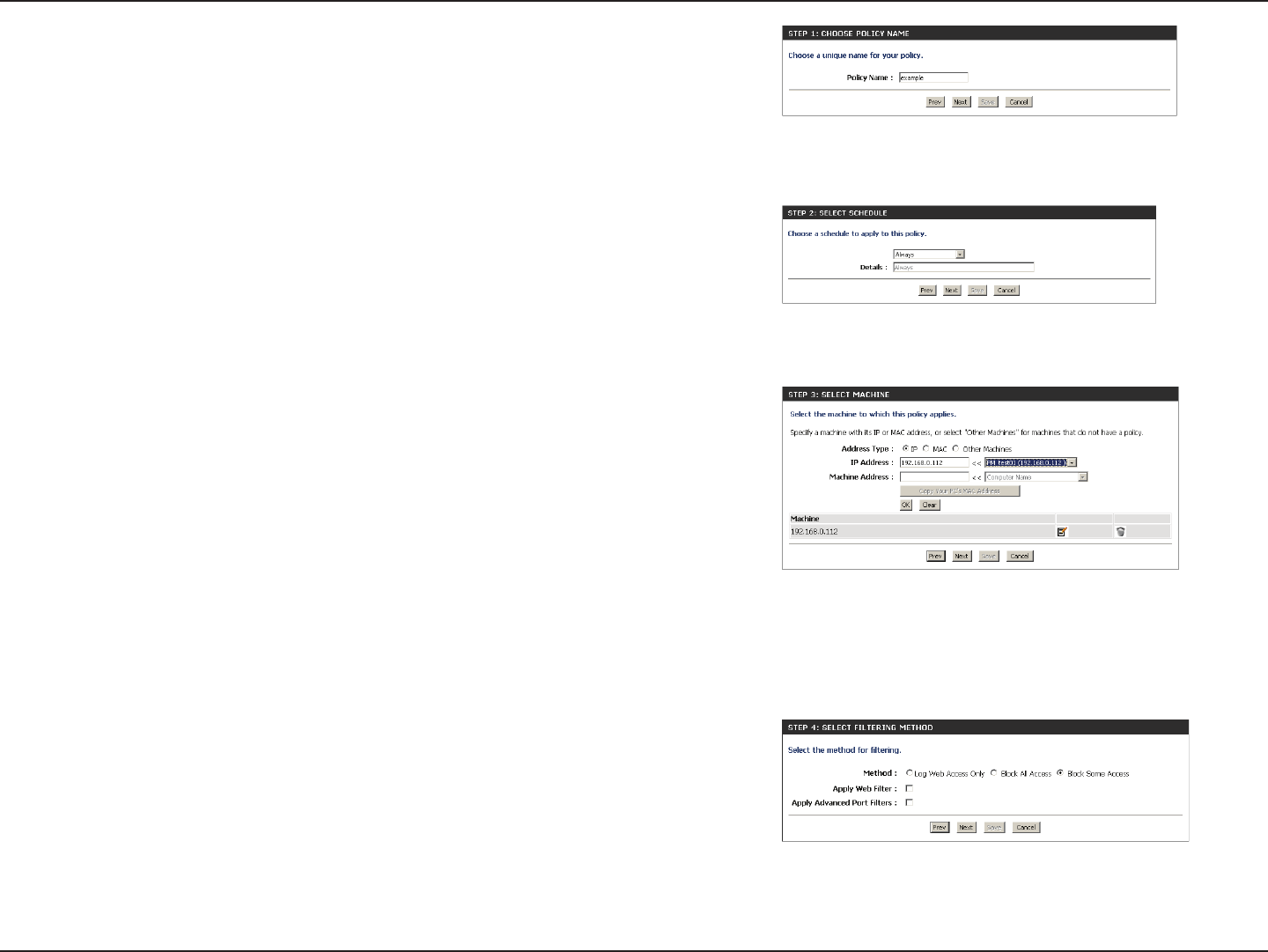
91D-Link DIR-850L User Manual
Section 3 - Conguration
Enter a name for the policy and then click Next to continue.
Select a schedule (I.E. Always) from the drop-down menu and
then click Next to continue.
Enter the following information and then click Next to continue.
• Address Type - Select IP address, MAC address, or Other
Machines.
• IP Address - Enter the IP address of the computer you want to
apply the rule to.
• Machine Address - Enter the PC MAC address (i.e. 00:00.00.00.00).
Select the ltering method and then click Next to continue.
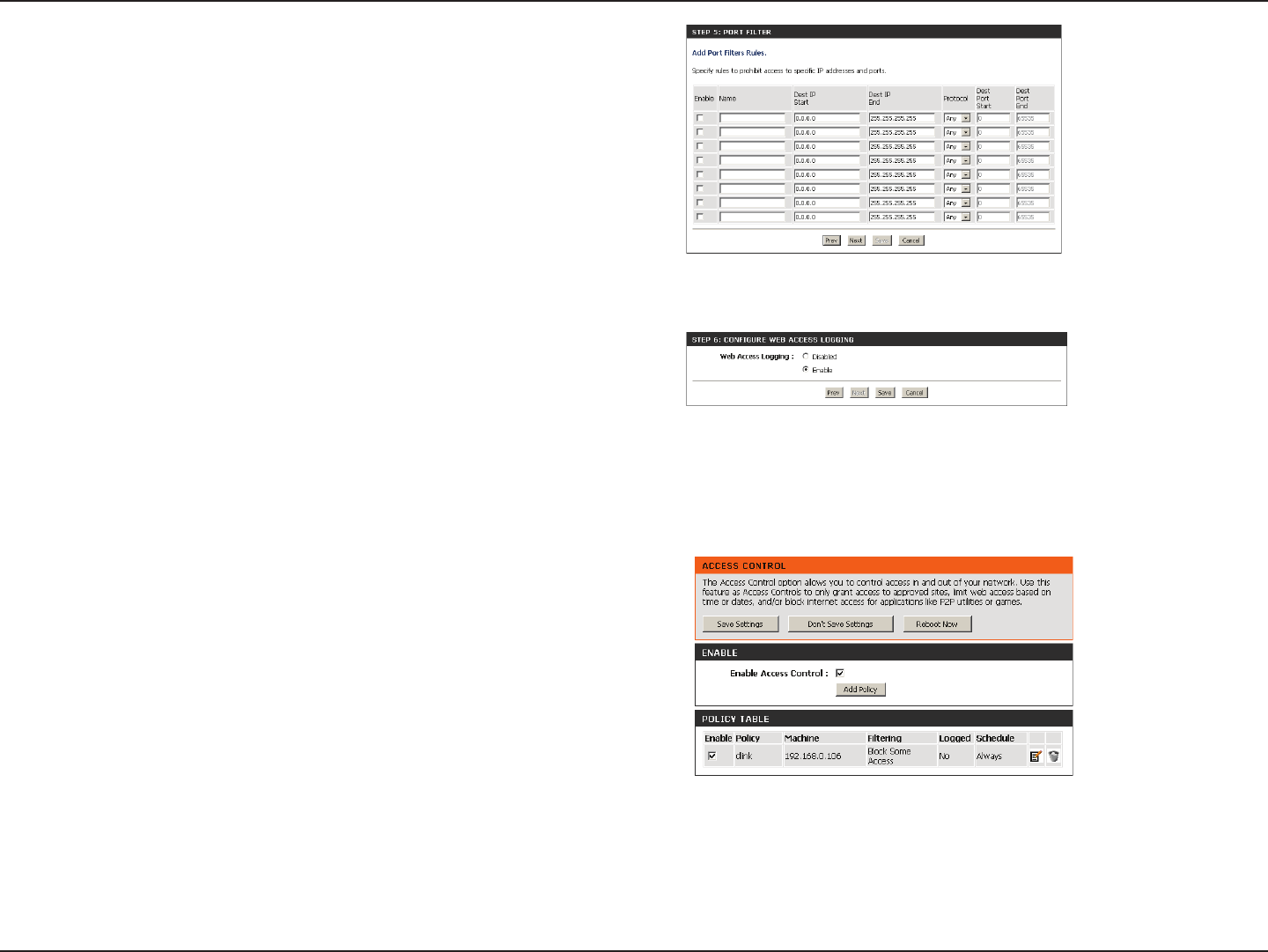
92D-Link DIR-850L User Manual
Section 3 - Conguration
Enter the rule:
Enable - Check to enable the rule.
Name - Enter a name for your rule.
Dest IP Start - Enter the starting IP address.
Dest IP End - Enter the ending IP address.
Protocol - Select the protocol.
Dest Port Start - Enter the starting port number.
Dest Port End - Enter the ending port number.
To enable web logging, click Enable.
Click Save to save the access control rule.
Your newly created policy will now show up under Policy Table.
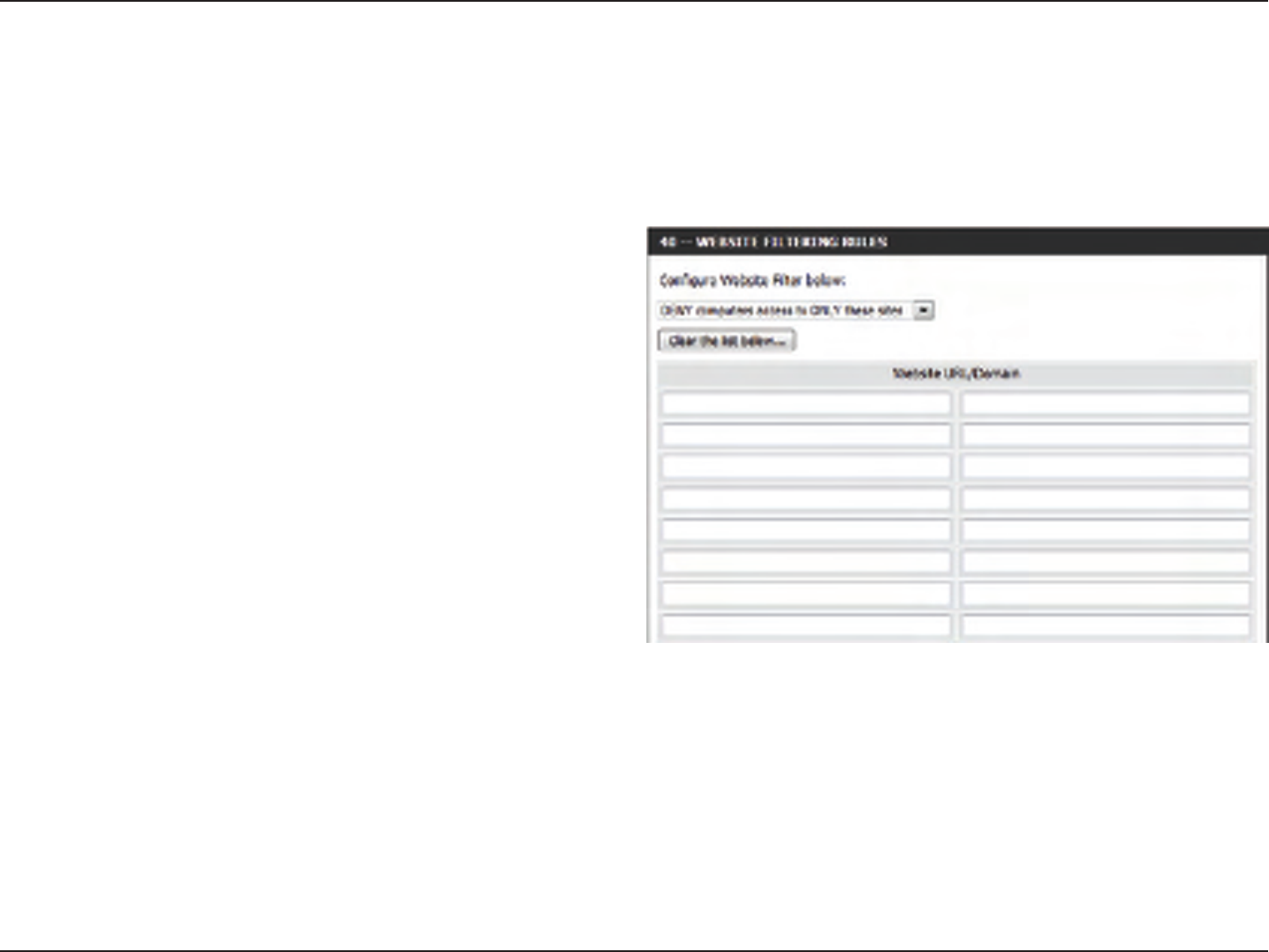
93D-Link DIR-850L User Manual
Section 3 - Conguration
Add Website
Filtering Rule:
Website URL/
Domain:
Website Filters
Select either DENY computers access to ONLY
these sites or ALLOW computers access to ONLY
these sites.
Enter the keywords or URLs that you want to allow
or block. Click Save Settings.
Website Filters are used to allow you to set up a list of Web sites that can be viewed by multiple users through the network.
To use this feature select to Allow or Deny, enter the domain or website and click Save Settings. You must also select Apply
Web Filter under the Access Control section.
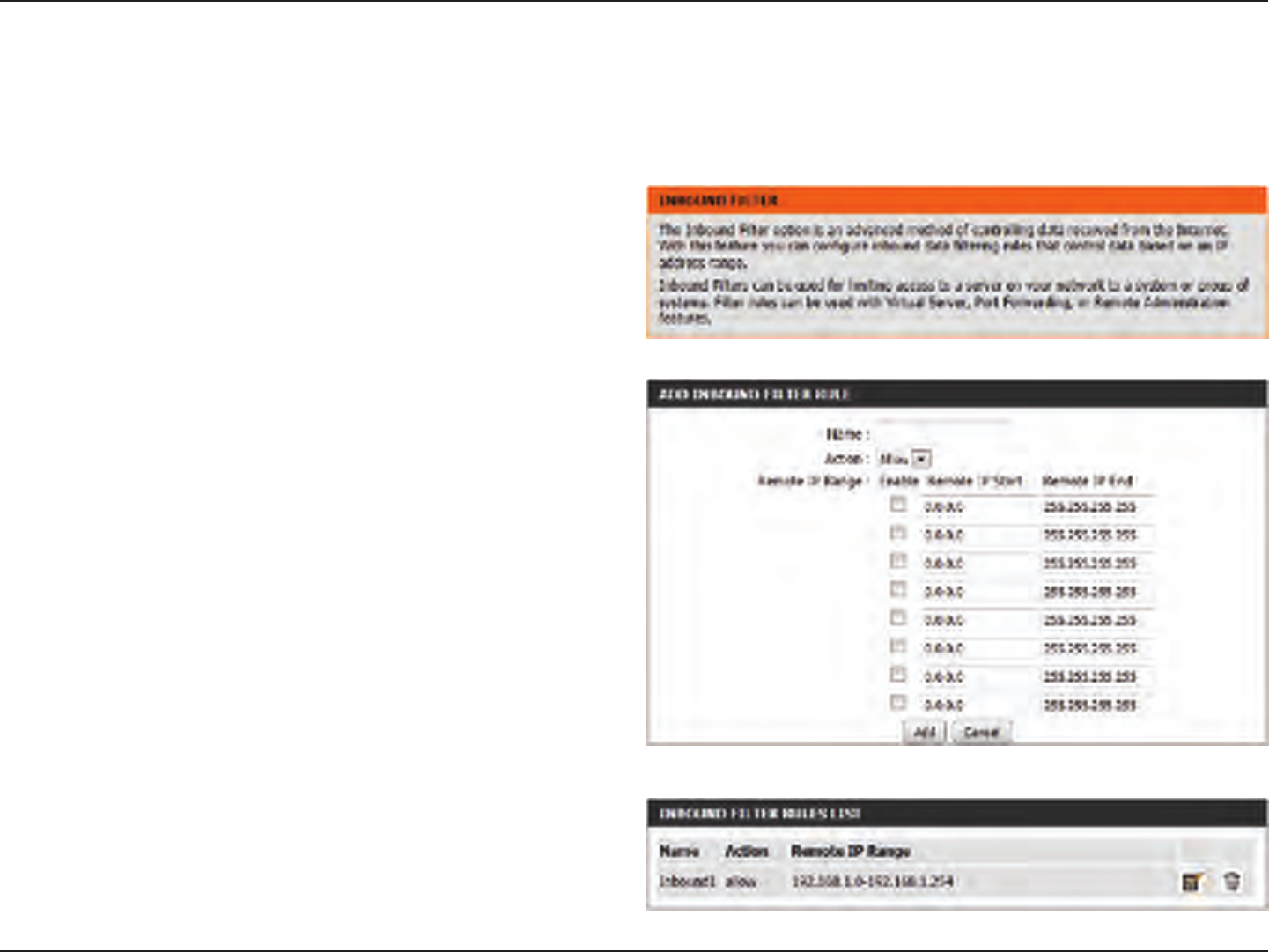
94D-Link DIR-850L User Manual
Section 3 - Conguration
Enter a name for the inbound lter rule.
Select Allow or Deny.
Check to enable rule.
Enter the starting IP address. Enter 0.0.0.0 if you
do not want to specify an IP range.
Enter the ending IP address. Enter 255.255.255.255
if you do not want to specify and IP range.
Click the Add button to apply your settings. You
must click Save Settings at the top to save the
settings.
This section will list any rules that are created. You
may click the Edit icon to change the settings or
enable/disable the rule, or click the Delete icon
to remove the rule.
Name:
Action:
Enable:
Remote IP Start:
Remote IP End:
Add:
Inbound Filter
Rules List:
The Inbound Filter option is an advanced method of controlling data received from the Internet. With this feature you can
congure inbound data ltering rules that control data based on an IP address range. Inbound Filters can be used with Virtual
Server, Port Forwarding, or Remote Administration features.
Inbound Filters
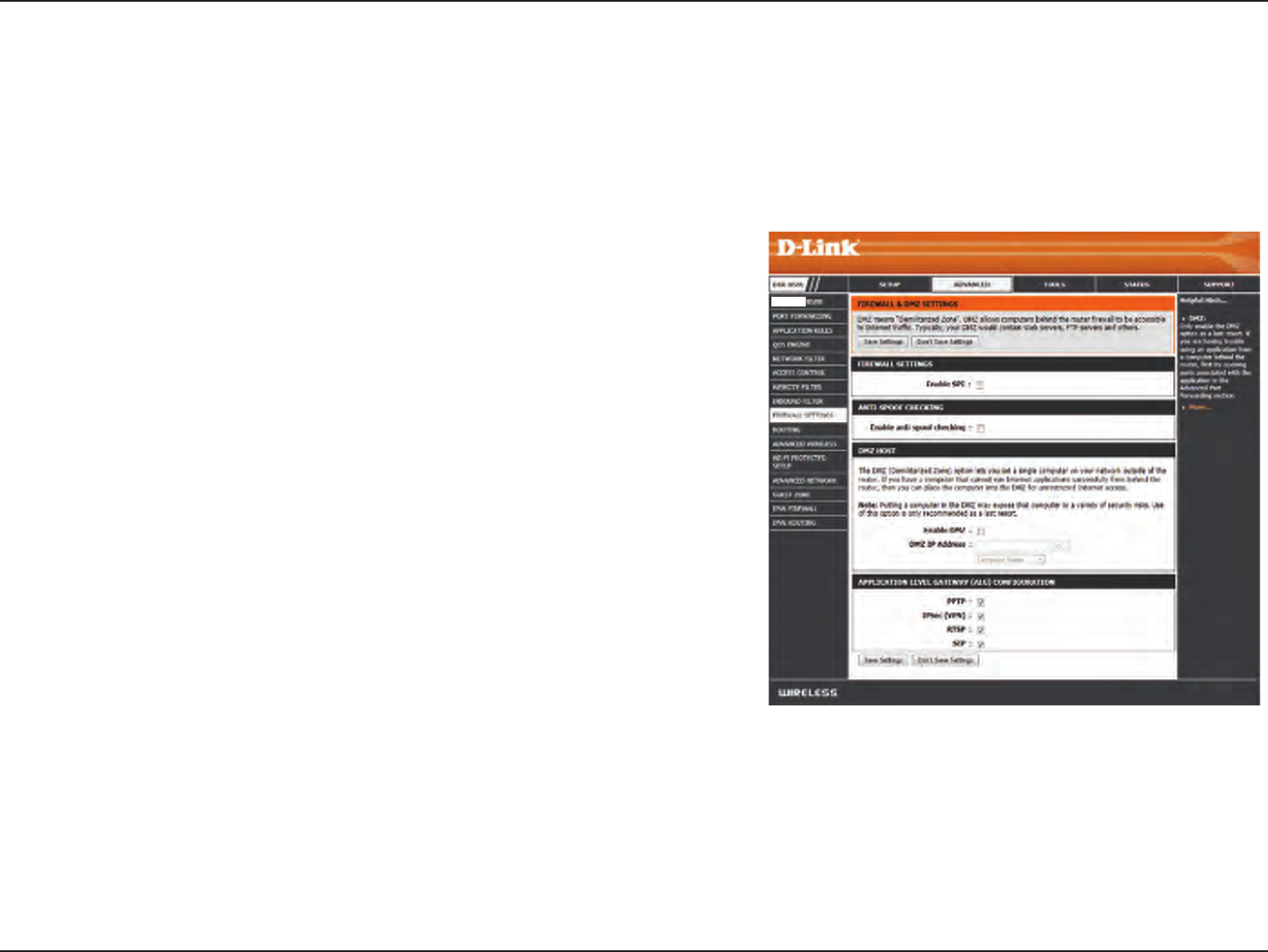
95D-Link DIR-850L User Manual
Section 3 - Conguration
SPI (Stateful Packet Inspection, also known as dynamic packet ltering)
helps to prevent cyber attacks by tracking more state per session. It
validates that the trac passing through the session conforms to the
protocol.
Enable this feature to protect your network from certain kinds of
“spoong” attacks.
Enable SPI:
Anti-Spoof Check:
Firewall Settings
A rewall protects your network from the outside world. The DIR-850L oers a rewall type functionality. The SPI feature helps
prevent cyber attacks. Sometimes you may want a computer exposed to the outside world for certain types of applications.
If you choose to expose a computer, you can enable DMZ. DMZ is short for Demilitarized Zone. This option will expose the
chosen computer completely to the outside world.
DIR-850L
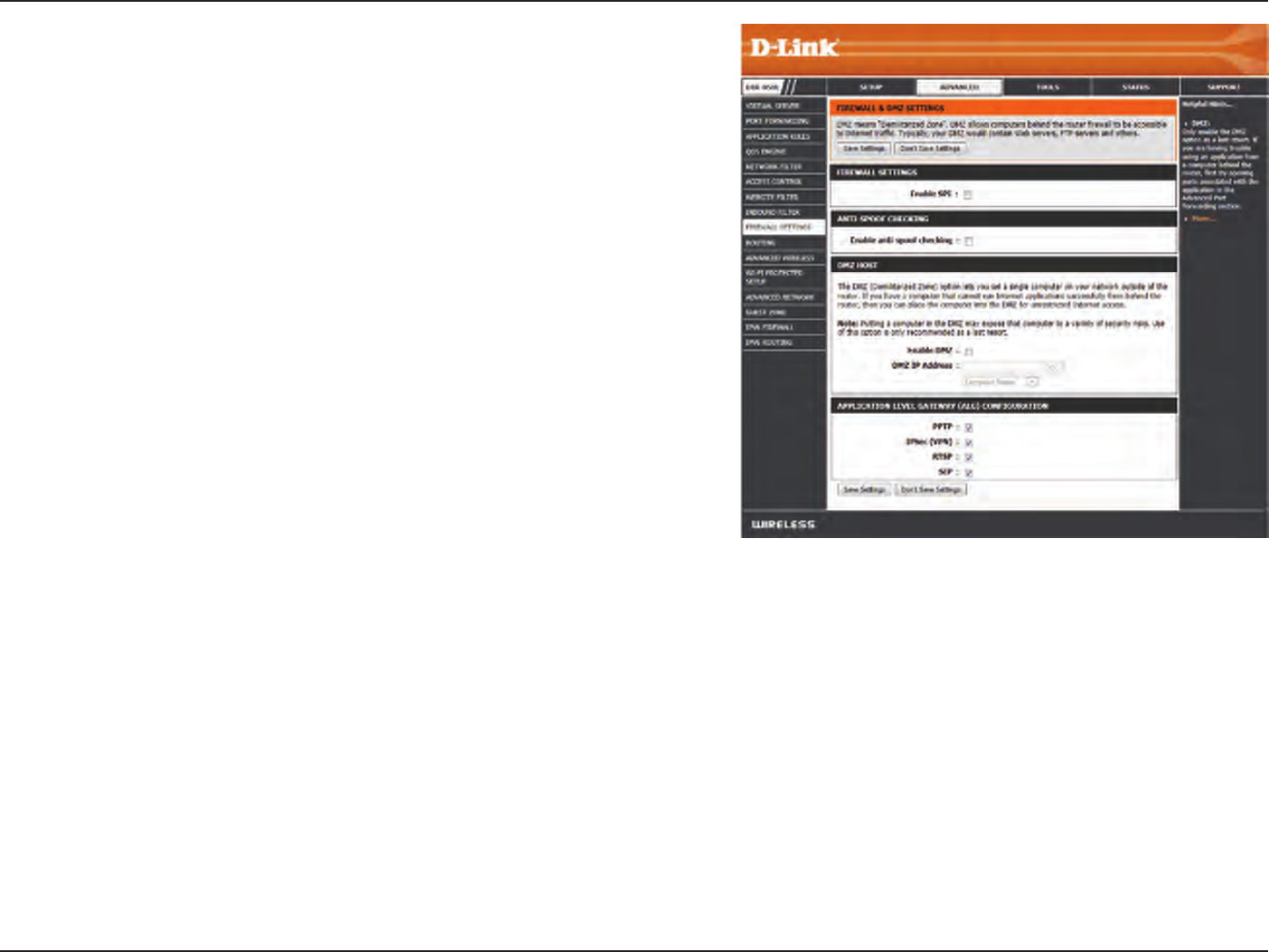
96D-Link DIR-850L User Manual
Section 3 - Conguration
DMZ IP Address:
PPTP:
IPSEC (VPN):
RTSP:
SIP:
Specify the IP address of the computer on the LAN that you want to
have unrestricted Internet communication. If this computer obtains
it’s IP address automatically using DHCP, be sure to make a static
reservation on the Setup > Network Settings page so that the IP
address of the DMZ machine does not change.
Allows multiple machines on the LAN to connect to their corporate
network using PPTP protocol.
Allows multiple VPN clients to connect to their corporate network
using IPSec. Some VPN clients support traversal of IPSec through
NAT. This ALG may interfere with the operation of such VPN clients.
If you are having trouble connecting with your corporate network,
try turning this ALG o. Please check with the system administrator
of your corporate network whether your VPN client supports
NAT traversal.
Allows application that uses Real Time Streaming Protocol to receive
streaming media from the Internet. QuickTime and Real Player are
some of the common applications using this protocol.
Allows devices and applications using VoIP (Voice over IP) to
communicate across NAT. Some VoIP applications and devices have
the ability to discover NAT devices and work around them. This ALG
may interfere with the operation of such devices. If you are having
trouble making VoIP calls, try turning this ALG o.
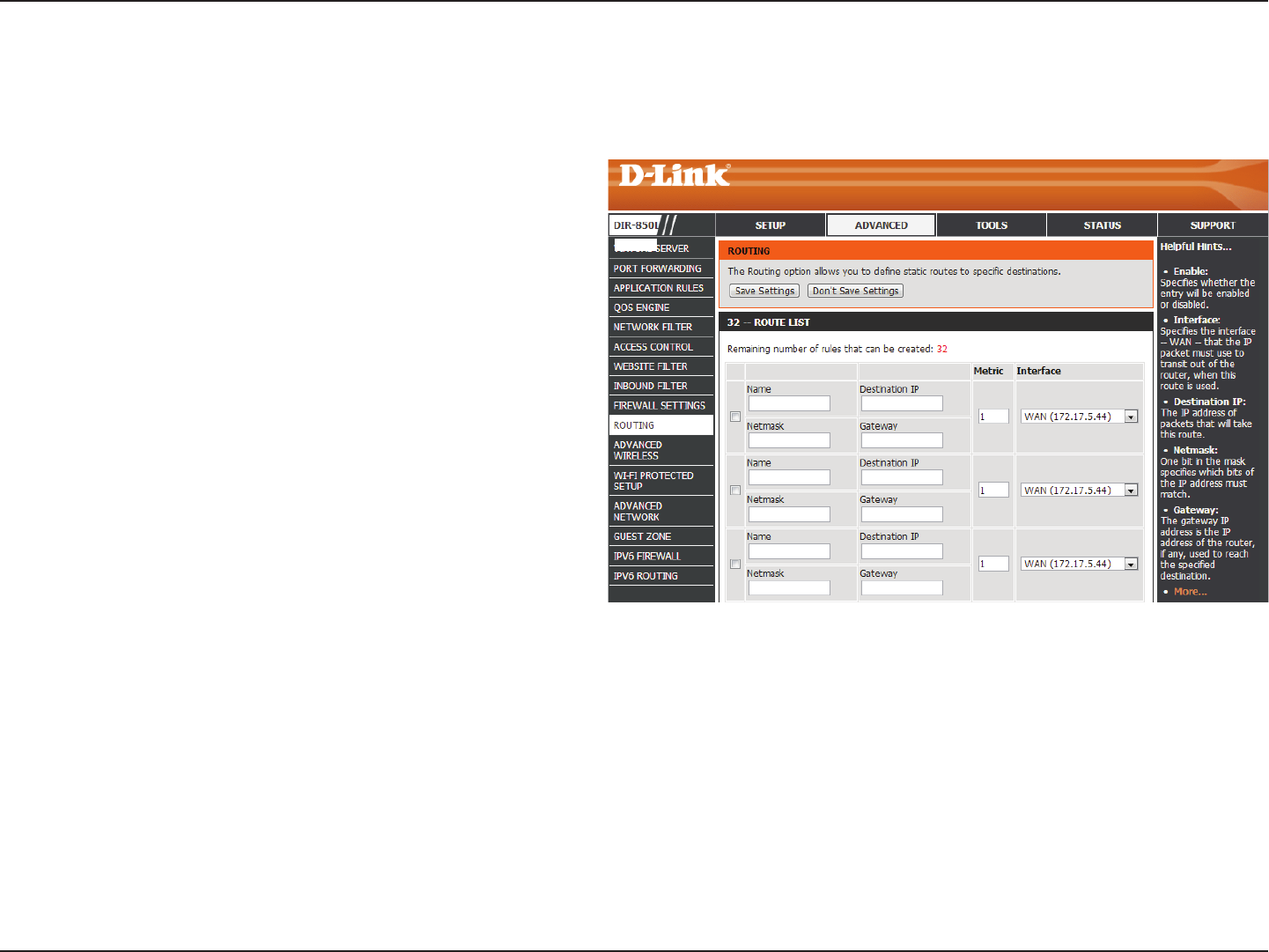
97D-Link DIR-850L User Manual
Section 3 - Conguration
Enter a name for your route.
Enter the IP address of packets that will take this
route.
Enter the netmask of the route, please note
that the octets must match your destination IP
address.
Enter your next hop gateway to be taken if this
route is used.
The route metric is a value from 1 to 16 that
indicates the cost of using this route. A value 1 is
the lowest cost and 15 is the highest cost.
Select the interface that the IP packet must use to
transit out of the router when this route is used.
Name:
Destination IP:
Netmask:
Gateway:
Metric:
Interface:
Routing
The Routing option is an advanced method of customizing specic routes of data through your network.
DIR-850L
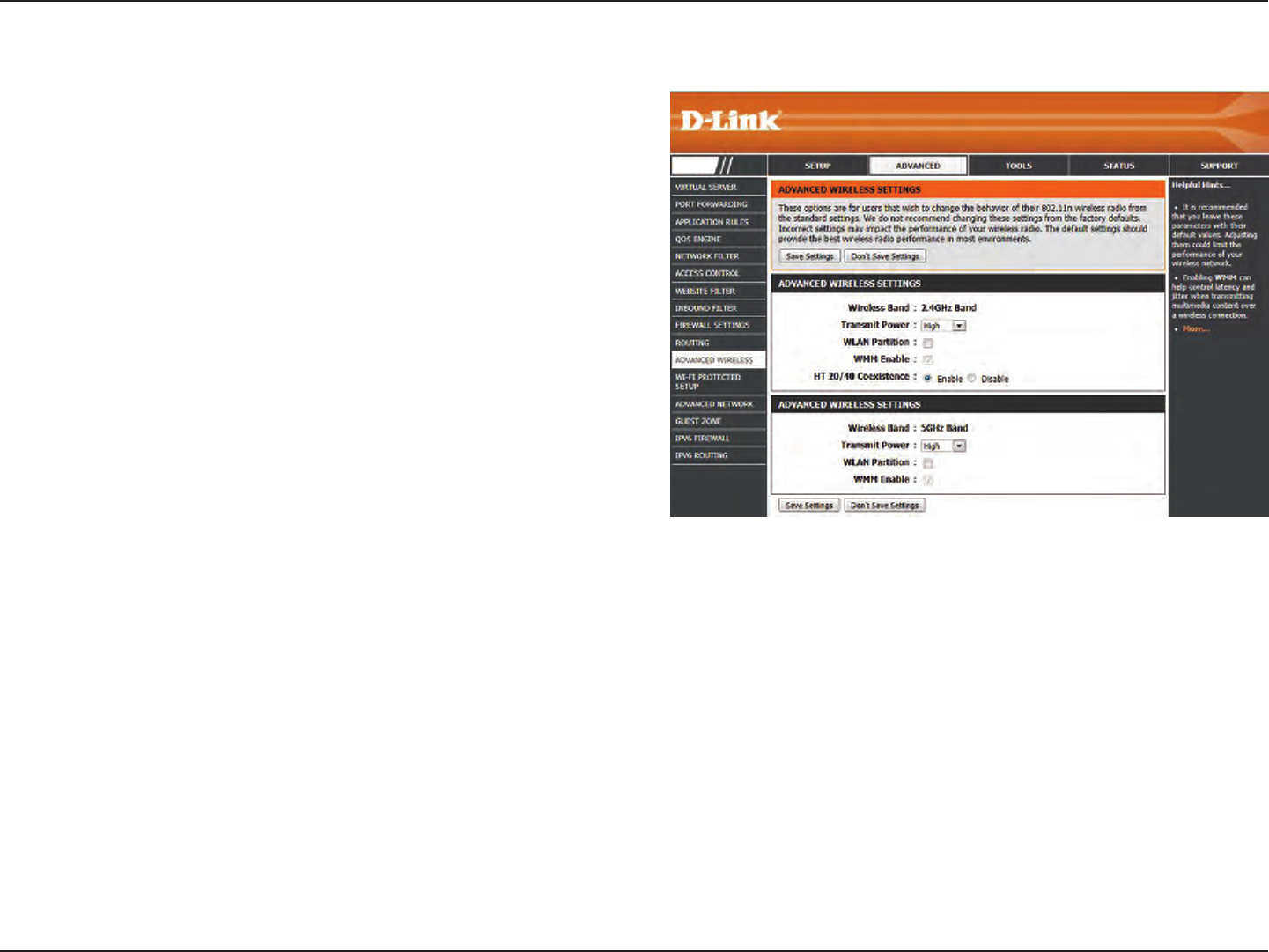
98D-Link DIR-850L User Manual
Section 3 - Conguration
Advanced Wireless
Set the transmit power of the antennas.
This enables 802.11d operation. 802.11d is a wireless
specication developed to allow implementation of
wireless networks in countries that cannot use the
802.11 standard. This feature should only be enabled
if you are in a country that requires it.
WMM is QoS for your wireless network. This will improve
the quality of video and voice applications for your
wireless clients.
Enable this option to reduce interference from
other wireless networks in your area. If the channel
width is operating at 40MHz and there is another
wireless network’s channel over-lapping and causing
interference, the router will automatically change to
20MHz.
Transmit Power:
WLAN Partition:
WMM Enable:
HT20/40 Coexistence:
DIR-850L
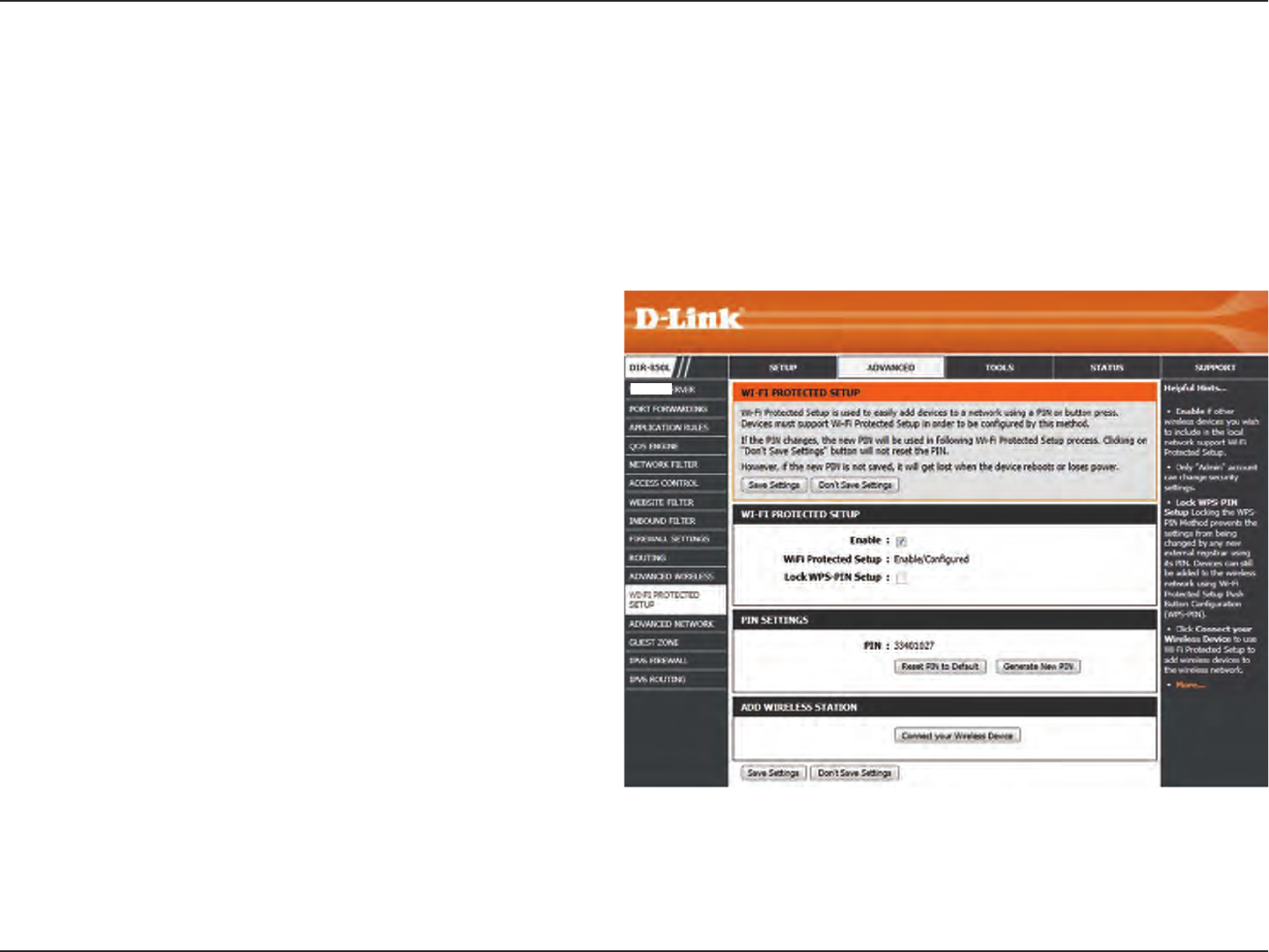
99D-Link DIR-850L User Manual
Section 3 - Conguration
Wi-Fi Protected Setup (WPS)
Enable the Wi-Fi Protected Setup feature.
Note: if this option is unchecked, the WPS button on the
side of the router will be disabled.
Tick this option to lock the congured wireless security
settings.
A PIN is a unique number that can be used to add
the router to an existing network or to create a new
network. Only the Administrator (“admin” account) can
change or reset the PIN.
Shows the current PIN.
Restore the default PIN of the router.
Create a random number that is a valid PIN. This
becomes the router’s PIN. You can then copy this PIN
to the user interface of the wireless client.
Enable:
Lock Wireless
Security Settings:
PIN Settings:
Current PIN:
Reset PIN to
Default:
Generate New
PIN:
Wi-Fi Protected Setup (WPS) System is a simplied method for securing your wireless network during the “Initial setup” as well
as the “Add New Device” processes. The Wi-Fi Alliance (WFA) has certied it across dierent products as well as manufactures.
The process is just as easy as pressing a button for the Push-Button Method or correctly entering the 8-digit code for the Pin
Code Method. The time reduction in setup and ease of use are quite benecial, while the highest wireless Security setting of
WPA2 is automatically used.
DIR-850L

100D-Link DIR-850L User Manual
Section 3 - Conguration
This Wizard helps you add wireless devices to the wireless network.
The wizard will either display the wireless network settings to guide you through manual conguration, prompt you to enter the
PIN for the device, or ask you to press the conguration button on the device. If the device supports Wi-Fi Protected Setup and has a
conguration button, you can add it to the network by pressing the conguration button on the device and then the on the router
within 120 seconds. The status LED on the router will ash three times if the device has been successfully added to the network.
There are several ways to add a wireless device to your network. A “registrar” controls access to the wireless network. A registrar
only allows devices onto the wireless network if you have entered the PIN, or pressed a special Wi-Fi Protected Setup button on the
device. The router acts as a registrar for the network, although other devices may act as a registrar as well.
Click to start the wizard and skip to page 48.
Add Wireless
Station:
Add Wireless
Device Wizard:
You can also simply press the WPS button on the side of the router, and then press the WPS
button on your wireless client to automatically connect without logging into the router.
Refer to page 130 for more information.
WPS Button
WPS Button